
- About the Doctors
- Hearing Aids
- Oticon Hearing Aids
- Phonak Hearing Aids
- Widex Hearing Aids
- Hearing News
- Schedule Appointment


SCHEDULE YOUR IN-HOME VISIT
Serving westchester, nyc, queens & the bronx.

THE VISITING AUDIOLOGISTS
“hearing made easy”.

HEARING SERVICES
Offering a wide range of professional services, celebrating 10 years.
Call us today (914) 420-0064 , or fill out our online contact form.
Our Services
Our services range from hearing tests and heading aids, to aural rehabilitation.
Schedule an In-Home Visit
We make scheduling and appointment convenient and easy, we come to you.
Schedule Now
The Visiting Audiologists Celebrating 10 Years
Our mission is to improve the quality of life for individuals with hearing loss by pairing high quality hearing devices with convenient, at home services by licensed Doctors of Audiology.
Eliminating the restraints of a traditional office increases scheduling flexibility and decreases costs. This allows for savings to be passed along to the patient, as well as at home service that is truly centered on patient.
The Visiting Audiologists use state of the art equipment to perform at home hearing testing, hearing aid consultations and hearing aid fittings.
Areas We Service
For your convenience, our in-home service is available for the following areas in Westchester County and New York City. To set up your in-home visit, simply click the link below to our online form, or call us at (914) 420-0064 .
1 Westchester County
2 The Bronx
3 Manhattan

How a Home Hearing Test Works
We show you the benefits that advanced technology can provide.

Schedule and appointment with us, we make the process fast and easy. We come to you.

In-Home Visit
A convenient doctor visit at home where we check your ears for wax, then conduct a comprehensive hearing exam.

Demonstration
Based on your results, we program different hearing aid options to conduct an in-home demonstration.

New Hearing Aids
We take measurements of your ears to order your hearing aids which are delivered directly to you.
I recently purchased hearing aids from the Visiting Audiologists. After searching the internet and reviewing all of the different options, I decided on James’ service because of the flexibility which fit into my busy work schedule. James has come to my house in the evening and on weekends to adjust my hearing aids. I highly recommend this service to anyone in the market for hearing aids.
- Nick P. Larchmont, NY
Schedule your appointment with us today.
To set up your in-home visit, simply fill out our online form , or call us at (914) 420-0064 .
The Visiting Audiologists pair convenient, at home service with high quality hearing instruments to improve patient care. Eliminating the restraints of a traditional office increases scheduling flexibility and decreases costs. This allows for savings to be passed along to the patient, as well as at home service that is truly patient centered.
- Patient Form
The Visiting Audiologists Call us today (914) 420-0064 Contact Us
Copyright © 2023 The Visiting Audiologists | All Rights Reserved | Website by intox Creative
- myPhonak Login to your profile, up-to-date information surrounding your hearing needs
- Professional Login Get enhanced service and support from, instantly share evidence and literature with your clients & colleagues.
Find a hearing care specialist near you
Are you looking for help with hearing loss or to check your hearing? Do you need audiological care? Or, are you interested in where to get a hearing aid? We can help you find a hearing care specialist in your area.
Get Started
Enter an address, ZIP code, city or state name above to search for a hearing care provider.
Thank you for your appointment request.
A member of Phonak Customer Care Department will follow up with you as soon as possible. If you need to contact us immediately, please call us.
Please correct all errors and submit again.
Congratulations on taking the first step
Congratulations! You have just taken the first step in improving your hearing health. A hearing care professional can help you find a solution that fits your lifestyle.
Now that you have taken the first step, things can start to happen! Together with a hearing care professional, we can guide you on your journey to better hearing and make sure you get the best solution for your lifestyle
What to expect when you visit a Hearing Care Professional?
1. you talk.
On your first visit, you do the talking and we’ll do the listening! We want to hear about how your hearing has changed and understand the challenges you’re facing. Once we do that, we can decide what steps to take next.
2. We Listen
After hearing about your challenges, the next step is a hearing test, which allows us to understand what you can and can’t hear. Once your hearing levels have been established, it becomes eager to figure out what solutions will be best for you, when paired with the struggles you’ve described in your everyday life.
3. Let’s Decide
Taking into account things like your family, work and social life, together we can decide what might be a good solution for you. It’s important that we work together to find a solution that is going to work for your unique lifestyle.
4. Adjusting
Our role doesn’t stop after you’ve decided on a solution. Hearing aids needs to fine tuned to help you hear your best in all situations, and we work to make sure they are customized to fit your needs.
Better hearing begins here
Fill out the form below to be connected with this Phonak hearing health care provider.
*Required information
- Yes, 2 years old or less
- Yes, 3 years old
- Yes, 4 years old
- Yes, more than 4 years old
We never sell any personal information you provide to us. By completing this form, you agree to our Privacy Policy and Terms of Use .
Loading Results
Finding hearing care professionals near this location
Share the provider
- Global Locations
- Sonova group
- Hear the World
- Facebook for Professionals
- Terms of Use
- Terms & Conditions
- Repairs Terms & Conditions
- Privacy Policy
- Cookie Policy Notice
- Certificates
- Prescription Hearing Aids
Phonak – A Sonova brand

- Why Beltone
- I'm a Caregiver
- Book an Appointment
- Online Hearing Test
What Can We Help You Find?
Quick links.
- Find a Beltone Office
Start a Chat
- Buy Supplies Online
- Guided Help
- Help Center

Find the Beltone office nearest to you!
Experience more of life better hearing.
Living with hearing loss doesn't need to feel difficult or overwhelming.
With hearing aids, you can continue to live life to the fullest and hear what matters the most to you.
Someone You Can Trust Every Step of the Way
Visit a hearing professional at Beltone Hearing Care Center for a free consultation.
Better Hearing Starts Right Here
Take our at-home hearing test experience and we'll send your results straight to your local Beltone ( click here to learn more about our assessment ). Or take our lifestyle assessment to discover the right hearing aids for you.
Made for You Beltone Serene
For hearing aids that are our best yet at helping you hear in noisy situations, choose Beltone Serene™—tiny but powerful hearing aids made for everyday life.
40k Five-Star Reviews
Google Customer Reviews, Nationwide
Newsletter Sign Up
Stay up to date every step of the way. Sign up and be the first to hear about the latest hearing technology, deals, news and more.
You are now leaving Beltone.com
You are now leaving Beltone.com and heading to
Choose continue if you'd like to proceed.

- Ear Wax Removal
- Hearing Tests
- Hearing Aid Reprogramming
- Free Online Hearing Test
- Full Product Range
- Phonak Hearing Aids
- Request an appointment
- Your Enquiry
The Benefits of a Home Visit Audiologist
Posted on May 30, 2020 - Hearing Aid Advice , Hearing Aids
With the corona virus pandemic still affecting people across the globe, audiologists are concerned about how they can continue treating hearing loss while protecting customers from potential exposure.
The hearing care industry has effectively closed their doors in the last few months, many shut up shop before the official lock down was announced in the UK.
Our Audiologists’ response to home visit hearing care
The biggest cause of hearing loss is age related and therefore the hearing care profession deals with the most susceptible people to getting severely ill with Corona Virus.
Even if customers are not in an at-risk group, there are still risks present for everyone involved with the hearing check, hearing aid programming and ear wax removal .
Guidelines for Hearing Care at home
Following new guidelines from our regulators the hearing care sector is tentatively opening up again in the UK.
Before you book a hearing test you will be asked the following question:
I. Do you or anyone in household have coronavirus? II. Do you have a new continuous cough III. Do you have a high temperature (37.8oC or over?) IV. Does anyone in your household have a new, continuous cough or high temperature?
If the answer is yes to any of these questions you will be unable to book a hearing test.
The audiologist will also discuss whether you have a room large enough for social distancing (2m apart) and PPE requirements.
What can I expect from a home visit hearing assessment?
An audiologist is able to perform a full hearing assessment in your home the same as you would expect in a clinic. The only difference being that in a clinic you often will be placed in soundproof booth for the hearing test. This may be necessary in a noisy clinic/shop high street location where the ambient noise could be above 35 decibels (above this level a hearing test is not recommended). In the home we can usually find a quiet room where an accurate hearing test can be performed.
Once audiometry (hearing test) has been performed an audiologist should explain your results to you. If you are a candidate for amplification with hearing aids an audiologist should show you the different styles of hearing aids available.
Benefits of a home visit Audiologist
Before you choose a hearing aid you will most likely like a demonstration to hear what it sounds like. Your own home is an ideal environment for this. You can experience the sound in the rooms where you spend much of your time, you can try the hearing aids with your own TV, radio or stereo. People with hearing loss often find kitchens with loud appliances and lots of hard surfaces which cause reverberation, hard to hear conversation in. This is a great environment to demonstrate the advanced features of hearing aids, such as noise reduction.
A home visit hearing test saves the customer from travel and waiting rooms. If the audiologist is running behind schedule, though inconvenient, you do not need to worry about social distancing in waiting rooms or that your parking meter will expire.
Get the Hearing Care and Treatment Needed At-Home
As you can see, booking a home visit with your audiologist offers an array of benefits. Just remember, during this visit, we still need to take steps to ensure everyone is safe.
If you would like to schedule an appointment, contact us , or use our secure “book online” feature. Our team is dedicated to helping ensure you get the care and treatment necessary to ensure your ongoing quality of life.
Why Choose Sound Hearing?
soundhearing.org is a company that works within and around the M25.
Our purpose is to provide high quality, transparent and affordable hearing care.
Our website outlines every product available on the market from the main hearing aid manufacturers. We provide detailed descriptions of each hearing aid and its features allowing you to compare hearing aids from each range.
Unlike many high street providers, we are not owned (partially or wholly) by a particular manufacturer, which is why we can offer you the choice of hundreds of hearing aids.
To help you make the right choice, feel free to contact us for advice and to answer any questions you may have. An audiologist can also come to your home free of charge in order to assess your hearing and your listening needs.
Appointments at Mayo Clinic
Hearing aids: how to choose the right one.
Many types of hearing aids exist. So which is best for you? Find out what to consider when choosing a hearing aid.
Perhaps you've thought about getting a hearing aid, but you're worried about how it will look or whether it will really help. It may help ease your concerns to know more about:
- The hearing aid options available to you
- What to look for when buying a hearing aid
- How to get used to a hearing aid
Hearing aids can't restore normal hearing. They can improve your hearing by amplifying sounds that you've had trouble hearing.
How hearing aids work
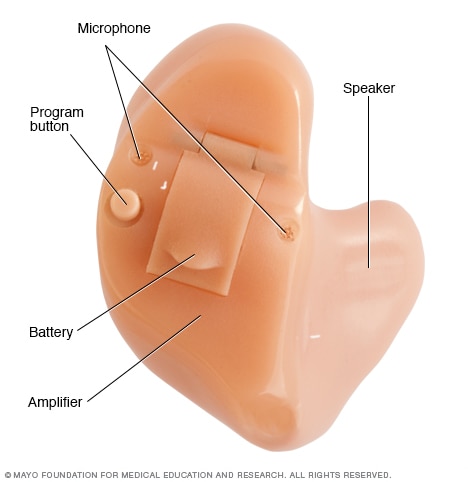
Hearing aid parts
Hearing aids use these parts to help pick up and amplify sound from your environment and channel it into your ear: microphone (detects the sound), amplifier (makes the sound stronger), speaker (sends the sound into your ear so that you can hear it), battery (provides power to the electronic parts). Some hearing aids have a volume control (increases or decreases the volume of the sound) or a program button.
All hearing aids use the same basic parts to carry sounds from the environment into your ear and make them louder. Most hearing aids are digital, and all are powered with a traditional hearing aid battery or a rechargeable battery.
Small microphones collect sounds from the environment. A computer chip with an amplifier converts the incoming sound into digital code. It analyzes and adjusts the sound based on your hearing loss, listening needs and the level of the sounds around you. The amplified signals are then converted back into sound waves and delivered to your ears through speakers, sometimes called receivers.
Hearing aid styles
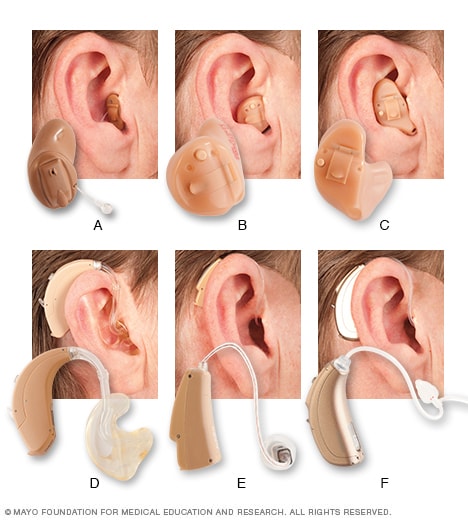
Many choices of hearing aid styles are available, including the following: completely in the canal (A), in the canal (B), in the ear (C), behind the ear (D), receiver in canal or receiver in the ear (E), and open fit (F).
Hearing aids vary a great deal in price, size, special features and the way they're placed in your ear.
The following are common hearing aid styles, beginning with the smallest, least visible in the ear. Hearing aid designers keep making smaller hearing aids to meet the demand for a hearing aid that is not very noticeable. But the smaller aids may not have the power to give you the improved hearing you may expect.
Completely in the canal (CIC) or mini CIC
A completely-in-the-canal hearing aid is molded to fit inside your ear canal. It improves mild to moderate hearing loss in adults.
A completely-in-the-canal hearing aid:
- Is the smallest and least visible type
- Is less likely to pick up wind noise
- Uses very small batteries, which have shorter life and can be difficult to handle
- Often doesn't include extra features, such as volume control or a directional microphone
- Is susceptible to earwax clogging the speaker
In the canal
An in-the-canal (ITC) hearing aid is custom molded and fits partly in the ear canal. This style can improve mild to moderate hearing loss in adults.
An in-the-canal hearing aid:
- Is less visible in the ear than larger styles
- Includes features that won't fit on completely-in-the-canal aids, but may be difficult to adjust due to its small size
An in-the-ear (ITE) hearing aid is custom made in two styles — one that fills most of the bowl-shaped area of your outer ear (full shell) and one that fills only the lower part (half shell). Both are helpful for people with mild to severe hearing loss and are available with directional microphones (two microphones for better hearing in noise).
An in-the-ear hearing aid:
- Includes features that don't fit on smaller style hearing aids, such as a volume control
- May be easier to handle
- Uses a larger battery for longer battery life, with several options for rechargeable batteries
- May pick up more wind noise than do smaller devices
- Is more visible in the ear than smaller devices
Behind the ear
A behind-the-ear (BTE) hearing aid hooks over the top of your ear and rests behind the ear. A tube connects the hearing aid to a custom earpiece called an ear mold that fits in your ear canal. This type is appropriate for people of all ages and those with almost any type of hearing loss.
A behind-the-ear hearing aid:
- Traditionally has been the largest type of hearing aid, though some newer mini designs are streamlined and barely visible
- Has directional microphones
- Is capable of more amplification than are other styles
- May pick up more wind noise than do other styles
- May be available with a rechargeable battery
Receiver in canal or receiver in the ear
The receiver-in-canal (RIC) and receiver-in-the-ear (RITE) styles are similar to a behind-the-ear hearing aid with the speaker or receiver that sits in the ear canal. A tiny wire, rather than tubing, connects the piece behind the ear to the speaker or receiver.
A receiver-in-canal hearing aid:
- Typically has a less visible behind-the-ear portion
- Has manual control options
- May be available with rechargeable battery
An open-fit hearing aid is a variation of the behind-the-ear hearing aid with a thin tube or the receiver-in-the-canal or receiver-in-the-ear hearing aid with an open dome in the ear. This style keeps the ear canal very open, allowing for low-frequency sounds to enter the ear naturally and for high-frequency sounds to be amplified through the hearing aid. This makes the style a good choice for people with better low-frequency hearing and mild to moderate high-frequency hearing loss.
An open-fit hearing aid:
- Is often visible
- Doesn't plug the ear like the in-the-ear hearing aid styles, often making your own voice sound better to you
- May be more difficult to insert into the ear due to the noncustom dome
Additional features
Some optional features of hearing aids improve your ability to hear in specific situations:
- Noise reduction. All hearing aids have some amount of noise reduction available. The amount of noise reduction varies. Some also offer wind noise reduction.
- Directional microphones. These are aligned on the hearing aid to provide for improved pickup of sounds coming from in front of you with some reduction of sounds coming from behind or beside you. Some hearing aids are capable of focusing in one direction. Directional microphones can improve your ability to hear when you're in an environment with a lot of background noise.
- Rechargeable batteries. Some hearing aids have rechargeable batteries. This can make maintenance easier for you by eliminating the need to regularly change the battery.
- Telecoils. Telecoils make it easier to hear when talking on a telecoil-compatible telephone. The telecoil reduces the sounds from your environment and picks up the sounds from the hearing-aid-compatible telephone. Telecoils also pick up signals from public induction loop systems that can be found in some churches and theaters, allowing you to hear a speaker, play or movie better.
- Wireless connectivity. Increasingly, hearing aids can wirelessly interface with certain Bluetooth-compatible devices, such as cellphones, music players, computers and televisions. You may need to use an intermediary device to pick up the phone or other signal and send it to the hearing aid.
- Remote controls. Some hearing aids come with a remote control, so you can adjust features without touching the hearing aid. Some hearing aids connect wirelessly to a cellphone and have a cellphone application that allows use of the cellphone as a remote control.
- Direct audio input. This feature allows you to plug in to audio from a television, a computer or a music device with a cord.
- Variable programming. Some hearing aids can store several preprogrammed settings for various listening needs and environments.
- Synchronization. For an individual with two hearing aids, the aids can be programmed to function together so that adjustments made to a hearing aid on one ear (volume control or program changes) will also be made on the other aid, allowing for simpler control.
Before you buy
When looking for a hearing aid, explore your options to understand what type of hearing aid will work best for you. Also:
- Get a checkup. See your doctor to rule out correctable causes of hearing loss, such as earwax or an infection. And have your hearing tested by a hearing specialist (audiologist).
- Seek a referral to a reputable audiologist. If you don't know a good audiologist, ask your doctor for a referral. An audiologist will assess your hearing, help you choose the most appropriate hearing aid and adjust the device to meet your needs. If you have hearing loss in both ears, you will get best results with two hearing aids.
- Ask about a trial period. You can usually get a hearing aid with a trial period. It may take you a while to get used to the device and decide if it's right for you. Have the dispenser put in writing the cost of a trial, whether this amount is credited toward the final cost of the hearing aid and how much is refundable if you return the hearing aid during the trial period.
- Think about future needs. Ask whether the hearing aid you've chosen is capable of increased power so that it will still be useful if your hearing loss gets worse. Hearing aids do not function indefinitely, but they should last about five years.
- Check for a warranty. Make sure the hearing aid includes a warranty that covers parts and labor for a specified period. Some dispensers may include office visits or professional services in the warranty.
- Beware of misleading claims. Hearing aids can't restore normal hearing or eliminate all background noise. Beware of advertisements or dispensers who claim otherwise.
Plan for the expense. The cost of hearing aids varies widely — from about $1,500 to more than a few thousand dollars each. Professional fees, remote controls, hearing aid accessories and other hearing aid options may cost extra. Talk to your audiologist about your needs and expectations.
Some private insurance policies cover part or all of the cost of hearing aids — check your policy to be sure. Medicare doesn't cover the cost of hearing aids for adults. In many states, private insurers are required to pay for hearing aids for children. Medical assistance covers hearing aids in most states. If you're a veteran, you may be able to get your hearing aid at no cost through the U.S. Department of Veterans Affairs (VA).
Getting used to your hearing aid
Getting used to a hearing aid takes time. You'll likely notice that your listening skills improve gradually as you become accustomed to amplification. Even your own voice sounds different when you wear a hearing aid.
When first using a hearing aid, keep these points in mind:
- Hearing aids won't return your hearing to normal. Hearing aids can't restore normal hearing. They can improve your hearing by amplifying soft sounds.
- Allow time to get used to the hearing aid. It takes time to get used to your new hearing aid. But the more you use it, the more quickly you'll adjust to amplified sounds.
- Practice using the hearing aid in different environments. Your amplified hearing will sound different in different places.
- Seek support and try to stay positive. A willingness to practice and the support of family and friends help determine your success with your new hearing aid. You may also consider joining a support group for people who have hearing loss or are new to hearing aids.
- Go back for a follow-up. Specialists may include the cost of one or more follow-up visits in their fees. It's a good idea to take advantage of this for any adjustments and to ensure that your new hearing aid is working for you as well as it can.
Your success with hearing aids will be helped by wearing them regularly and taking good care of them. In addition, an audiologist can tell you about new hearing aids and devices that become available. He or she can also help you make changes to meet your needs. The goal is that, in time, you find a hearing aid you're comfortable with and that enhances your ability to hear and communicate.
- Mayo Clinic Minute: Hearing aids not 'one-size-fits-all'
Cynthia Hogan, Ph.D., Audiology, Mayo Clinic
Dr. Hogan: "Hearing aids, because they're digital, can be adjusted over a wide range of hearing loss."
That's one reason why audiologist Dr. Cynthia Hogan says with these devices, one-size-fits-all does not apply.
Dr. Hogan: "So there isn't one best hearing aid for older people versus younger people. We try to choose a hearing aid that's going to fit the person's needs."
Important decisions include whether the device will have rechargeable batteries or ones that need to be replaced, and whether the hearing aid will sit behind or in the ear.
Dr. Hogan: "This is a full-shell, in-the-ear hearing aid. And, so, it fits all into the ear."
One of the benefits of this device is wearers can answer and listen to a phone call as they have their whole life. Some hearing aids can even connect to a person's cellphone.
Dr. Hogan: "They can watch videos or things like that directly from their phone to their hearing aid."
An audiologist like Dr. Hogan can help you sort through all the options and create a personal solution for your hearing problem.
For the Mayo Clinic News Network, I'm Jeff Olsen.
There is a problem with information submitted for this request. Review/update the information highlighted below and resubmit the form.
From Mayo Clinic to your inbox
Sign up for free and stay up to date on research advancements, health tips, current health topics, and expertise on managing health. Click here for an email preview.
Error Email field is required
Error Include a valid email address
To provide you with the most relevant and helpful information, and understand which information is beneficial, we may combine your email and website usage information with other information we have about you. If you are a Mayo Clinic patient, this could include protected health information. If we combine this information with your protected health information, we will treat all of that information as protected health information and will only use or disclose that information as set forth in our notice of privacy practices. You may opt-out of email communications at any time by clicking on the unsubscribe link in the e-mail.
Thank you for subscribing!
You'll soon start receiving the latest Mayo Clinic health information you requested in your inbox.
Sorry something went wrong with your subscription
Please, try again in a couple of minutes
- Weber PC. Hearing amplification in adults. https://www.uptodate.com/contents/search. Accessed Sept. 15, 2020.
- Hearing aids. National Institute on Deafness and Other Communication Disorders. https://www.nidcd.nih.gov/health/hearing/pages/hearingaid.aspx. Accessed Sept. 15, 2020.
- Flint PW, et al., eds. Hearing aid amplification. In: Cummings Otolaryngology: Head & Neck Surgery. 7th ed. Elsevier; 2021. https://www.clinicalkey.com. Accessed Sept. 15, 2020.
- How to find the right hearing aid for you. American Academy of Otolaryngology-Head and Neck Surgery. https://www.enthealth.org/be_ent_smart/how-to-find-the-right-hearing-aid-for-you/. Accessed Sept. 15, 2020.
- Rehabilitation and prosthetic services. U.S. Department of Veteran Affairs. https://www.prosthetics.va.gov/psas/Hearing_Aids.asp. Accessed Sept. 15, 2020.
- Age-related hearing loss. National Institute on Deafness and Other Communication Disorders. https://www.nidcd.nih.gov/health/hearing-aids. Accessed Sept. 15, 2020.
- Hogan CA (expert opinion). Mayo Clinic. Oct. 6, 2020.
Products and Services
- A Book: Mayo Clinic on Healthy Aging
- A Book: Mayo Clinic on Hearing and Balance
- Hearing loss
- How you hear
- Mayo Clinic Minute: Can you slow down age-related hearing loss?
- Mayo Clinic Minute: What is hearing loss?
- Opera Star's Surgery
Mayo Clinic does not endorse companies or products. Advertising revenue supports our not-for-profit mission.
- Opportunities
Mayo Clinic Press
Check out these best-sellers and special offers on books and newsletters from Mayo Clinic Press .
- Mayo Clinic on Incontinence - Mayo Clinic Press Mayo Clinic on Incontinence
- The Essential Diabetes Book - Mayo Clinic Press The Essential Diabetes Book
- Mayo Clinic on Hearing and Balance - Mayo Clinic Press Mayo Clinic on Hearing and Balance
- FREE Mayo Clinic Diet Assessment - Mayo Clinic Press FREE Mayo Clinic Diet Assessment
- Mayo Clinic Health Letter - FREE book - Mayo Clinic Press Mayo Clinic Health Letter - FREE book
- Hearing aids How to choose the right one
Let’s celebrate our doctors!
Join us in celebrating and honoring Mayo Clinic physicians on March 30th for National Doctor’s Day.
- Older Adults
- Professionals
- Explore NCOA.org
- Get Involved
- Best Hearing Aids
- Best OTC Hearing Aids
- Most Affordable Hearing Aids
- Best Medical Alert Systems
- Best Fall Detection Devices
- Life Alert Review
- Best Portable Oxygen Concentrator
- Best Mattress
- Best Mattress for Back Pain
- Best Adjustable Beds
- Best Walk-In Tubs
Find us on Social
A third party independently reviewed these products & services and may earn a commission…
A third party independently reviewed these products & services and may earn a commission from qualified purchases made through the links included. NCOA, however, does not receive a commission for purchases. If you find these resources useful, consider donating to NCOA .
10 Best Hearing Aids of March 2024: Expert Reviewed

- Jabra Enhance offers the all-around best hearing aids on the market based on our Reviews Team’s hands-on testing.
- 37.5 million people in the United States have hearing loss. That number is expected to almost double in the next four decades.
- The cost of hearing aids varies significantly and can range from $99 to $7,000 per pair (for context, the Jabra Enhance starts at $1,195). Factors influencing the cost of hearing aids include the manufacturer, features, style, fit, technology levels, and customization options.
- When shopping for hearing aids, some of the most important features to consider are your degree of hearing loss, Bluetooth capabilities, feedback suppression, and style. Some of the most popular hearing aid styles include completely-in-canal (CIC), in-the-canal (ITC), behind-the-ear (BTE), and in-the-ear (ITE).
Our Reviews Team recommends products and services we believe provide value in the lives of our readers. We’ve spent more than 5,000 hours conducting in-depth research on hearing aid devices to give you the most accurate hearing aid review. To make these selections, we:
- Consulted with audiologists and geriatric care experts
- Mystery shopped 18 brands
- Surveyed hundreds of hearing aid users
- Tested various models of hearing aids
- Interviewed experts in the field
- Read thousands of verified customer reviews

1,841,585 people helped this year
A quick look at the best hearing aids
- Jabra Enhance : Most Popular
- Audien : Most Affordable
- Phonak : Best for Severe Hearing Loss
- MDHearing : Most Feature Options
- Eargo : Best Invisible Fit
- Lexie : Most User-Friendly
- hear.com : Best In-Home Care
Whether you’re having dinner with friends or watching television at home, hearing loss can get in the way of your quality time, disrupt your ability to communicate and gather information effectively, and lessen your confidence in social settings. But the right hearing aid can enhance your hearing, and even protect your brain from cognitive decline , [1] National Institutes of Health. Hearing Aids Slow Cognitive Decline in People at High Risk. Found on the internet at: https://www.nih.gov/news-events/nih-research-matters/hearing-aids-slow-cognitive-decline-people-high-risk so you feel more comfortable and confident in all areas of your life. Our Reviews Team compared the best hearing aids for 2024 based on features, pricing, and customer care to help you make the right decision for your needs.
For our Reviews Team’s recommendations on the most budget-friendly hearing aids of the year, visit our list of the most affordable hearing aids we researched and tested.
How we research and review hearing aids

We only recommend hearing devices that we think will have a positive impact for our readers, so we began our testing process by reviewing hearing aid research. We also consulted with audiologists and geriatric care experts to better understand the research, the needs of people with hearing loss, and the hearing aid brands and models on the market.
We read thousands of hearing aid reviews on trusted third-party sites such as Better Business Bureau (BBB) and Trustpilot to understand customers’ experiences and where they think hearing aids are falling short. Next, we conducted a survey to discover what people love about their hearing aids, what features they use, and what their biggest challenges are.
We focused on brands that:
- Are widely available
- Have a range of prices
- Treat different types of hearing loss
- Offer a variety of features for different hearing concerns
Any time we recommend a hearing aid brand, we have our selections medically reviewed by an audiologist to examine the company, find the best model, and ensure every hearing aid on our list is appropriate for our readers’ needs.
Read more about our hearing aids review methodology.
The best hearing aid brands, as of March 2024
Best hearing aids of 2024.

Jabra Enhance earns “Our Top Pick” for the company’s combination of quality, over-the-counter devices and a commitment to ongoing customer service that includes support from an audiology team (specialists trained to treat hearing loss) if you purchase the premium package. All this together makes Jabra Enhance one of the best OTC hearing aids on the market.
- Battery: Rechargeable and disposable options
- Bluetooth capabilities: Yes
- Adjustment: Remote, phone app, or buttons on hearing aid
- Warranty and trial period: Jabra Enhance offers a 100-day risk-free trial period for all Jabra Enhance Select devices; one to three-year manufacturer’s warranty and loss-and-damage protection (depending on basic or premium package)
- Financing: Yes
Jabra Enhance focuses on giving customers full access to its audiology care team to ensure help is available. As a Jabra Enhance customer, you’ll get personalized, professional expertise—with no in-person visits to an office or hearing center—for a low price compared to other OTC hearing aids. Not every OTC hearing aid company has an audiology care team on staff for consultations.
Jabra Enhance offers an online hearing screening and a pre-purchase video consultation with a member of the audiology care team. The company’s devices can also be paired with a smartphone app that allows you to adjust the settings or volume from your phone.
If you choose the Premium package for $200 more when buying a pair of Jabra Enhance hearing aids, you’ll get remote support from the audiology team to set up the app and your hearing aids. You can also receive audiology team consultations for up to three years if you need adjustments. Customers who choose the Basic package will get their hearing aids programmed for their hearing loss profile before the devices are shipped to them, but ongoing audiology support is not included.
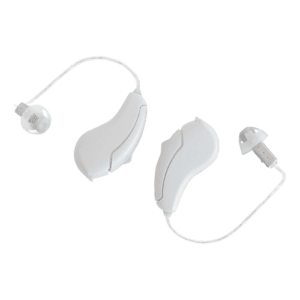
A pair of rechargeable Enhance Select 50R hearing aids cost $995 (basic package), about 40% less than the average $3,000 price tag for similar high-tech aids purchased at an audiology clinic. A pair of rechargeable Enhance Select 100 costs $1,495–$1,695 (basic versus premium package), though the company offers financing options that allow you to pay as little as $49–$55 per month for this device.
Jabra Enhance also has a newer rechargeable model called the Enhance Select 300. At $1,795 per pair for the basic package ($58 per month with financing) or $1,995 per pair for the premium package ($65 per month with financing), the Enhance Select 300 is the most expensive option. But it’s also smaller than the previous Select 200 and offers the company’s newest technology.
Jabra says the 300 provides greater depth of sound than the 200, better speech understanding in noisy settings, and minimal disruption from repetitive background sounds (like dishes clattering or dogs barking).
For a high-quality OTC hearing aid with knowledgeable remote audiology support, Jabra Enhance Select is our top choice.
Read our Jabra Enhance review for more information.

At only $249 per pair, the Audien Atom Pro has the lowest price of every other hearing aid on the market, and the company has options that cost even less, starting at $99 for the Audien Atom. Price is a critical consideration when purchasing hearing aids—respondents to our survey chose price as the second most important factor when choosing which hearing aid to buy. If your budget doesn’t allow you to spend thousands on a hearing device, Audien may be a great choice.
- Battery: Rechargeable
- Bluetooth capabilities: No
- Adjustment: Screw on hearing aid
- Warranty and trial period: Audien offers a one-year manufacturer’s warranty, an unlimited warranty for customers enrolled in the protection plan, and a 45-day trial period.
- Financing: No
The Atom Pro has a collection of features that helps it punch well above its weight class, including enhanced feedback cancellation and advanced sound processing. It is a small, in-the-canal (ITC) hearing aid with a rechargeable battery that lasts up to 24 hours (after charging for four to six hours) and can be charged wirelessly in the hearing aid case. The Atom Pro also features Audien’s newest sound processing technology, which the company says cuts down on feedback and the whistling noise that can be common in hearing aids.
Along with the low price point, Audien also differentiates itself with an unlimited protection plan, which is a step above the standard one-year warranty. For $4 per month, you can enroll in the plan, which covers broken, lost, and damaged devices. This warranty will give you a replacement pair of Atom Pro hearing aids for $34.
With the Atom Pro’s competitive low price comes less functionality and fewer features. For starters, Audien doesn’t offer audiologist support or remote adjustments. That means you’ll be on your own for any attempts to adjust your devices or troubleshoot issues, although the company does offer a limited number of articles and videos to help resolve common problems on its support page . In addition, none of Audien’s devices can be customized for your particular hearing needs, and the company offers no smartphone app—both of which are standard features of the rest of the hearing aids on this list.
If you’re comfortable sacrificing function and features in exchange for getting one of the most affordable hearing aids on the market, the Audien Atom Pro may be a good choice. But if you’re a first-time hearing aid buyer or would prefer more support, we recommend choosing another hearing aid with options for remote adjustments or audiologist support.
Read our Audien review for more information.

The Audéo Lumity, from prescription hearing aid manufacturer Phonak, comes with high-performance hearing technology, exceptional quality, rechargeable battery life, and Bluetooth connectivity, making it a popular choice for both customers and hearing care professionals. The audiologists our Reviews Team consulted all had positive feedback for Phonak.
- Bluetooth capabilities: Yes
- Adjustment: Local fitting included with purchase
- Warranty and trial period: Dependent on retailer
- Financing: Dependent on retailer
Using AutoSense technology , the Audéo Lumity automatically detects your sound environment and adjusts as needed. If you’re in an empty restaurant that suddenly gets busy and the noise around you increases, your hearing aids will sense the new noise level and make the necessary adjustments with little to no interruption to your hearing ability. You don’t have to press any buttons or pull out your phone.
The Phonak Audéo Lumity also allows you to stream anything from any Bluetooth device. You can even stream from two devices at the same time. You can answer or decline calls with a simple tap of your hearing aid once you’ve connected them to your Bluetooth-enabled smartphone. With hands-free calling, the microphones in the hearing aid double as a phone microphone, so your phone can be in another room and the person on the other end will still be able to hear you. Phonak hearing aids feature Roger wireless technology , and the Phonak TV Connector allows you to stream television sound directly into your hearing aids.
While the Audéo Lumity offers a variety of features and is suitable for mild to profound hearing loss, it is one of the most expensive hearing aids on this list at $2,600–$6,500 per pair. People with mild to moderate hearing loss who want a simple, easy-to-use device may prefer a more inexpensive over-the-counter option.
Read our Phonak review for more information.
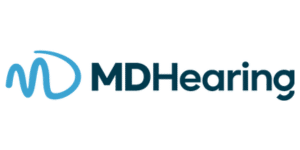
MDHearing offers behind-the-ear (BTE) and in-the-canal (ITC) hearing aids to fit almost any budget. That’s important for many customers. Respondents to our Reviews Team’s March 2022 survey of hearing aid users identified cost as the second most important factor when purchasing hearing aids, behind only “ease of set up and use.”
But the real benefit of MDHearing is the company’s versatile line of products. Its four models offer a wide range of features, which is why we gave this brand the title of “Most Feature Options.”
- Bluetooth capabilities: Yes (VOLT MAX)
- Adjustment: Volume dial (all models) and remote phone app (VOLT MAX)
- Warranty and trial period: MDHearing offers a one-year warranty on the Air, NEO, NEO XS, and Volt, a two-year warranty on the VOLT MAX, and a 45-day trial period on all models.
- Financing : Yes
All MDHearing models are registered with the U.S. Food and Drug Administration (FDA) and are FDA-cleared. The company’s entry-level model, the AIR, is $297 per pair on sale—one of the lowest prices on this list. It lacks the advanced features of more expensive MDHearing models, such as dual directional microphones (which help filter out unwanted noise) and Bluetooth capability. But it still comes with advanced noise reduction, rechargeable batteries, feedback cancellation, telecoil technology, and customizable options that make it a good budget-friendly pick.
The water-resistant NEO is often on sale for $297 per pair and has rechargeable batteries, which will give you roughly 18 hours of use on a three-hour charge. The NEO also features background noise reduction and feedback cancellation, and it offers simple controls for seamless sound adjustment, as well as a handy cleaning tool.
The NEO XS has upgraded noise reduction and is the smallest hearing aid in the lineup. It features a completely-in-the-ear design and promises all-day comfort. A standout feature is the portable charging case for convenient, on-the-go recharging. While the NEO XS retails for $1,499, you can often find it on sale for $397 per pair.
The VOLT is a step up in terms of features. In addition to rechargeable batteries, which give you roughly 20 hours on a two-hour charge, the Volt has advanced digital technology with dual directional microphones and intelligent noise reduction, which should provide improved speech comprehension, and ultimately, easier communication.
At $699.98 on sale ($2,399.98 retail), the VOLT MAX is the most advanced of the line. It may be the priciest, but it comes with the most additional features. To start, it’s the only Bluetooth-compatible model that works with the MDHearing smartphone app, which allows you the extra option to make volume and settings adjustments from your phone—in addition to the manual controls. Plus, the adaptive technology auto adjusts to noise detection. The only downsides are the VOLT MAX is a slightly larger model and the rechargeable battery only lasts 15 hours on a full charge.
If you ever have problems with your devices, MDHearing has licensed audiologists on staff who can answer any questions you have by phone or email. MDHearing doesn’t include hidden costs or equipment fees, so you can be sure the price you see is the true cost. You’ll also get a 45-day money-back guarantee.
Read more in our MDHearing review .

Eargo is known for its small, rechargeable hearing aid devices that are nearly invisible when positioned in the ear canal. Because of the small size, users in verified customer reviews routinely report that they forgot they’re there. Also, the unique flexible fibers in Eargo devices mean you won’t get that “plugged up” feeling sometimes caused by in-canal hearing aids.
- Battery: Rechargeable
- Adjustment: Remote, phone app, or by tapping your ear
- Warranty and trial period: Eargo offers a one-year warranty on the Eargo 5, Eargo 6, Eargo SE, and LINK by Eargo, and a two-year warranty on the Eargo 7. All warranties include unlimited repairs and a one-time replacement. Eargo also provides a 45-day trial period.
- Financing: Yes
The Eargo 7 features an improved Sound Adjust+ with Clarity Mode, which can automatically adjust the hearing aids’ sound profile to your surroundings for a clearer listening experience in both loud and quiet environments. The Eargo 6 has a similar Sound Adjust feature, but it functions best in quiet environments. While most Eargo models come with a one-year warranty, the Eargo 7 comes with a longer two-year warranty.
The two newest models, the Eargo SE and LINK by Eargo, are more affordable alternatives to the 6 and 7. The nearly invisible Eargo SE retails for $1,650 and has four customizable hearing settings. The LINK by Eargo has basic features and a lower price tag of $799 per pair. The standout features of LINK by Eargo are Bluetooth 5.3 music/phone streaming and an earbud-style design.
More than 70% of Eargo users who responded to our survey reported that their Eargo hearing aids are comfortable and fit well, which is noteworthy since Eargo only sells online hearing aids, and you don’t need an in-person fitting from a hearing professional. We named Eargo “Best Invisible Fit” because the brand’s devices offer comfort and a small size.
Eargo employs a unique design that allows for a more natural hearing experience with noise reduction and feedback cancellation. The company also offers affordable financing options that get you a hearing aid for as little as $47 a month.
When you purchase an Eargo device, you’ll work with a personal hearing professional to help you along the way, and you’ll have customer support for a lifetime. Eargo hearing aids can be used right out of the box. You can either make adjustments yourself through the smartphone app, or the company’s hearing professionals can help you program your devices remotely.
Read our Eargo review for more information.

Lexie offers three self-fitting OTC hearing aids ⓘ Self-fitting hearing aids include software that allows the user to program their own devices. with a range of features. Lexie ties with Jabra and Lucid Hearing for the highest rating from our Reviews Team’s hands-on testing. Given its top score, advanced features, user-friendly app, and competitive price (it’s one of the least expensive hearing aids on this list), Lexie is our Reviews Team’s pick for Most User-Friendly.
- Adjustment: App or buttons on hearing aid
- Warranty and trial period: Lexie offers a one-year manufacturer’s warranty and 45-day risk-free trial period
- Financing: Lexie doesn’t have traditional financing, but the company now partners with Klarna , allowing you to have flexible payment options.
Lexie’s three models are appropriate for mild to moderate hearing loss and come with noise reduction and feedback management. They are all available for purchase online and in stores and offer remote support.
The Lumen is a behind-the-ear (BTE) model priced at $799 per pair. It includes disposable batteries and six preset listening profiles. You can make volume or profile adjustments using buttons on the hearing aid or through the smartphone app. The Lumen also has a telecoil, which allows you to stream sounds directly to your hearing aids in any facility equipped with a hearing loop.
The B1 has disposable batteries and costs $799 per pair, while the B2 Plus costs $200 more and comes with rechargeable batteries that last up to 18 hours per charge. The B2 Plus also allows iPhone users to stream calls through their hearing aids. All three Lexie models are self-fitting hearing aids, which give you more control over the settings and sound quality.
The FDA classifies hearing aids as medical devices and regulates them for safety and efficacy. Some manufacturers, such as Lexie and MDHearing, have submitted additional data showing that the settings on certain models can be customized at home by the user. These devices have received FDA clearance as self-fitting hearing aids.
The key difference between a self-fitting hearing aid and a non-self-fitting model is that you can customize the settings to your hearing profile on the former but not the latter. The Lexie B1 and B2 Plus, for example, allow you to use the Lexie app to adjust the volume, bass/treble balance, left/right sound balance, and amount of sound you receive from certain directions. The Lexie Lumen, on the other hand, only lets you change the volume and select from one of six listening settings, but it also adjusts to your hearing loss profile based on an in-app screening that you complete when setting up the hearing aids. In testing, we found the app quick and easy to use.
Read our full Lexie review for more information.

The Signia Silk X is a completely-in-canal (CIC) hearing aid. The small size gives you both an invisible fit and a customized hearing experience. Like other devices on this list, the Signia Silk X does not require an in-person fitting with a hearing professional. It’s actually the only Signia hearing aid that sits completely in your ear canal that doesn’t require an in-person fitting. It uses soft silicone Click Sleeves—these are flexible silicon sleeves that attach to the end of your hearing aids to help position them in your ear canal and provide better acoustics. They come in different sizes based on the size of your ear canal and the type of your hearing loss. The Silk X has 48 channels and six customizable programs, giving you plenty of choices to find the right one for your needs.
- Battery: Disposable
- Bluetooth capabilities: No
- Adjustment: Phone app, remote, or in-person
Where it really shines is its sound processing. The Signia Silk X runs on the company’s Xperience technology , which uses acoustic-motion sensors to create a more natural sound experience while you move. The Xperience technology is why we called out the Signia Silk X for “Most Natural Sound.” These motion sensors, which are built into the Silk X, detect when the wearer is moving and adapt their sound processing accordingly. This provides a more natural sound than other hearing aids, since we hear differently when we’re moving versus when we’re stationary. Not all hearing aids can account for this difference.
Xperience technology also helps you filter out background noise and focus on the conversations in front of you (for example, in a busy restaurant) and hear a more natural version of your own voice while wearing your hearing aids, according to the company’s whitepaper .
The Silk X is ideal for people with mild to moderate hearing loss, but isn’t suitable for those with moderately severe to profound hearing loss.
Read more in our full Signia hearing aids review .

Most hearing aid manufacturers offer a rechargeable option, but the ReSound Omnia rechargeable hearing aid is one of the most feature-rich and longest lasting, offering up to 30 hours of continued use from three hours of charging. The case also stores and recharges your hearing aids on-the-go without needing to be plugged into an outlet. The long battery life and high customer satisfaction with ReSound rechargeable hearing aids is why we named them the “Best Rechargeable Hearing Aids.”
- Adjustment: Remote, phone app, or in-person
- Financing: Dependent on retailer
Rechargeable hearing aids remove the hassle of having to exchange small (and often difficult to swap out) batteries. They also help you potentially save money in the long run since you don’t have to regularly purchase disposable batteries.
ReSound also stands out from other companies for its feature-heavy app. Most hearing aid companies offer apps to help you make minor adjustments to your devices’ settings. But ReSound offers an extra level of personalization with tinnitus management, location-based hearing (which lets you save hearing settings from your favorite locations so your hearing aids automatically switch to those settings when you return), and a “Find My Hearing Aids” feature. You can also use the app to book a ReSound Assist Live Assistance video call, which is a video appointment with a hearing professional for live assistance and remote fine-tuning. Similar to other hearing aid apps, you can also control volume, bass/treble, noise reduction, and microphone direction.
One thing to note is that the ReSound Omnia has one of the most expensive price tags on this list. Rechargeable hearing aids are generally more expensive than those with disposable batteries because rechargeable hearing aids require more advanced technology.
But some OTC hearing aid companies, such as Jabra Enhance, Lexie, Eargo, and Audien, offer rechargeable hearing aids for people with mild to moderate hearing loss at a lower price than ReSound and other prescription brands. Just keep in mind that if your hearing loss is severe or profound, or you’re often in challenging listening environments, a prescription hearing aid like ReSound that offers the most advanced sound processing and in-person support can be worth the extra money.

hear.com Horizon hearing aids earned the title “Best In-Home Care” for its innovative approach to hearing aid technology and user experience. hear.com stands out for its integration of teleaudiology ⓘ A form of telemedicine, hearing care services provided remotely through the use of virtual technology like video, phone, text messaging, and email. and Clinic-in-a-Box service, allowing customers to have their hearing aids professionally programmed and fine-tuned from the comfort of their home.
Clinic-in-a-Box provides everything needed to be fitted with prescription hearing aids, including set-up, customization, and ongoing adjustments, without leaving your home. The box includes a teleaudiology tablet (similar to an iPad) that’s pre-programmed for your appointment, easy-to-use hearing test equipment, and your new hearing aids. The hearing aids are fitted and customized remotely by an audiologist using the results of your hearing test. You then receive ongoing care with further remote adjustments through follow-up video appointments.
While hear.com offers several brands of prescription hearing aids, Horizon is its in-house line. The company makes two models of Horizon hearing aids: the Go IX are mini RIC devices suitable for mild to profound hearing loss, and the Mini IX are tiny ITE devices for mild hearing loss.
- Battery: Rechargeable, with up to 28 hours of wear time
- B luetooth Capabilities: Yes, streaming for both Apple and Android devices
- Adjustment: On-device button, app, or remote
- Warranty and Trial Period: Three-year warranty and 45 day trial period
- Financing: Yes, they offer flexible financing information
- Insurance: Yes, they work with all major plans
Both Horizon models are designed with dual processors, allowing for separate processing of speech and environmental noises. This feature significantly enhances speech understanding in noisy settings like restaurants. The aids also come with an “own voice” processing feature, which minimizes the user’s voice for comfortable listening without compromising the sounds needed to be heard.
The Horizon Go IX model utilizes Signia Augmented Xperience (AX) technology, enhancing speech clarity in challenging environments. Additionally, it comes equipped with advanced features such as speech focus, panorama effect, and relax mode. The design of the Go IX model minimizes thickness at the top of the hearing aid, offering comfort for those who wear glasses or have smaller ears. The slimmer design also contributes to a more discreet appearance than most RIC models.
Both Horizon models come with Clinic-in-a-Box service.
We are pleased to see hear.com expanding hearing aid access to those for which it was previously out of reach. With the recent rise in popularity of telehealth, hear.com is at the forefront of an important trend in hearing health care. Telemedicine reached the 80% adoption mark in 2022, becoming the preferred method for prescription care and minor illness.
Telemedicine saw a notable rise in use among underserved groups, like people over 55 and people in rural areas. We expect more prescription brands to follow suit in the coming years.

The Starkey Evolv AI has artificial intelligence (AI) that can detect a fall. You can add loved ones or caregivers as a contact in the Starkey app , and it will send them a notification if the hearing aids detect that you’ve fallen. This gets you the help you need and, at the same time, alerts those closest to you that you’ve fallen.
- Battery: Rechargeable and disposable options
- Adjustment: Remote phone app
More than one out of four people over the age of 65 fall each year, according to the most recent data from the Centers for Disease Control and Prevention (CDC) . [1] Centers for Disease Control and Prevention. Facts About Falls. Found on the internet at https://www.cdc.gov/falls/facts.html In 2012, researchers at Johns Hopkins University found that patients with mild hearing loss were nearly three times more likely to have a history of falling. [2] Johns Hopkins Medicine. Hearing Loss Linked to Three-Fold Risk of Falling. Found on the internet at https://www.hopkinsmedicine.org/news/media/releases/hearing_loss_linked_to_three_fold_risk_of_falling
Brands that didn’t make our best hearing aids list
Our Reviews Team vetted the top hearing aids through careful research and testing, but there are many other brands on the market. While Go Hearing, Otofonix, Rexton, and Unitron are close contenders for our best hearing aids designation, here’s why these brands and others didn’t make our current list.
- Go Hearing : For $199–$499 per pair, Go Hearing OTC hearing aids are a close runner-up to our list because of the brand’s competitive prices and battery life. The brand’s Go Prime discreet ITE model has a long rechargeable battery life of 30 hours and a wireless case that can fully charge your hearing aids up to six times for when you’re on the go, earning a place on our best rechargeable hearing aids roundup.
- Otofonix : Otofonix OTC hearing aids range between $248–$795 per pair. Otofonix hearing aids with rechargeability and Bluetooth connectivity for wireless adjustments tend to be priced higher, with costs varying between models. While Otofonix is relatively low-cost compared to other hearing aid brands on our list, it only offers one BTE style across all six models, while brands like MDHearing offer more versatility at a similar price range of $299–$699 per pair.
- Rexton : You can find Rexton prescription hearing aids at Costco starting at $1,599.99 per pair, or you can purchase them through your audiologist. Offering all hearing aid styles and 14 different models, the brand offers a wide selection of rechargeable devices that treat mild to profound hearing loss. Most Rexton hearing aids offer advanced technology that adapts to your environment to enhance sound and clarify speech, but brands like Starkey have an edge over Rexton with their more advanced, award-winning learning software.
- Unitron : Unitron prescription hearing aids are manufactured by Sonova, the same manufacturer that produces the well-known Phonak hearing aids included in our top picks. This brand offers RIC, BTE, and ITE styles with Bluetooth and rechargeable options that cost from $2,000–$6,000, depending on the model. Although Unitron and Phonak devices closely resemble each other, Phonak has a wider range of accessories and more advanced noise canceling technology.
- Nano : Nano rechargeable OTC hearing aids cost $297–$597 per pair and come in BTE and CIC styles. The Sigma+ ($597) is the only model that offers Bluetooth connectivity to an app for wireless adjustments. This brand’s price range is lower than most, but buyer beware: Nano was involved in a lawsuit over false advertising and misleading business practices for “implying its products are approved by the FDA when they are not” and unlawfully marketing its products for children. Read more in Vermont’s Attorney General 2023 press release , and check out our Nano Hearing Aids Review .
What is a hearing aid?
A hearing aid is an electronic device designed to improve your hearing in both noisy and quiet environments. Hearing aids work by magnifying sound frequencies entering the ear.
Hearing aids have one or two microphones to pick up sound, an amplifier to make the sound louder, and a receiver to transmit the amplified sound to the middle ear. Beyond the basic operating parts, companies offer hearing aid devices with different designs, features, and technology.
How do hearing aids work?
Hearing aids are worn in or behind your ear. They’re designed to make certain sound frequencies louder to improve your hearing and speech comprehension. A microphone inside the hearing aid first picks up sounds, which are then analyzed and converted to electrical signals. These signals are then sent to the amplifier.
The now amplified sounds are sent to the speaker or receiver, which are transmitted to the inner ear by a tube or thin wire. Once in the inner ear, the sounds are transformed into electrical impulses, which your brain turns into sound.
Digital vs. analog hearing aids
Hearing aids are available in analog or digital . Although digital is the most common type of device, a few companies still carry analog hearing aids. The difference between analog and digital devices comes down to the type of electronics used. Both devices convert sound waves, but the process used sets each type apart. [4] U.S. Food and Drug Administration. Types of Hearing Aids. Found on the internet at https://www.fda.gov/medical-devices/hearing-aids/types-hearing-aids
With an analog hearing aid , you will experience amplification with all sounds, including noise and speech. In other words, they make continuous sound waves louder. Analog hearing aids require the user to change settings when in different environments, but some people feel that analog devices provide a more natural hearing experience.
Digital hearing aids convert sound waves to digital signals, providing the clearest hearing possible. These devices are capable of clearing out background noise, reducing feedback, and helping you focus on the sounds and voices you want to hear. Digital hearing aids also offer more complex programming, which allows you to process sounds more selectively.
Types of hearing aids
The five main types of hearing aids have their own pros and cons.
Completely-in-the-canal (CIC) hearing aid
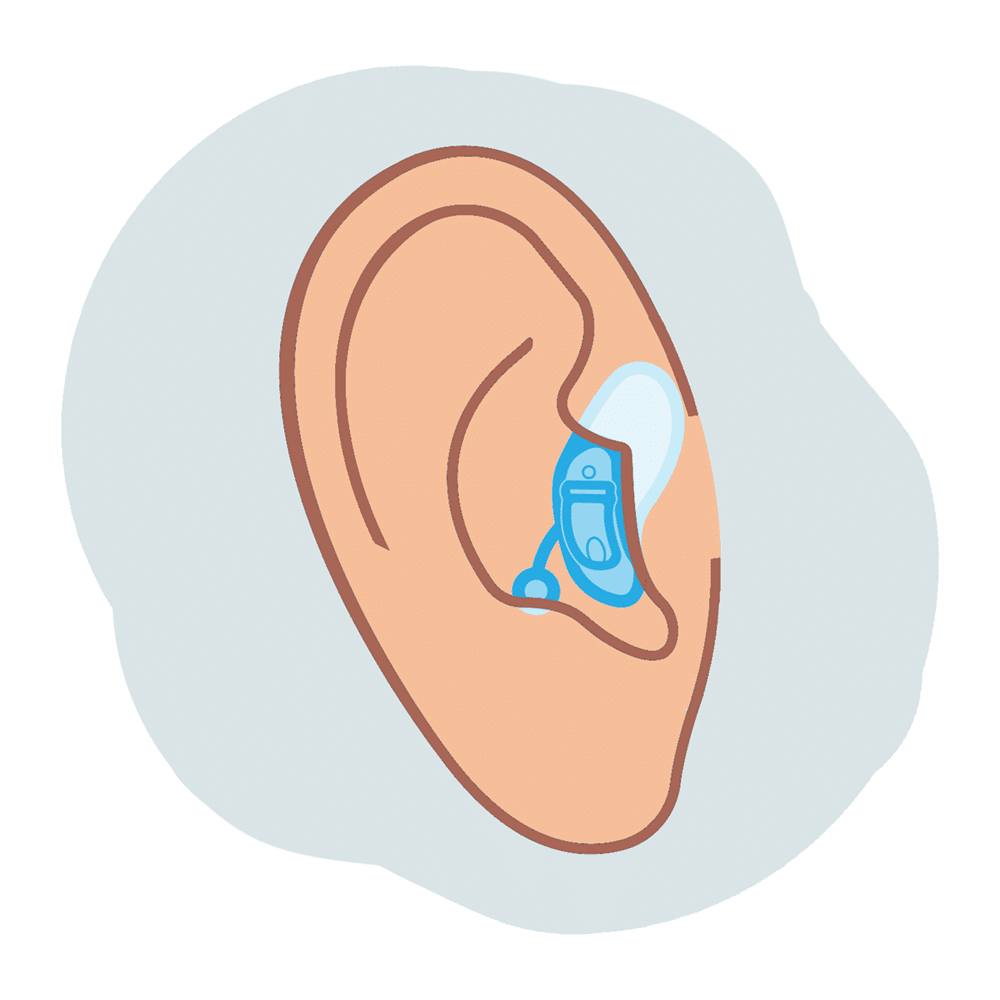
Also called a mini CIC, this hearing aid is the smallest and least visible device for treating hearing loss. It is positioned completely within the ear canal, and a tiny string allows you to remove the device.
In addition to an invisible fit, CIC devices offer the advantage of less feedback when using a telephone and less disruptive noise from wind.
Due to their small size, CIC hearing aids may not have some of the features you’d get with other larger devices, such as Bluetooth streaming and rechargeable batteries. Some CIC hearing aids are also too small for a directional microphone. Battery life may also be shorter due to the small size of the device, and ear wax and moisture can affect their function.
Of the brands and models covered in this review, the following companies offer CIC hearing aids:
One subtype of CIC hearing aid is the invisible-in-canal (IIC) style. The Phonak Lyric comes in this style. Sitting deep in the ear canal, IIC hearing aids are truly invisible when properly inserted.
In-the-canal (ITC) hearing aid

This hearing aid sits deep in the ear canal, but it’s a bit larger and more visible than a CIC device. ITC hearing aids allow for longer battery life than many CIC devices, as well as directional microphones. But they are still susceptible to issues with earwax and moisture, and may be difficult for some people to handle due to their relatively small size.
Behind-the-ear (BTE) hearing aid
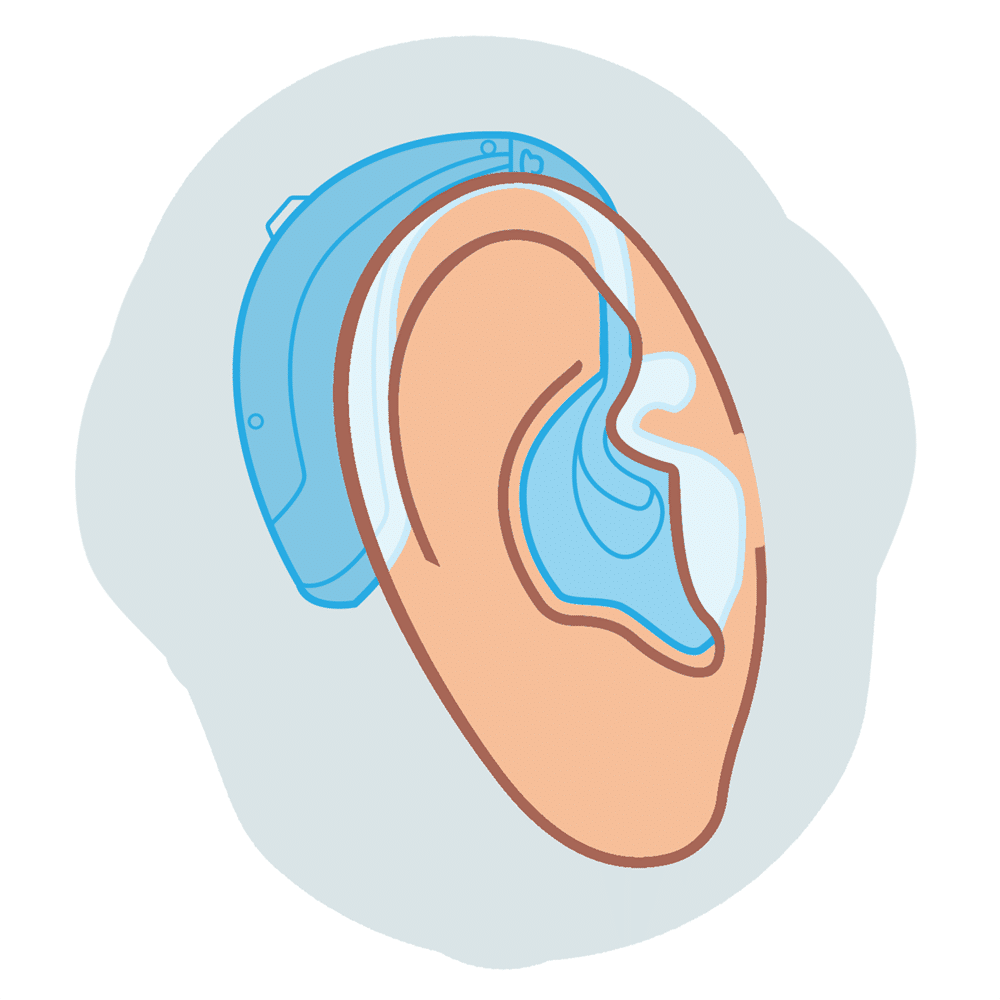
This device sits behind your ear and includes a plastic tube that hooks over your ear to reach the ear canal. At the end of the tube is a dome or custom-fit ear mold that sits snugly within the canal.
These devices tend to be larger than in-the-ear or in-the-canal hearing aids, but they offer more capabilities, such as directional microphones and a telecoil, which can help you hear better on the telephone and with assisted listening devices. They’re also easier to handle and can be a better choice for people with severe or profound hearing loss.
Of the brands and models covered in this review, the following companies offer BTE hearing aids:
Receiver-in-canal (RIC) hearing aid

Also referred to as receiver-in-the-ear (RITE) or mini behind-the-ear (mBTE), RIC devices sit behind the ear like traditional types, but are smaller and less visible, especially when you choose one that matches your hair color. They have a tiny wire encased in silicone tubing that hooks over the ear and connects to a small receiver that fits inside the ear canal.
For many users, these devices strike the perfect balance between looks and functionality.
Of the brands and models covered in this review, the following companies offer RIC hearing aids:
- Jabra Enhance
- hear.com Horizon
In-the-ear (ITE) hearing aid
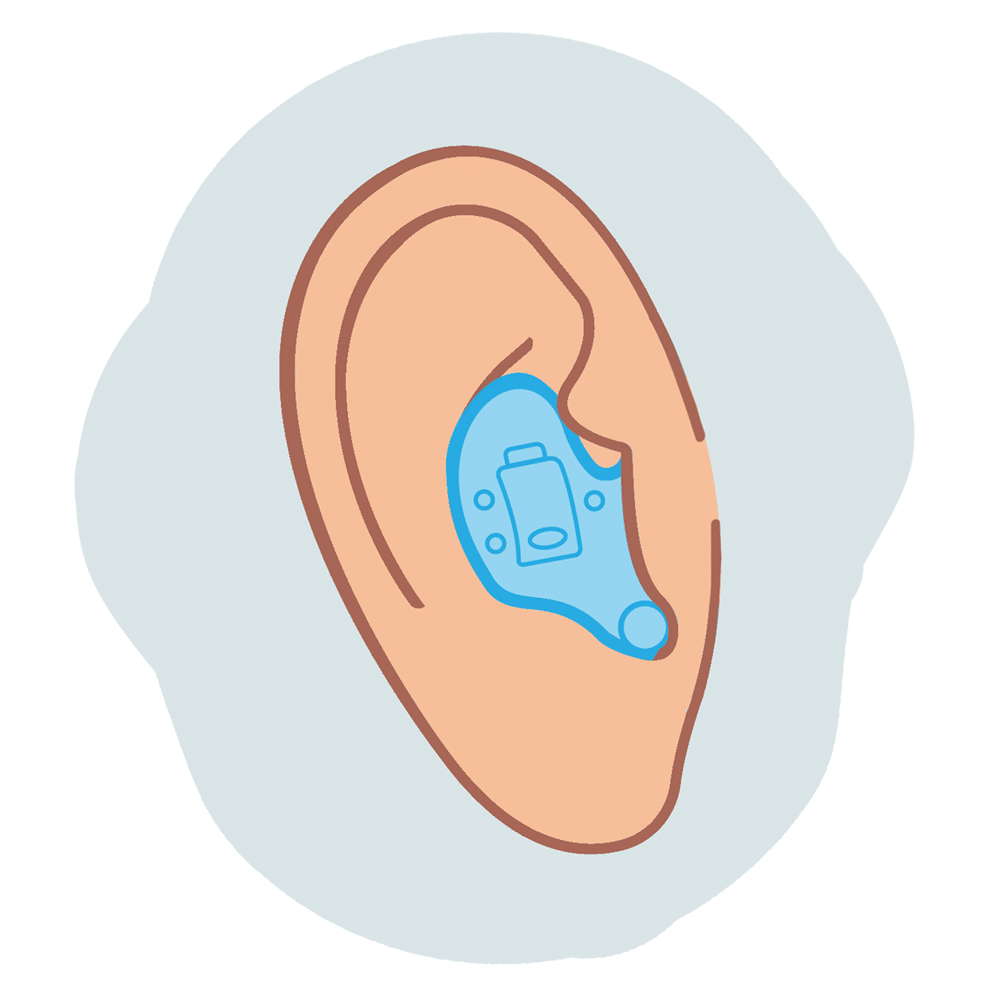
This type of hearing aid sits completely within the ear, but is larger than the CIC style. ITE hearing aids are generally large enough to offer advanced features such as Bluetooth, directional microphones, and a telecoil, but the smaller size may limit their power compared to BTE models. ITE hearing aids are typically easier to handle and insert than their smaller counterparts, but they may also be more visible.
Of the brands and models covered in this review, the following companies offer ITE hearing aids:
Over-the-counter (OTC) hearing aids
In August 2022, the FDA established a new hearing aids category for OTC hearing aids . Consumers can now purchase certain hearing aids directly from pharmacies, stores, and online retailers—with no doctor visit or prescription required.
Based on the FDA’s final rule , [5] Federal Register. Medical Devices; Ear, Nose, and Throat Devices; Establishing Over-the-Counter Hearing Aids. Found on the internet at https://www.federalregister.gov/documents/2022/08/17/2022-17230/medical-devices-ear-nose-and-throat-devices-establishing-over-the-counter-hearing-aids OTC hearing aids:
- Are “intended to address perceived mild to moderate hearing loss in adults age 18 or older” [6] OTC Hearing Aids: What You Should Know. U.S. Food & Drug Administration. May 3, 2023. Found on the internet at https://www.fda.gov/medical-devices/hearing-aids/otc-hearing-aids-what-you-should-know
- Can be purchased online or in stores without a hearing exam, prescription, or professional fitting
The FDA’s final ruling on OTC hearing aids is meant to increase access. [7] Federal Register. Medical Devices; Ear, Nose, and Throat Devices; Establishing Over-the-Counter Hearing Aids. Found on the internet at https://www.federalregister.gov/documents/2022/08/17/2022-17230/medical-devices-ear-nose-and-throat-devices-establishing-over-the-counter-hearing-aids The high price of hearing aids, the perceived stigma of wearing them, and the concern that they aren’t effective are all common reasons that people with hearing loss wait an average of 10 years before seeking treatment. [8] Smith D, et al. Acceptability, benefits and costs of early screening for hearing disability: a study of potential screening tests and models. Found on the internet at https://www.journalslibrary.nihr.ac.uk/hta/hta11420/#/full-report This has paved the way for more retailers to enter the hearing aid market, which should drive the price down, making them affordable and shortening the wait time before people decide to treat their hearing loss.
Pros and cons of OTC hearing aids
If you’re not sure whether OTC hearing aids are right for you, it’s important to weigh the pros and cons. This can help you make the most informed decision when it comes to treating your hearing loss.
Pros and cons of prescription hearing aids
What to consider before buying a hearing aid.
The National Institute on Deafness and Other Communication Disorders (NIDCD) reports that 37.5 million American adults have some level of hearing loss. [9] National Institute on Deafness and Other Communication Disorders. Quick Statistics About Hearing. Found on the internet at https://www.nidcd.nih.gov/health/statistics/quick-statistics-hearing While hearing loss can occur at any time in life, the problem becomes more common with age.
The NIDCD estimates almost one in four adults between the ages of 65 and 74 and half of people older than 75 have disabling hearing loss. Which is why it may come as a surprise that only one in three adults who could benefit from hearing aids has ever used them. National Institute on Deafness and Other Communication Disorders. Quick Statistics About Hearing. Found on the internet at https://www.nidcd.nih.gov/health/statistics/quick-statistics-hearing
People with hearing loss may not seek help for a variety of reasons, including:
- The cost of hearing aids and hearing care
- The fact that some insurance companies and Medicare plans do not cover hearing aids
- Distance from hearing care providers
- The stigma associated with wearing a hearing aid [10] The Gerontologist. The Stigma of Hearing Loss. Found on the internet at https://academic.oup.com/gerontologist/article/50/1/66/692298
We asked Michelle Brady, an audiologist with Access Audiology , a mobile audiology service in the New York City area, what she’d like people to know about the purchasing process. According to Brady, the most important thing to consider when shopping for a hearing aid is time.
“Research has shown that the longer hearing loss goes untreated, the [more the] brain’s ability to understand and decode speech decreases,” Brady said. “Just like muscles in the body—if you don’t use it, you lose it. Unfortunately, hearing aids cannot override the damage that occurs from years of decreased auditory stimulation. The earlier a patient gets hearing aids and wears them consistently, the better their brain will be able to process and decode speech.”
Hearing loss has also been associated with higher rates of falls, depression, and social isolation among older adults. Getting your hearing checked and corrected can play an important role in improving your quality of life.
What older adults look for in hearing aids
Older adults concerned with the visibility of a hearing aid should consider in-the-ear (ITE) models that are more discreet compared to behind-the-ear (BTE) options. Additionally, if you are not particularly tech-savvy or just want a hearing aid that has the easiest setup, it might be beneficial to consider a more basic hearing aid device without too many complex features. On the other hand, if you’re comfortable with smartphones, apps, and customizing your own settings, a more advanced model does offer more overall convenience in terms of operations.
Hearing aid features to consider
As hearing aid technology changes, more features become available. The following are a few of the most popular additional features that can make your hearing aids more helpful and enjoyable to use.
Common types of hearing loss
The type of hearing loss you have could influence the type of hearing aid you decide to purchase. Read on for information on the most common types of hearing loss . [11] Centers for Disease Control and Prevention. Understanding Hearing Loss. Aug. 7, 2023. Found on the internet at https://www.cdc.gov/ncbddd/hearingloss/parentsguide/understanding/understandinghearingloss.html
- High frequency : Trouble hearing sounds in the 2,000–8,000 hertz (Hz) range, which are many of the sounds involved in speech (most people with age-related hearing loss have problems hearing high frequencies.)
- Low frequency: Difficulty hearing sound frequencies of 2,000 Hz or lower
- Sensorineural : This is the most common type of age-related hearing loss and is caused by damage to the auditory nerve or hair cells in the inner ear
- Conductive: Caused by a problem with sound traveling through the outer or middle ear
- Mixed : A combination of sensorineural and conductive hearing loss
Degrees of hearing loss
Your degree of hearing loss can also impact the style of hearing aid that suits your needs. The CDC outlines four levels, or degrees, of hearing loss based on how loud sounds must be for you to hear and understand them. [11] Centers for Disease Control and Prevention. Understanding Hearing Loss. Aug. 7, 2023. Found on the internet at https://www.cdc.gov/ncbddd/hearingloss/parentsguide/understanding/understandinghearingloss.html
- Mild: Able to hear some speech, but softer sounds are difficult to hear
- Moderate : Unable to hear most speech at a normal level
- Severe : Unable to hear speech at all, can only hear some loud sounds
- Profound : Only able to hear extremely loud sounds
How much do hearing aids cost?
The cost of hearing aids largely depends on whether you’re purchasing OTC or prescription hearing aids, as well as the battery type (disposable or rechargeable), features, and sound technology. In fact, hearing aid pricing ranges widely: from $99 to $7,000.
How to find affordable hearing aids
Hearing aids are an investment. Even the most inexpensive hearing aids cost around $300 per pair.
MDHearing, for example, sells budget-friendly digital hearing aids starting at $999.98 per pair (before promotions). Audien offers low-cost devices starting at $99 per pair, but they’re very basic compared to other hearing aids on the market.
Before buying a lower-cost model, make sure to check the fine print. Some retailers and online distributors advertise low-cost hearing aids but are actually selling PSAPs, which amplify sound but do not provide the same level of support or technology as a hearing aid.
Hearing aids are typically sold through hearing care clinics or larger retailers, like Walmart or Costco. But you can also find inexpensive OTC hearing aids online through companies like MDHearing, Jabra Enhance, Lexie, and Eargo.
If you need a prescription hearing aid that’s only offered through a hearing care clinic, consider purchasing through an authorized discount supplier, such as Yes Hearing, which sells high-quality hearing aids, like Phonak and Signia, at a reduced cost. You still work with a local audiologist to get fitted and set up with your device, while the supplier manages the purchasing process with your hearing provider. This option could save you hundreds of dollars.
Read our review of the best affordable hearing aids for more in-depth guidance.
Does Medicare or insurance cover hearing aids?
Medicare Parts A and B don’t include coverage for hearing aids, although many Medicare Advantage Plans (known as Part C) and private insurance plans do provide hearing benefits. Contact your health care provider for more information.
NCOA continues to advocate for Medicare coverage of hearing aids by working with Medicare beneficiary groups and supporting H.R. 5376, the Build Back Better Act , which would initiate Medicare coverage for hearing aids.
In January 2023, U.S. representatives Debbie Dingell (D-MI) and Brian Fitzpatrick (R-PA) also reintroduced H.R. 244, the Medicare Hearing Aid Coverage Act , to Congress. Our Reviews Team spoke with Rep. Dingell’s office and learned that if the bill passes, it would remove a Social Security restriction on hearing aid coverage.

“Hearing aids aren’t a luxury, they are critical for millions of people to maintain a healthy, independent lifestyle. Without them, many seniors cannot interact with family, friends, neighbors, and their communities, and as a result, can become isolated.
“By expanding coverage for hearing aids under Medicare, more seniors will be able to live with dignity and independence. I’m proud to re-introduce this legislation, and remain committed to getting this signed into law to expand access to care for so many who need it. It’s simple: No one should feel isolated, confused, or shut out from the world because they can’t afford hearing aids,” said Dingell.
How to buy hearing aids
A few years ago, there was only one way to get treatment for hearing loss: Make a trip to a hearing care clinic to be tested and fitted for hearing aids. This was a challenge for many people who didn’t have easy access to these locations. But thanks to recent changes in the hearing aids industry, there are now multiple ways to purchase high-quality hearing aids.
Visit a hearing clinic
For prescription hearing aids, you will generally need to visit a hearing care clinic for an in-person consultation and hearing exam by an audiologist or hearing instrument specialist. Audiologists are hearing professionals with at least a master’s degree in the field of audiology who diagnose hearing loss and fit hearing aids. Hearing instrument specialists are hearing professionals with a high school diploma or two-year degree and are only licensed to help fit or program hearing aids.
Purchase prescription hearing aids through a discount network
Another option is to purchase prescription hearing aids from a discount network such as Yes Hearing for up to 40% less than retail price. When you purchase through this network, you’ll be connected with an audiologist in your area for further care. If you are a veteran, check with your local Veteran Affairs (VA) medical center about meeting with an audiologist, getting a hearing test, and determining which hearing aid is right for you.
Larger retail stores, such as Costco, also sell hearing aids. Almost 15% of the hearing aid users we surveyed used Kirkland hearing aids from Costco . The next most-popular brand in our survey was Eargo, with 8%.
Buy prescription hearing aids online
The newest way to buy prescription hearing aids is through a company like hear.com. Its Horizon line of hearing aids is offered through a unique Clinic-in-a-Box service, where you are sent everything needed for professional testing, fitting, and customization, all done at home through teleaudiology (virtual hearing care) and with the help of a hearing professional. This system allows people in rural areas or with limited transportation to access high-quality, prescription hearing aids.
Buying OTC hearing aids online
The ability to buy online hearing aids eliminates some of the barriers that can prevent people from seeking care for their hearing loss. Overall, the purchasing process is simple for many OTC hearing aids, but it’s important to know that buying hearing aids online isn’t for everyone.
In some cases, hearing loss may be caused by a medical problem such as diabetes, osteoporosis, or meningitis, and that can only be detected in a consultation with a medical doctor and an audiologist. Buying hearing aids without that intervention may let an underlying medical problem persist.
It’s also important to keep in mind that getting the right hearing aid for your needs depends on your specific type and severity of hearing loss. Hearing aids bought through a hearing clinic are programmed individually for each person according to the results of their audiogram (hearing test).
In-person vs. online hearing screenings
In-person hearing tests are much more detailed than online hearing screenings, because they include a physical exam of the ear and several tests to measure your ability to hear and understand various frequencies of speech and sound. Some OTC hearing aid companies, such as Jabra Enhance have an audiology team to interpret audiograms and program hearing aids, but others don’t.
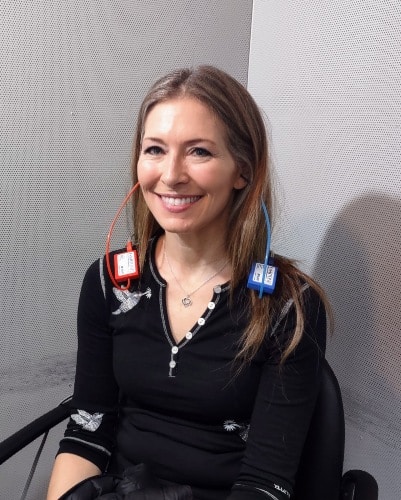
Keep in mind that some of the less expensive devices don’t have the detailed programming options necessary for many types of hearing loss. These include certain OTC hearing aids (including Audien) as well as personal sound amplification products (PSAPs), which are not true hearing aids. PSAPs make all sounds louder, but they aren’t able to target the specific frequencies where hearing loss has occurred or filter out background noise.
If you aren’t sure what type of hearing aid you need, speak with an audiologist or hearing aid specialist who can provide guidance.
Our reviews team interviewed Jacquelyn C. J. Lovitt, a practicing doctor of audiology, to help explain the costs associated with different types of hearing aids.
Buying OTC hearing aids
As mentioned above, many stores that carry health devices also sell OTC hearing aids. Check the list below to see if any of the following retail stores are in your area:
Best Buy CVS Walgreens Walmart Victra Verizon
You can also purchase hearing aids online from companies that offer quality OTC hearing devices at lower prices. Some OTC hearing aid manufacturers provide virtual consultations with an audiologist for personalized recommendations and adjustments along with your purchase.
Which is better: In-the-ear or behind-the-ear hearing aids?
Hearing aids come in several styles, including behind-the-ear and in-the-ear. Finding the best device for you depends on several factors.
A behind-the-ear (BTE) hearing aid sits behind your ear with a plastic earmold that fits into the outer ear. The case that sits behind your ear holds all the electronic parts necessary to make it work. BTE devices are bigger, so they are typically easier to use and handle, making them a good choice for kids and older adults.
They’re also able to hold a larger battery, which provides a longer battery life. Plus, the bigger size makes them more durable and able to provide more features. BTE hearing aids serve a range of ages and hearing loss. They are appropriate for all ages and work well for anyone with mild to profound hearing loss.
In-the-ear (ITE) hearing aids fit inside the ear, either partially or completely, and work well for mild to severe hearing loss. Some ITE devices come with a telecoil, which is a small magnetic coil enabling you to hear sound through the circuit rather than the hearing aid’s microphone.
Telecoils can improve the quality of phone conversations and help you hear in facilities equipped with hearing loops, like auditoriums and places of worship. ITE hearing aids are smaller than BTE or RIC devices, but they are still bigger than nearly invisible options like a completely-in-the-canal (CIC) or invisible-in-canal (IIC) hearing aid.

How to care for your hearing aids
Maintaining and taking care of your hearing aids will ensure they function properly and have a long battery life. You should clean your devices regularly, according to the manufacturer’s instructions, as substances like ear wax and fluids, including ear drainage, can cause damage to your hearing aids. You should also avoid moisture (especially if your devices are not water resistant), as well as high temperatures. It’s also best to remove your hearing aids when using hair products. When it comes to battery life, make sure you change disposable batteries as soon as they die and turn off your hearing aids whenever they are not in use.
The future of hearing aids
With so many advances in technology, it’s no surprise the future of hearing aids is especially bright. Manufacturers continue to innovate to offer consumers the best hearing solutions possible through state-of-the-art sound technology.
For example, according to the National Institute on Deafness and Other Communication Disorders, researchers are heavily invested in learning how to apply new signal processing tactics to hearing aids . Additionally, computer-aided technology systems are being utilized to improve design components. New ideations surrounding improved sound transmission and reduced background noise are also underway. [13] National Institute on Deafness and Other Communication Disorders. Hearing Aids. Oct. 11, 2022. Found on the internet at https://www.nidcd.nih.gov/health/hearing-aids
Still, studies focused on how to choose and fit hearing aids for certain groups of people, including children, are in the works, with scientists running directional microphone tests on the ear structure of a tiny fly.
Additionally, the use of Bluetooth connectivity continues to advance with major hearing aid makers because it improves our daily quality of life. Some brands offer multi-device streaming and connectivity so you can switch seamlessly from your smartphone to your television. It won’t be long before more brands implement better Bluetooth features, too. With Bluetooth and smartphones top of mind, we can expect a more upgraded smartphone app experience as well.
Plus, well-known hearing aid brands, like Starkey, Oticon, and Widex, are already using artificial intelligence (AI) features for auto-adjustment, user inputs, and to power natural sound. And it won’t be a surprise if big brand collaborations are in store from household names, like Apple and Samsung, which are already extremely sound-oriented.
The rise in popularity of telehealth services now includes hearing health care, too. When it comes to methods of shopping for hearing aids, we expect more companies to begin offering full-service in-home prescription hearing aids to consumers, with models similar to hear.com.
Frequently asked questions
There are five main types of hearing aids:
- Completely-in-canal (CIC) : The smallest type, CIC devices sit completely within the ear canal, with a tiny string that hangs outside your ear so you can remove them easily.
- In-the-canal (ITC) : These devices also sit in the ear canal, but are larger and a bit more visible than CICs.
- Behind-the-ear (BTE): BTE devices have an earmold that rests behind your ear, with a plastic tube that hooks over your ear and runs into your ear canal to transmit amplified sound.
- Receiver-in-canal (RIC): RIC devices, also known as receiver-in-the-ear (RITE) or mini behind-the-ear (mBTE), sit behind the ear like the BTE type, but are often smaller and less visible.
- In-the-ear (ITE): ITE devices sit completely within the ear like the CIC, but are larger, making them easier to handle but more visible.
According to our Reviews Team testing, Lexie was the second highest scored OTC hearing aid, right behind our “Top Pick” Jabra Enhance. Among prescription brands, Oticon earned the highest score for its advanced technology, variety of styles, and feature-rich smartphone app.
Jabra Enhance is our Reviews Team’s “Top Pick” for the company’s combination of quality, powerful devices, and ongoing customer support from an audiology care team (depending on the package you purchase). But keep in mind that the best hearing aid for you will depend on several factors, such as your degree of hearing loss, your lifestyle and preferences, and your budget.
Crackling, or static noise in your hearing aids, usually signals that your devices need maintenance—the battery may be low or there could be a buildup of moisture, earwax, or dirt in your hearing aid. When you hear a crackling, first try repositioning your hearing aids. If that doesn’t work, flush your ear canal with an earwax remover and clean your hearing aids thoroughly. If the problem persists, go to a hearing clinic or contact your device manufacturer for assistance.
Unless a doctor or audiologist has recommended hearing aids, you may not know if you need them. But if you’re noticing that you have trouble hearing in one or both ears, it may be time to consider hearing aids. Your spouse, other family members, and/or friends may have also noticed your difficulties with hearing and recommended hearing aids as a solution.
Some signs of hearing loss to be aware of, according to the Mayo Clinic, include: [14] Mayo Clinic. Hearing Loss. Found on the internet at https://www.mayoclinic.org/diseases-conditions/hearing-loss/symptoms-causes/syc-20373072
- Feeling the need to speak loudly
- Requiring audio devices to be turned up louder than normal
- Asking people to repeat themselves because you can’t hear or understand them
- Straining to hear
- Hearing better out of one ear
- Having difficulty hearing people on the phone
- Noticing that certain sounds and voices are muffled
If you’re experiencing any signs or symptoms of hearing loss, consider seeing an audiologist or hearing specialist. They can conduct a hearing exam to determine the degree of your hearing loss and provide a recommendation for different hearing aid styles and brands.
Even the most advanced hearing aids will not completely restore your hearing to its previous level. Instead, hearing aids are designed to maximize your hearing potential, especially in challenging listening situations.
Although they serve as an excellent tool to help retrain your brain to interpret sounds and filter others out, hearing aids can’t totally restore your hearing.
Hearing aids either use a rechargeable battery that comes with the hearing aid or a standard disposable battery. If the hearing aids use disposable batteries, make a note of the size. In general, standard hearing aid batteries come in four sizes: 10, 13, 312, and 675. You can purchase hearing aid batteries at pharmacies, retail stores, or directly from the hearing aid company.
Most rechargeable batteries are unique to the hearing aid. If you need a new rechargeable battery or charger, buy it directly from your hearing aid company.
You can have hearing loss in one or both ears. But most people have hearing loss in both ears. If you are in this category, experts recommend that you wear bilateral hearing aids —one in your left ear and one in your right ear. [15] Harvard Health Publishing. One Hearing Aid or Two? Found on the internet at https://www.health.harvard.edu/diseases-and-conditions/one-hearing-aid-or-two
Your brain receives signals from both ears, so it’s easier to process the noise into sound if it is getting information from both ears. However, many hearing aids can be programmed separately to accommodate the loss in each ear.
In-the-ear (ITE) hearing aids are custom-made devices designed to fit inside the ear, either partially or completely, and are suitable for individuals with mild to severe hearing loss. These hearing aid styles are less bulky than behind-the-ear (BTE) styles, but still larger and more noticeable than completely-in-the-canal (CIC) hearing aids.
While ITE devices are generally easier to insert, handle, and control than CIC styles, they do require an adjustment period. Some people experience discomfort during the first few weeks of use, often because they are new to wearing hearing aids, but also because they’ve become accustomed to the way other hearing aid styles feel in their ears, especially BTE styles. With time, most people find ITE styles comfortable and easy to wear.
In-the-ear hearing aids may come with a larger variety of features than smaller, nearly invisible devices are able to provide because they have more room for technology inside their casings, like telecoil for enhanced sound during phone conversations and public events. But they also have some drawbacks. ITEs may require more frequent cleaning due to earwax buildup, and are more prone to feedback issues than some models. ITE styles are not recommended for young children or those with profound hearing loss.
Adjusting to your new hearing aids takes time. For some people, getting used to wearing hearing aids happens within a few days. For others, there is an adjustment period that may take a few months.
In general, you should notice a difference right away. If you’re having problems, contact the hearing center or online retailer that sold you the hearing aids. They can provide tips and guidance to help with the fit and improve your hearing aid experience.
All hearing aids work to some degree. The style, size, and features determine how well they work for each type of hearing loss.
The advantage of small hearing aids is the almost invisible appearance they provide. Research shows that many people, especially older adults, associate hearing loss and hearing aids with stigma related to perceived feelings of lower cognitive ability, ageism (that hearing aids or hearing loss make them feel older), and vanity (that hearing aids or hearing loss make them look older).
Because they go in your ear, smaller hearing aids may not be a good fit for everyone’s ear canal. That’s why it’s a good idea to go to a professional to get fitted. Small hearing aids may also require more battery changes since they can only hold a small battery, and the compact size may result in fewer features.
If you buy one single hearing aid, the average cost is about $2,300, with the full range at $1,000–$4,000. For more severe hearing loss, the price of one hearing aid can cost up to $6,000.
Hearing aids are a substantial investment, and finding an affordable hearing device is a high priority for many people. Most companies offer several models at different prices.
If you’re looking for a hearing aid brand that consistently sells lower-priced products, MDHearing and Audien are both great places to start. In general, MDHearing devices range in price from $200–$800 for a single hearing aid and $400–$1,000 per pair. Audien carries even lower-priced hearing devices, ranging from $99–$249 per pair.
Visit NCOA’s Hearing Health page for more resources on hearing health for older adults.
If your doctor orders a hearing exam to determine whether you have hearing loss, the exam will be covered by Medicare Part B. This hearing test will help you figure out whether you need a hearing aid. But neither Medicare Part A or Medicare Part B (also known together as Original Medicare) will cover the cost of your hearing aids. Original Medicare also doesn’t provide coverage for routine hearing tests, fittings, or adjustments.
Although Medicare Part D doesn’t cover the cost of hearing aids, some Medicare Advantage plans (also known as Medicare Part C) do provide partial coverage. If you’re not familiar with Medicare Advantage plans, these are alternate ways of receiving Medicare coverage through private insurance companies, in place of Medicare Part A and B.
While Medicare Advantage plans may offer additional services, such as vision, dental, or hearing coverage, you might be restricted to a local coverage area. It’s important to understand what the Medicare Advantage plans cover and don’t cover before you make a decision during the Medicare open enrollment period.
For more help navigating Medicare, see the Medicare Guidance section of NCOA’s Age Well Planner . With in-depth information on Medicare basics, coverage, costs, and more, it’s a great resource for getting the most benefits out of your Medicare plan.
NCOA continues to advocate for Medicare coverage of hearing aids . NCOA also encourages you to contact your members of Congress to urge them to add hearing aid coverage to Medicare. To find out who your member of Congress is and how to contact them, visit house.gov to Find Your Representative .
The best hearing aids are those customized to your specific hearing loss, lifestyle, and preferences. Consulting with a hearing care professional, like an audiologist, is crucial to assess your hearing and recommend suitable options that are within your budget.
Consider your daily environment, occupation, and desired features. The right hearing aid should fit comfortably enough to wear all day. Ultimately, the best hearing aid is one you’re willing to wear consistently, enhancing your daily life without discomfort.
Proper maintenance is essential in extending the life of your hearing aid. Some tips include cleaning as instructed by the manufacturer, keeping the device away from moisture and out of the heat, not using hair styling products while wearing your hearing aid, and keeping small devices and batteries away from children or pets. Additionally, make sure to replace disposable batteries in a timely manner and turn off your device when it’s not being used.
On average, hearing aids last about three to seven years. How well you maintain your hearing aids will impact their lifespan, but it also depends on their construction and how much wear and tear they experience from being worn each day.
Adjusting to hearing aids takes patience. The transition can take a few days to several months, so give yourself time to adapt, and visit your hearing-care professional for adjustments as needed. It’s important to remember that hearing aids aren’t able to restore your hearing to its original state but to enhance it. Hearing professionals advise users to wear their hearing aids as often as possible and in different settings, whether watching TV at home, walking in the neighborhood, or dining in a busy restaurant, to help your brain readjust to the sounds it was missing.
If you find the adjustment period challenging, schedule a follow-up with your hearing specialist. They can tweak your device settings or suggest a different style that better suits your needs. Remember, even a minor adjustment to your hearing aids can make a significant difference in comfort and performance.
Costco hearing aids are often more affordable than other retailers due to Costco’s business model. They can offer lower prices by buying hearing aids in bulk directly from manufacturers. Costco then sells hearing aids to members at a discounted rate. Learn more about the best Costco hearing aids , including features and pricing.
Have questions about this review? Email us at [email protected] .
- Centers for Disease Control and Prevention. Facts About Falls. Found on the internet at https://www.cdc.gov/falls/facts.html
- John Hopkins Medicine. Hearing Loss Linked to Three-Fold Risk of Falling. Feb. 27, 2012. Found on the internet at https://www.hopkinsmedicine.org/news/media/releases/hearing_loss_linked_to_three_fold_risk_of_falling
- Rock Health. Consumer Adoption of Digital Health in 2022: Moving at the Speed of Trust. Feb. 21, 2023. Found on the internet at https://rockhealth.com/insights/consumer-adoption-of-digital-health-in-2022-moving-at-the-speed-of-trust/
- U.S. Food and Drug Administration. Types of Hearing Aids. Found on the internet at https://www.fda.gov/medical-devices/hearing-aids/types-hearing-aids
- Federal Register. Medical Devices; Ear, Nose, and Throat Devices; Establishing Over-the-Counter Hearing Aids. Found on the internet at https://www.federalregister.gov/documents/2022/08/17/2022-17230/medical-devices-ear-nose-and-throat-devices-establishing-over-the-counter-hearing-aids
- OTC Hearing Aids: What You Should Know. U.S. Food & Drug Administration. May 3, 2023. Found on the internet at https://www.fda.gov/medical-devices/hearing-aids/otc-hearing-aids-what-you-should-know
- National Institute on Deafness and Other Communication Disorders. Over-the-Counter Hearing Aids. Found on the internet at https://www.nidcd.nih.gov/health/over-counter-hearing-aids
- Smith, D, et al. Acceptability, Benefits and Costs of Early Screening for Hearing Disability: A Study of Potential Screening Tests and Models. November 2007. Found on the internet at https://www.journalslibrary.nihr.ac.uk/hta/hta11420/#/full-report
- National Institute on Deafness and Other Communication Disorders. Quick Statistics About Hearing. Found on the internet at https://www.nidcd.nih.gov/health/statistics/quick-statistics-hearing
- Wallhagen, Margaret. The Stigma of Hearing Loss. The Gerontologist. February 2010. Found on the internet at https://academic.oup.com/gerontologist/article/50/1/66/692298
- Centers for Disease Control and Prevention. Understanding Hearing Loss. Aug. 7, 2023. Found on the internet at https://www.cdc.gov/ncbddd/hearingloss/parentsguide/understanding/understandinghearingloss.html
- Mayo Clinic. Hearing aids: How to choose the right one. Found on the internet at https://www.mayoclinic.org/diseases-conditions/hearing-loss/in-depth/hearing-aids/art-20044116
- National Institute on Deafness and Other Communication Disorders. Hearing Aids. Oct. 11, 2022. Found on the internet at https://www.nidcd.nih.gov/health/hearing-aids
- Mayo Clinic. Hearing Loss. Found on the internet at https://www.mayoclinic.org/diseases-conditions/hearing-loss/symptoms-causes/syc-20373072
- Harvard Health Publishing. One Hearing Aid or Two? Found on the internet at https://www.health.harvard.edu/diseases-and-conditions/one-hearing-aid-or-two
6 Best Hearing Aids, According to Health Experts
Fight hearing loss with instant sound amplification.
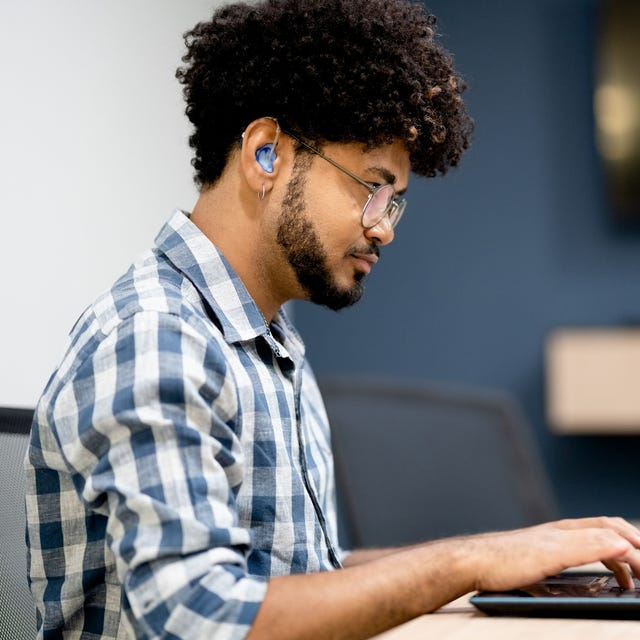
We've been independently researching and testing products for over 120 years. If you buy through our links, we may earn a commission. Learn more about our review process.
Our top picks:
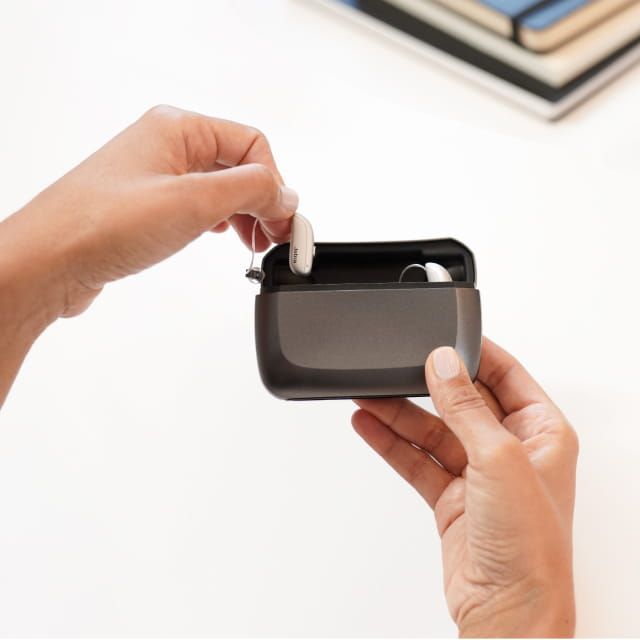
Best Overall Hearing Aids
Jabra enhance select 300.

Best Value Hearing Aids
Mdhearing air.
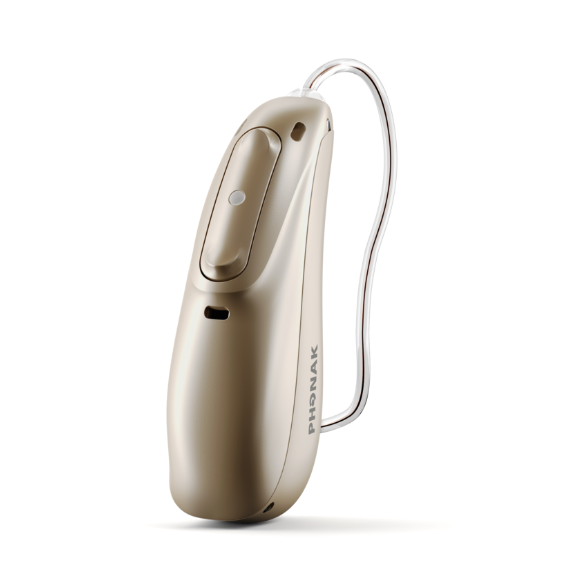
Best Prescription Hearing Aids
Yes hearing phonak audeo lumity.
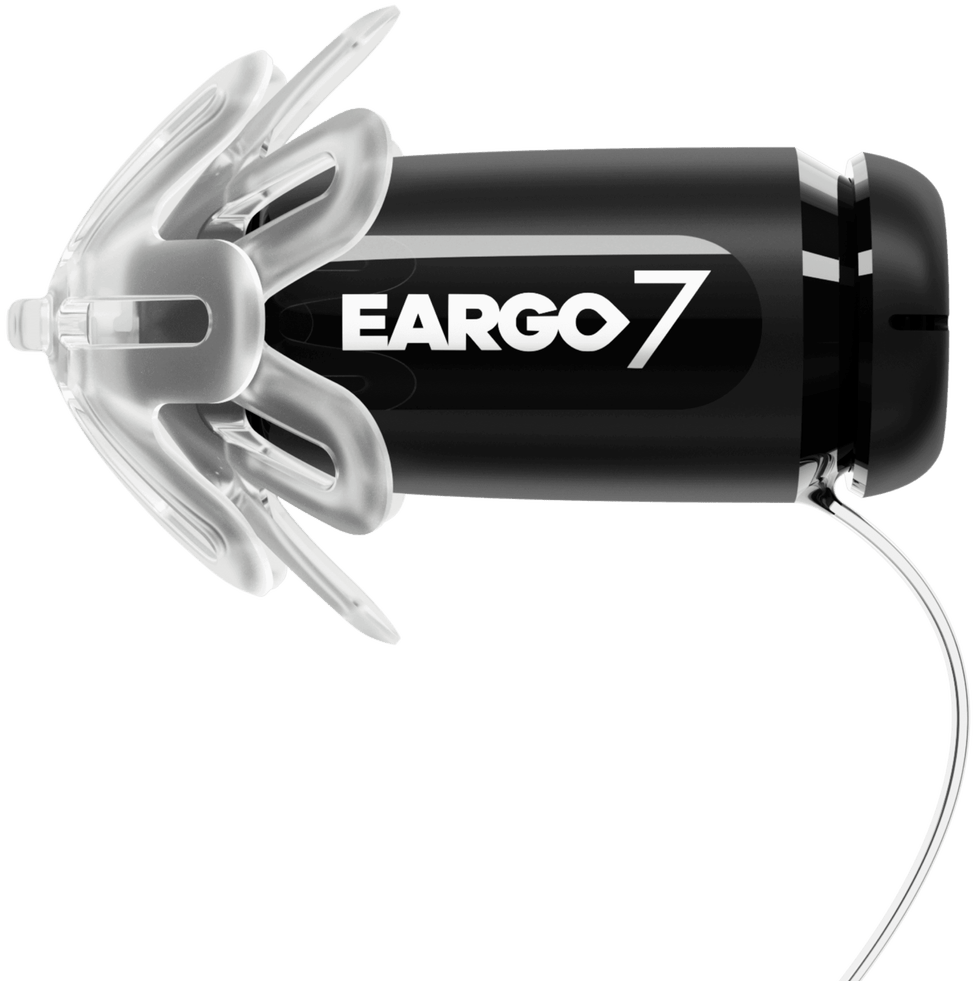
Best Compact Hearing Aids
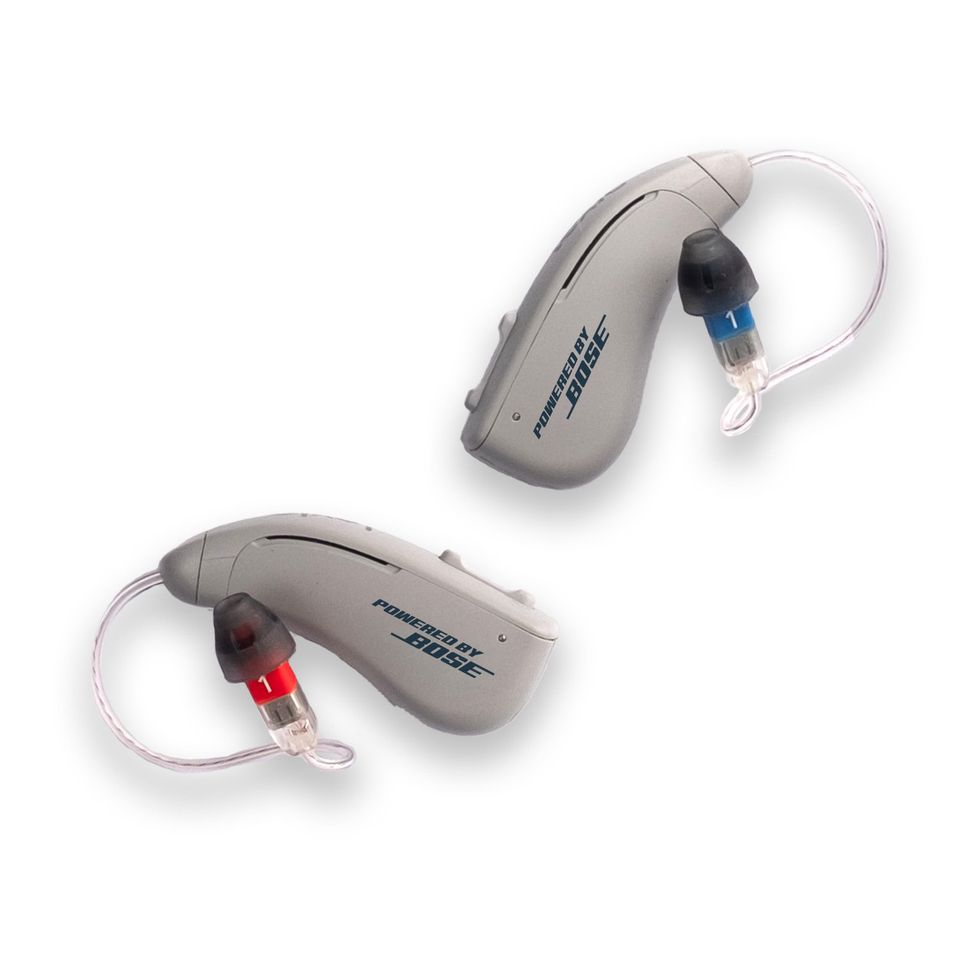
Best Customizable Hearing Aids
Lexie b2 plus.

Best Slim Hearing Aids
Signia styletto ax.
Our product analysts test health devices of all sorts, from knee braces and orthotic insoles to portable wheelchair ramps and more. When selecting the best hearing aids available today, we relied on our years of expertise covering health and interviewed industry professionals like audiologists to help you know what to look for when choosing the best hearing aids for you and your individual needs. According to our pros, these are the best hearing aids to consider in 2024, including OTC hearing aids, prescription hearing aids and other popular styles with positive consumer reviews.
Once you’ve checked out our top picks, continue reading to learn more about the different types of hearing aids and what to look for when shopping for your new device.
These OTC hearing aids will help those with hearing loss prioritize speech in noisy settings, like a busy office or restaurant, via Jabra's SoundScape technology. Though they may seem pricey, they're Jabra's most premium pair so you can expect the best sound quality and amplification .
Not only is the device sleek and stylish, but it's available in various finishes so you can choose one to your liking, including sparkling silver, champagne, gold, bronze and warm gray. Each pair of hearing aids comes with a carrying case that will provide three full charges, according to the brand, for days when you're busy traveling or can't get to an outlet. Plus, your purchase comes with a free 100-day trial. For even more perks, consider opting for the premium package for $200 more that comes with a three-year warranty, custom-programmed hearing aids according to your needs and app compatibility to adjust settings.
Improving your hearing doesn't have to set you back thousands. Our pros recommend these OTC hearing aids if you're looking for the best deal without sacrificing performance . While they're not as feature-rich or attractive as other pairs you'll find, you can purchase left or right ears separately or both pairs for even less.
The beige hearing aid sits behind your ear where you can make quick sound adjustments, while the clear tip should look discreet inside your ear. Claimed battery life is up to 12–16 hours, with up to three full charges provided from the carrying case so you can always stay connected. Our pros do warn, however, that Bluetooth connectivity isn't available with this model so you won't be able to connect your hearing aids directly with your phone's audio.
You'll have to visit an audiologist or hearing care professional to get a quote for these prescription hearing aids that are suitable for anyone with mild to profound hearing loss. They're an excellent choice if you're seeking some of the best customer care, customization and quality . With your purchase, the team at Yes Hearing will connect you with a local professional for a fitting, and then hearing aids will ship straight to your home. You'll also be eligible for follow-up hearing care. On top of the device's sleek design, our tech pros appreciate that thanks to universal Bluetooth connectivity you can stream calls, music, podcasts and more.
If there's one thing these Eargo hearing aids have going for them, it's their tiny, compact size that's virtually invisible once inside your ear. Because they're OTC, you can skip any in-office visits and use Eargo's "Sound Match" to self-fit and find the right fit for you. When it comes to battery life, these hearing aids feature 16 hours on one charge according to the brand, though the carrying case provides up to two days total of on-the-go charging.
Best of all, the Eargo 7 are waterproof and can stand up to humidity, thanks to their IPX7 rating, meaning they've been tested to be submerged in up to 1 meter of water for 30 minutes. While these are pricey for an OTC hearing aid, each purchase comes with a two-year warranty.
Bose is a reputable name in the audio industry for its clear, refined sound, so it's no surprise that these OTC hearing aids powered by Bose earn a spot on this list. What sets this pair apart is the customization to your hearing level. Before wearing the device, you'll take an in-app hearing test to create a unique hearing profile. While we haven't tested the app yet, consumers share that it's easy to use and intuitive.
Like other hearing aids, these feature Bluetooth connectivity so you can connect your hearing aids to your iPhone and take calls (though you won't be able to stream music or connect to Androids). And in case you're worried about battery life, rest assured that the charging case provides an extra 18 hours when you're on the go. It's only available in gray, however each purchase includes a one-year warranty.
Signia claims that these hearing aids offer a refined fit, and our experts couldn't agree more. Not only is this device slim and discreet, fitting nicely behind your ear, but you can look forward to top-notch quality and several gorgeous finishes like black/fine gold, black/graphite, white/rose gold and much more. S uitable for mild to severe hearing loss, these prescription hearing aids require a consultation with a local hearing care professional before you can purchase them.
Our pros love that the feature-rich Styletto AX has some of the best battery life of any of the hearing aids on this list, with up to 20 hours on each charge and wireless charging capabilities. You'll also get up to four additional days of recharging from the carrying case so you can go about your day freely. Our tech experts point out that the device connects to both Android and iPhone for seamless streaming from the device of your choice.
How we choose the best hearing aids

When narrowing down the best hearing aids on the market, the experts at the Good Housekeeping Institute researched the most popular models available today and scoured online consumer reviews. We reviewed each pair for specifications such as style, battery type, connectivity and any warranties of free trials, also taking price and extra features into consideration. Lastly, we interviewed two industry professionals to learn more about what to consider when shopping for hearing aids.
How do hearing aids work?

"The basic idea is that sensitive microphones pick up all the sounds around you and play them into your ear louder to help you hear them," says Sabrina Lee , audiologist at HearUSA, a network of 4,000 independent Hearing Care Professionals and more than 350 HearUSA centers. Though modern hearing aids are much more complex and factor in levels of loss, acoustics of the ear and listening preferences to customize the sound to your specific needs, each hearing aid has the same purpose — to help you cope with hearing loss and communicate more effectively.
Rajarshi Pratihar , AuD, MHA, MBA, Director of Audiology with UTHealth Houston explains the technology behind hearing aids even further: “These electronic medical devices capture sound waves through a microphone, which then converts the sound into digital code via an internal computer chip. This code is analyzed and adjusted based on an individual's hearing loss, and then converted back into sound waves delivered directly into the ear through a speaker, also known as a receiver. This personalized approach helps enhance the sounds that users find difficult to hear, improving speech, understanding and environmental awareness."
What’s the difference between prescription vs. OTC Hearing Aids?

There are several notable differences between prescription hearing aids and over-the-counter (OTC) hearing aids.
" Prescription hearing aid s are for any level of hearing loss — from mild to profound — and are professionally fitted by trained professionals who test hearing through advanced diagnostic tools and validate the proper function of the device based on normative data and years of experience," says Lee. While these devices tend to be initially more expensive, she explains that when an individual purchases prescription hearing devices, they are also often purchasing several years of in-office service and product warranty.
OTC hearing aids, on the other hand, do not r equire professional hearing evaluations or programming adjustments and are intended for customers 18+ only. “ OTC hearing aids provide general amplification suitable for perceived mild to moderate hearing loss, making them more affordable and accessible with less personalized options,” says Pratihar. Though these hearing aids are a reliable option, they do come with certain limitations. "OTC devices are not suitable for those with hearing loss beyond moderate severity — a diagnostic term for the degree of impact on speech understanding that is obtained during a standard audiological evaluation," says Lee. She warns of potential drawbacks like inadequate testing and a lack of ongoing counseling. "Unlike eyeglasses, hearing aids require ongoing support from audiologists and specialists. Studies show that a lack of counseling on care and maintenance often leads to discontinued use due to discomfort or incorrect usage," she says.
Expert tip: When choosing between the two, double-check any information regarding warranty or returns. According to Pratihar, prescription hearing aids are designed to last five years and typically come with a trial period and a three-year full-service warranty and coverage for loss or damage. He explains that, on the contrary, FDA regulations do not mandate manufacturers to offer a warranty or return options for OTC hearing aids. Before making a purchase, it’s important to check each brand’s policies and to factor in any costs associated with ongoing care and maintenance of your hearing aids.
What types of hearing aids are there?
Most hearing aids are powered by rechargeable batteries, but the devices can come in various shapes, sizes and styles. “Each is designed to meet different aesthetic preferences and hearing needs,” explains Pratihar. These are some of the most popular styles you'll find:
- Behind-the-ear (BTE): This is the most common type of hearing aid design and it's extremely versatile, according to experts. It rests behind the ear with a tube that directs sound into an earpiece called an earmold in the ear canal. It’s suitable for most types of hearing loss, whether severe or mild.
- Receiver-in-cana l (RIC) or receiver-in-ear (RIE): These hearing aids “combine the benefit of a small, discreet device behind the ear with the powerful features of digital technology,” shares Lee. A speaker sits directly inside the ear (instead of behind your ear) and connects to the main unit by a thin wire. Both BTE and RIE hearing aids are appropriate for mild to profound hearing loss and can be as versatile as traditional BTE hearing aids.
- In-the-ear (ITE): Microphones, speakers and computer chips are stored in the shell of these hearing aids, which fit inside your outer ear. According to Lee, these devices can come in a custom style, where the housing of the hearing aid is made based on a mold of your own ear. Non-custom versions are also available, with tips similar to earbuds.
- In-the-canal (ITC): These custom-fit devices sit partly in the ear canal and are more discreet than BTE or RIC models. ITE and ITC devices are appropriate for mild to severe hearing loss.
- Completely-in-canal (CIC): These hearing aids are even more discrete, fitting fully in the ear canal.
- Invisible-in-canal (IIC): Even smaller than CIC, this style sits invisibly in the canal.
What to look for when shopping for hearing aids
Though selecting hearing aids is ultimately a personal decision, industry experts like Pratihar and Lee advise considering multiple factors before making a purchase.
✔️ Design: Don’t be embarrassed to consider aesthetics when picking out your hearing aids. “If you’re considering what device is ultimately going to become a huge part of your daily routine, you should pick something you’re comfortable with inside and out,” says Lee. She advises thinking about whether you prefer a discreet style that blends in with your hair or skin, or a hearing aid that looks modern and sleek.
✔️ Ease of use: Consider a style, like in-the-ear, that’s easier to put in and take out every day if you face dexterity issues or difficulty manipulating small objects.
✔️ Lifestyle: Individuals who frequently encounter challenging listening environments, like places with significant background noise, should opt for advanced or premium hearing aids with powerful noise reduction, like the ones on our list. Lee explains how noise reduction works: “The device will listen to the environment around you and search for speech over other noises like dishes clattering or the din of a crowded restaurant. When it finds noise, the hearing aid will try to reduce it while allowing mainly speech and other important information to be highlighted for you.”
✔️ Battery: Rechargeable hearing aids with extended battery life mean that you won’t have to recharge as frequently or constantly replace batteries. A rechargeable carrying case that provides battery life on the go is a huge bonus.
✔️ Connectivity: Thanks for Bluetooth connectivity, hearing aids can seamlessly connect to smartphones, TVs, computers, tablets and other devices to stream calls, music, podcasts or entertainment, significantly improving the user experience.
✔️ Waterproofing: If you live in a rainy or humid environment, you may need to consider hearing aids with waterproofing capabilities. “In areas with high humidity, a waterproof feature is essential to protect the device and ensure its durability,” says Pratihar.
✔️ Cost: Lee explains that the cost of hearing aids will vary depending on the level of technology you choose as well as whether your health plan offers coverage for the device itself and fittings and follow-ups. “The price range for hearing aids is broad, typically running from $1,000 to $4,000 per ear, based on the device's features, individuals’ specific requirements and services provided,” Pratihar says.
✔️ Extra features: Most modern hearing aids come with extra features such as tinnitus therapy, background noise reduction, high-quality streaming and Bluetooth capabilities, rechargeability and acoustic motion sensors, explains Lee. Pratihar adds that “ some hearing aids now integrate AI technology for seamless, real-time adjustments. These devices are capable of tracking steps and usage, and they can even detect falls, subsequently sending messages to loved ones.” It’s also worth noting that many of the latest hearing aid models are equipped with apps, which enable users to adjust their hearing preferences directly from their smartphones to meet their specific listening needs.
Why trust Good Housekeeping?

Good Housekeeping Institute Product Analyst and Writer Olivia Lipski covers gadgets, health and fitness, home, travel and more. She regularly collaborates with GH’s Wellness Lab to test and review wearables, health devices and more. Though she hasn’t tested hearing aids herself, she often covers the latest in audio as well as accessibility .
For this story, she spoke to Rajarshi Pratihar , AuD, MHA, MBA, Director of Audiology with UTHealth Houston, and Sabrina Lee , audiologist at HearUSA.
Olivia (she/her) is a media and tech product reviews analyst at the Good Housekeeping Institute , covering tech, home, auto, health and more. She has more than five years of experience writing about tech trends and innovation and, prior to joining GH in 2021, was a writer for Android Central, Lifewire and other media outlets. Olivia is a graduate of George Washington University, with a bachelor's degree in journalism, political science and French, and she holds a master’s degree in communications from Sciences Po Paris.

@media(max-width: 64rem){.css-o9j0dn:before{margin-bottom:0.5rem;margin-right:0.625rem;color:#ffffff;width:1.25rem;bottom:-0.2rem;height:1.25rem;content:'_';display:inline-block;position:relative;line-height:1;background-repeat:no-repeat;}.loaded .css-o9j0dn:before{background-image:url(/_assets/design-tokens/goodhousekeeping/static/images/Clover.5c7a1a0.svg);}}@media(min-width: 48rem){.loaded .css-o9j0dn:before{background-image:url(/_assets/design-tokens/goodhousekeeping/static/images/Clover.5c7a1a0.svg);}} Product Reviews

9 Best Adjustable Beds of 2024
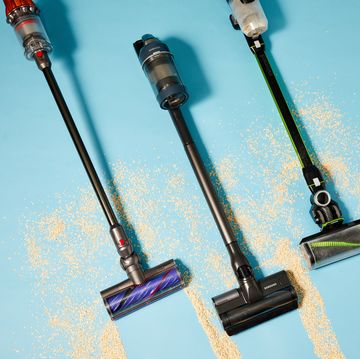
The Best Stick Vacuums
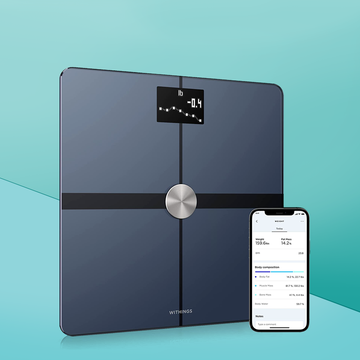
The Best Bathroom Scales, Tested & Reviewed

The Best Smart Notebooks to Buy in 2024

The 8 Best Iron Supplements

Shark Flexstyle vs. Dyson Airwrap Review
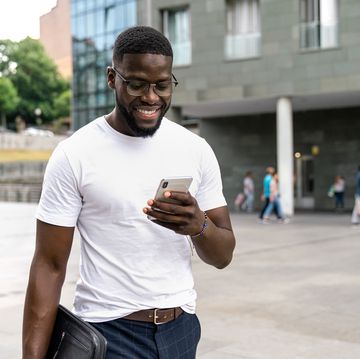
The Best White T-Shirts for Men

The Best Shoes for Nurses
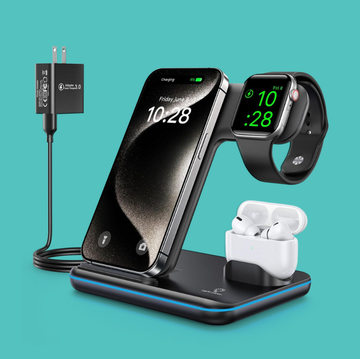
The Best Cool Office Gadgets

The Best Dethatchers
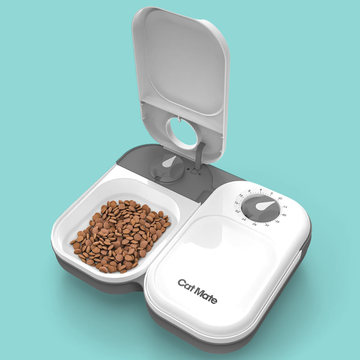
Best Automatic Cat Feeders
Ad-free. Influence-free. Powered by consumers.
The payment for your account couldn't be processed or you've canceled your account with us.
We don’t recognize that sign in. Your username maybe be your email address. Passwords are 6-20 characters with at least one number and letter.
We still don’t recognize that sign in. Retrieve your username. Reset your password.
Forgot your username or password ?
Don’t have an account?
- Account Settings
- My Benefits
- My Products
- Donate Donate
Save products you love, products you own and much more!
Other Membership Benefits:
Suggested Searches
- Become a Member
Car Ratings & Reviews
2024 Top Picks
Car Buying & Pricing
Which Car Brands Make the Best Vehicles?
Car Maintenance & Repair
Car Reliability Guide
Key Topics & News
Listen to the Talking Cars Podcast
Home & Garden
Bed & Bath
Top Picks From CR
Best Mattresses
Lawn & Garden
TOP PICKS FROM CR
Best Lawn Mowers and Tractors
Home Improvement
Home Improvement Essential
Best Wood Stains
Home Safety & Security
HOME SAFETY
Best DIY Home Security Systems
REPAIR OR REPLACE?
What to Do With a Broken Appliance
Small Appliances
Best Small Kitchen Appliances
Laundry & Cleaning
Best Washing Machines
Heating, Cooling & Air
Most Reliable Central Air-Conditioning Systems
Electronics
Home Entertainment
FIND YOUR NEW TV
Home Office
Cheapest Printers for Ink Costs
Smartphones & Wearables
BEST SMARTPHONES
Find the Right Phone for You
Digital Security & Privacy
MEMBER BENEFIT
CR Security Planner
Take Action
Best and Worst Places to Buy Hearing Aids
In CR's survey, we found out which hearing aid retailers provide the most satisfying shopping experience and the best value
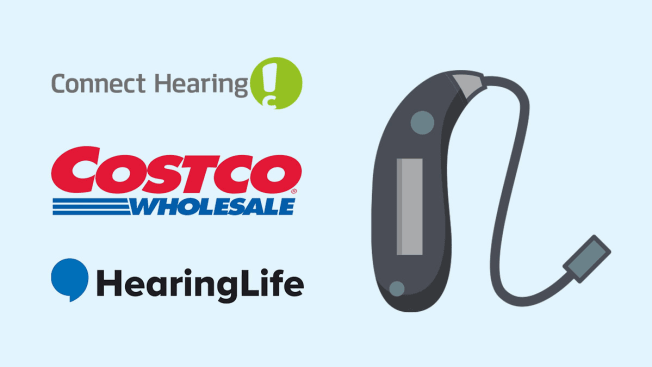
When you decide to buy hearing aids, one of the first steps is to figure out where you’re going to shop. With hearing aids now available over the counter, your options include not only an audiologist’s office or a licensed hearing aid dispenser but also online retailers and big-box stores.
Consumer Reports’ latest ratings of hearing aid retailers, based on our exclusive survey of 13,163 members, can help you figure out where you’ll get the best shopping experience.
Included in our newest ratings are 17 places to buy hearing aids: Amazon, Audibel, Beltone, Connect Hearing, Costco Wholesale, Eargo, ENT or otolaryngologist offices, Hear.com, HearingLife, HearUSA, hospitals or clinics, Jabra/Jabra Enhance, MD Hearing, Miracle-Ear, Sam’s Club, TruHearing, and the Veterans Administration. In our survey, CR members weighed in on their satisfaction with various aspects of their hearing aid purchasing experience, including the person who programmed their hearing aids, pricing options, cost transparency, selection, follow-up adjustment service, and more.
“Overall, CR members reported being generally pleased with the place where they bought their hearing aids,” says Adam Troy, a research program leader at CR who led our hearing aid brand and retailer survey. “Members who bought an OTC hearing aid tended to shop at online retailers like Amazon or OTC hearing aid brand websites like Eargo.com, and reported slightly lower levels of satisfaction with the experience than did members who bought a prescription aid.”
We also rated 17 prescription hearing aid brands and three OTC hearing aid brands . And we evaluated 10 models of over-the-counter hearing aids .
Here’s what we found out about the retailers in our survey; members can access our full hearing aid retailer ratings .
Become a member to read the full article and get access to digital ratings.
We investigate, research, and test so you can choose with confidence.
Sharing is Nice
We respect your privacy . All email addresses you provide will be used just for sending this story.
Jabra/Jabra Enhance (OTC)
Jabra/jabra enhance, mdhearing (otc), eargo (otc), hearinglife.
See All Ratings
Trending in Hearing aid retailers
Best and Worst Hearing Aid Brands
It's Confusing and Difficult to Shop for Hearing Aids. Here's How to Figure It Out.
Can PSAPs Help Your Hearing?
Smarter: Why You Should Dry Your Hands After Washing Them

Fortune Recommends™ Health is editorially independent. We may earn affiliate revenue from links in this content. Learn more .
Fortune Recommends™ is editorially independent. We earn a commission for purchases made from affiliate partners via some links on our site; other links are not affiliate partner links. Click here to read the full Fortune Recommends advertiser disclosure and how we earn commissions. Click here to read about our editorial policies and our methodologies.
Best hearing aids of 2024, according to experts
By Stephanie Hope
Medically Reviewed by Dr. Raj Dasgupta
Reviewed by Stephanie Hope
Fact Checked by Krista Manning

Written by Jennifer Walker-Journey, Fortune Recommends Writer
How we test.
Our rigorous review process involved evaluating over 30 different hearing aids across multiple factors, including performance, battery life, and comfort.
.st0{clip-path:url(#SVGID_00000046340743257271907690000000964648354283835324_);} Trusted experts
Our review is guided by the expertise of Dr. Raj Dasgupta, renowned for his clinical research and teaching excellence, and Krista Manning, known for her meticulous copy editing and advocacy for mental health awareness.
In a world of innovation and technology, it’s only fitting that hearing aids continue to advance at a remarkable pace. The landscape of hearing solutions has evolved dramatically ( 1 ), offering individuals with hearing loss the chance to embrace life with greater clarity and confidence than ever before ( 2 ). The expert review team set out to uncover the best hearing aids of 2024, exploring the latest offerings from leading manufacturers.
Our team of experts, audiologists, and consumers with hearing loss conducted a thorough evaluation of dozens of over-the-counter and prescription hearing aid models, scrutinizing their performance across various parameters, including sound quality, ease of use, design, connectivity options, and affordability.
Best hearing aid overall
The Jabra Enhance Select 300 hearing aids are our top pick for the best hearing aids overall because they have intuitive features, come with Bluetooth connectivity, and boast advanced sound processing and noise reduction. Our product testers also found them more comfortable to wear than several other hearing aids they tested.
Our picks for the best hearing aids in 2024
- Best overall: Jabra Enhance Select 300
- Best affordable: Audien Atom 2
- Best invisible: Eargo7
- Best for seniors: Lexie B1
- Best OTC: MDHearing
- Best Bluetooth: Lexie B2
Prescription
- Best for severe hearing loss: Phonak Audéo Lumity
- Best CROS: Signia Pure Charge&Go
- Best for tinnitus: ReSound Omnia
- Best rechargeable: Starkey Evolv AI
Compare hearing aids
Best hearing aid overall: jabra enhance – select 300.
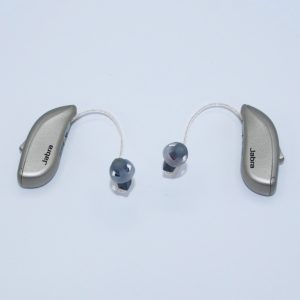
Jabra Enhance Select 300
Key product features.

What you should know
The Jabra Enhance Select 300 hearing aids emerge as the top pick for their unparalleled sound clarity, sleek design, and seamless Bluetooth integration, making them perform in challenging listening environments. Our extensive testing confirms their comfort and superior audio performance.
- During testing, our staff found them to be so comfortable that they thought they had misplaced them—but the devices were still in their ears.
- High price tag for an OTC hearing aid, but quality is on par with prescription brands.
- They are Jabra’s most inconspicuous model when worn, making them an attractive choice if you prioritize aesthetics and want your hearing aids.
- The Jabra Enhance Select 300 hearing aids are equipped with advanced sound processing and noise reduction features.
Why we like Jabra Enhance Select 300 as best overall
The Jabra Enhance Select 300 hearing aids stand out as a superb overall choice due to their advanced technology, discreet design, and user-friendly features. These hearing aids are designed to provide users with a remarkable auditory experience that combines clarity and comfort.
Jabra Enhance offers two Select 300 models: Basic, which comes pre-programmed to fit, set up, and manage yourself out of the box; and Premium, which is custom-programmed to your unique hearing needs.
One of the standout features of these hearing aids is their sleek and comfortable design. They are Jabra’s most inconspicuous model when worn, making them an attractive choice if you prioritize aesthetics and want your hearing aids to blend almost seamlessly into your daily life. During testing, the our staff found them to be so comfortable that they thought they had misplaced them—but the devices were still in their ears.
The Jabra Enhance Select 300 hearing aids are equipped with advanced sound processing and noise reduction features, which enhance sound quality and speech understanding in a variety of environments.
There are two other versions of the Jabra Enhance:
- Select 50: best for quieter situations like watching TV at home
- Select 100: for active lifestyles and tricky situations like conversations at a noisy restaurant
We like the Select 300 of all the models because it has the best sound processing. They’re ideal for the most complex listening situations, such as hearing multiple people at a loud gathering.
The Jabra Enhance Select 300 also comes with Bluetooth connectivity, allowing users to wirelessly connect to their smartphones and other devices. This feature enables you to stream phone calls, music, and other audio directly to their hearing aids, enhancing your overall listening experience and convenience.
However, our testers did find the music streaming to be a bit fuzzy on the Select 300. But this was a small downside to the benefits they enjoyed, such as ease of use, comfort, and listening quality.
Best affordable hearing aid: Audien Atom 2
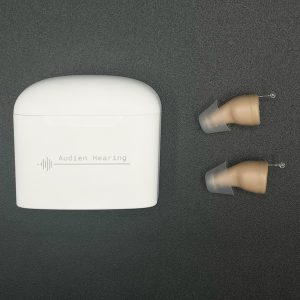
Best affordable hearing aid
Audien atom 2.

The Audien Atom 2 hearing aids deliver exceptional value for those with mild to moderate hearing loss, offering ease of use, comfort, and essential features like wireless charging and UV sanitation. This all comes at a budget-friendly price point without advanced technology or audiology support.
- After testing, our product reviewers noted that the hearing aids were easy to use and had straightforward features, such as four listening modes, a wireless charging case with additional charges, and a UV sanitation light.
- Audien is known for their affordable over-the-counter hearing aids, with some versions costing as little as $99 a pair.
- They’re a great option if you have mild to moderate hearing loss and are looking for a budget-friendly hearing aid.
- The hearing aids stay put—our testers didn’t notice them moving when they shook their heads.
Why we like Audien Atom 2 as best affordable
Audien is known for their affordable over-the-counter hearing aids, with some versions costing as little as $99 a pair. Their Atom 2 models are not much costlier—$189 or $289 for the pro—making Audien Atom 2 hearing aids a cost-effective option if you have mild to moderate hearing loss and are looking for budget-friendly hearing aids.
Audien’s Atom 2 hearing aids are their most powerful in-the-ear version. After testing, our product reviewers noted that the hearing aids were easy to use and had straightforward features, such as four listening modes, a wireless charging case with additional charges, and a UV sanitation light.
Our testers also found them to be lightweight and comfortable with none of that “congested” feel you get with some hearing aids. They also stay put—our testers didn’t notice them moving when they shook their heads.
The hearing aids may lack advanced features and technology, but you can still enjoy clear and comfortable hearing without the burden of a hefty price tag. However, you’ll also sacrifice audiology support.
What customers are saying
Amazon users like how the Atom 2 reduces background noise, that they are comfortable enough to wear all day, and that the controls are easy to use and settings easy to adjust.
“I’ve only owned these hearing aids for three days but they are working out for me quite well. The ease of use and the quality of sound is superior to anything else I have tried. They are comfortable to wear and easy to use with automatic on and off. I love the UV cleaning idea, and the small size of the charging case. The battery life is excellent.”
Jeannie M., Verified Amazon reviewer
“These are my first hearing aids,” begins verified Amazon reviewer Mike. “The manual was clear, straightforward, and complete. The hearing aids are very comfortable in place. There is some squeal as you put them in place but once in place it’s gone. I have mild to moderate hearing loss so I only needed the second of five volume levels. There are four different environments you can select: conversation, restaurants, TV, and outdoors. You can also change volume settings when they are in place since there are different tones for all of the settings. They work great.”
Best invisible hearing aid: Eargo 7

Best invisible hearing aid

The Eargo 7 hearing aids stand out for their virtually invisible design and advanced sound amplification, making them great for those seeking a discreet yet effective hearing solution. Despite minor sound quality issues, their ease of use and comfort are highly praised.
- Our product testers found the sound to be a bit tinny or echoey despite changing the noise reduction in the available app.
- The Eargo 7 hearing aids are easy to insert, remove, and clean, and they come with a convenient charging case.
- The Eargo 7 hearing aids are an exceptional choice if you’re looking for “invisible” hearing aids, thanks to their unique and discreet design.
- Eargo’s innovative design allows for natural sound amplification, preserving the nuances of speech and environmental sounds.
Why we Like Eargo 7 as best invisible
The Eargo 7 hearing aids are an exceptional choice if you’re looking for “invisible” hearing aids, thanks to their unique and discreet design. Like Eargo’s previous versions, its Eargo 7 devices sit deep within the ear canal, making them virtually invisible when worn. Their inconspicuous appearance addresses the cosmetic concerns if you prefer a discreet hearing solution ( 3 ), allowing you to regain your hearing without drawing attention to your ears.
Despite their small size, the Eargo 7 hearing aids offer impressive performance. They incorporate advanced technology that helps ensure you can hear comfortably in various environments. Additionally, Eargo’s innovative design allows for natural sound amplification, preserving the nuances of speech and environmental sounds while minimizing the discomfort or occlusion effect often associated with in-ear hearing aids.
The user-friendliness of Eargo 7 further enhances their appeal. They are easy to insert, remove, and clean, and they come with a convenient charging case. The Eargo 7 isn’t for everyone, though. Our product testers found the sound to be a bit tinny or echoey despite changing the noise reduction in the available app. But overall, they’re a good option if you’re more focused on a hearing aid that’s not noticeable.
Amazon customers like how small and discreet the Eargo 7s are—they sometimes forget they’re wearing them. They also like how much they improve the sound of people’s voices.
“The fit was easy and comfortable after trying different pedal designs. My hearing loss is moderate to severe. I can now hear conversations much better and have the ability to stay in the conversation without guessing what was said. The adjustability is great for many situations. I love my new hearing aids.”
Angus, Verified Amazon reviewer
“My experience with the Eargo 7 has so far been wonderful, boasts verified Amazon reviewer Linda. “I have had them for about three weeks, and I do wonder how I managed before them. Not only have they allowed me to hear extremely well, I love their invisibility, as well. I have always avoided wanting to wear hearing aids because I often wear my hair up and I did not want them to show. I did experience some soreness from wearing the hearing aids the first few days and maybe that’s because my ear canal is small or just wearing some in your ear takes some getting used to, but since then I usually forget they are there, but I never forget how well I hear now.”
Some negative reviews on Amazon note that the maintenance is too much for them to handle. Others note that they have a hard time fitting the hearing aids into their ears.
Best hearing aid for seniors: Lexie B1
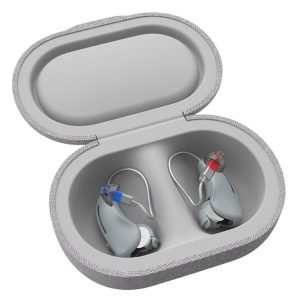
Best hearing aid for seniors

The Lexie B1 hearing aids, powered by Bose technology, excel in meeting the needs of older adults with their straightforward setup, user-friendly interface, and personalized sound adjustments, ensuring an enhanced listening experience without compromising on affordability.
- Our product testers found the setup to be very intuitive and the app easy to understand with plenty of images, videos, and graphics to explain how to fit the devices into your ears.
- Affordability is often a crucial factor for older adults, and Lexie B1 hearing aids often provide a cost-effective solution without sacrificing quality.
- The Lexie B1 hearing aids are an excellent choice for older adults because they are designed with the unique needs of seniors in mind.
- The Lexie B1s also feature user-friendly controls and interfaces, making them accessible and easy to operate if you are not very tech-savvy or have problems with dexterity.
Why we like Lexie B1 as best for seniors
The Lexie B1 hearing aids are an excellent choice for older adults because they are designed with the unique needs of seniors in mind. Our product testers found the setup to be very intuitive and the app easy to understand with plenty of images, videos, and graphics to explain how to fit the devices into your ears.
The Lexie B1s also feature user-friendly controls and interfaces, making them accessible and easy to operate if you are not very tech-savvy or have problems with dexterity. You can adjust settings and customize your hearing experience with minimal effort.
Additionally, the Lexie B1 is made by Bose, a powerhouse of sound innovation. These hearing aids have impressive Bose technology built right in.
The Lexie B1 also offers personalized sound adjustments, allowing you to fine-tune your hearing aids to match your specific hearing needs. This customization can significantly enhance speech clarity and overall sound quality, ensuring you can engage in conversations and enjoy various listening situations with ease.
Affordability is often a crucial factor for older adults, and Lexie B1 hearing aids often provide a cost-effective solution without sacrificing quality. They offer the opportunity to improve your hearing and overall quality of life without breaking the bank.
While the devices’ controls are user-friendly, one potential drawback for people with limited vision or dexterity may be the batteries. They can be difficult to change due to their small size and the hearing aids’ small battery doors.
Amazon users appreciate the sound quality and the comfortable fit. They also like how they work well in a variety of settings.
“Almost two weeks have passed since my Lexie B1 aids arrived and I could not be happier, boasts verified Amazon reviewer Jim. “They’re not uncomfortable at all, and I can hear! I am 68, and worked in a very noisy environment during my state trooper firearms instructor and siren above my head career. Sounds that I have not perceived in years are clear to me now. I found that the smaller ear bits are more comfortable and efficient than the larger bits. The other evening a pleasant female voice said ‘low battery’ in my ear which kept me from replacing batteries prematurely. The iPhone app is great and easy to use, although sometimes they might not connect but restarting the Bluetooth on the phone sorts that issue out. I wish I had been able to use these for the past ten years, as I have obviously missed a lot in conversation and surroundings. I am impressed with the quality and support. After all, they’re Bose! Color me ecstatic.”
“Besides being comfortable, I sometimes forget I’m wearing them and they definitely improved my hearing. The feature I like the most is the Bluetooth connectivity. The app connects flawlessly. I can do some customization but being able to adjust the volume, bass, and treble is a great feature. I love using the phone during a conversation without going to my ears and pushing buttons. I really thought I would be returning them within the trial period but I’m satisfied. The bluetooth feature has me hooked. I also like the battery powered ones not the rechargeable so I can replace the battery easily when I’m in a hurry.”
James, Verified Amazon reviewer
Many Amazon customers note having issues connecting to the app. Others note having trouble finding the right size for their ears.
Best OTC hearing aid: MDHearing
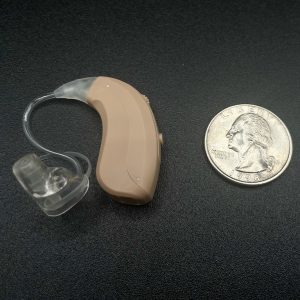
Best OTC hearing aid
MDHearing aids stand out for their affordability and ease of access, providing effective solutions for mild to moderate hearing loss. There is an added benefit of lifetime support from U.S.-based specialists, despite a slight learning curve for adjustments.
- The testers appreciated the straightforward controls and settings that empower you to make adjustments independently.
- MDHearing’s hearing aids are known for their low price point, offering a cost-effective option.
- Since they’re sold over the counter, you can purchase them without a prescription or an audiologist appointment.
- The testers found it difficult to learn some of the settings, like how to adjust the volume.
Why we like MDHearing as the best OTC
MDHearing aids have gained a reputation as a reliable brand in the over-the-counter (OTC) ( 4 ) hearing aid market, earning the trust of many individuals seeking affordable care. While MDHearing devices are sold over the counter, its hearing aids are backed by lifetime support from its U.S.-based audiologists and hearing aid specialists.
MDHearing’s hearing aids are known for their low price point, offering a cost-effective option if you’re looking to address mild to moderate hearing loss without breaking the bank. Since they’re sold over the counter, you can purchase them without a prescription or an audiologist appointment, making them a convenient choice for quick hearing improvement.
There are four MDHearing varieties currently on the market:
The NEO and NEO XS are in-the-ear (ITE) hearing aids, while the VOLT and AIR are behind-the-ear (BTE). They range in price from $297 to $397 per pair. All are designed with user-friendliness in mind. Our product testers have tested the NEO, VOLT, and AIR models. They appreciated the straightforward controls and settings that empower you to make adjustments independently.
However, they did find it difficult to learn some of the settings, like how to adjust the volume. Otherwise, once they got used to the settings, they had few problems.
While MDHearing may not offer the same level of customization as prescription hearing aids, these devices still provide a noticeable enhancement in hearing clarity and quality, improving the overall listening experience.
Amazon customers like how MDHearing devices are easy to use, especially for older people with dexterity issues. The sound is clear with no echo. They say they work well for the modest price.
Verified Amazon reviewer William purchased the MDHearing AIR and says, “Overall, I really like these hearing aids. They are easy to charge, although you have to pay attention to make sure they are both charging. The controls are super easy. The sound is digital, meaning that it is a bit thin and sometimes shrill, but overall, it has good sound and very consistent. It does an excellent job of making voices easy to understand.”
“When turning the volume to the max, there is whistling. For average use it is okay.”
Don, Verified Amazon reviewer
“After several weeks, I have been extremely pleased with this product,” boasts verified Amazon reviewer Jim, “ I have slight hearing loss in one ear and moderate loss in the other. From the moment I put the MD hearing aids on, I realized what an amazing difference there was. I was hearing things that I didn’t even know that I was missing. The hearing aids are well made and the controls are easy to master and provide a wide range of volume and programs for various situations. Also, the batteries are rechargeable and that is a real plus. These are great over the counter hearing aids at a great price point. I am hearing things better than I have in years.”
Many negative Amazon reviews note a high-pitch noise in the hearing aids every time they try to adjust them.
Best Bluetooth hearing aid: Lexie B2

Best Bluetooth hearing aid
Lexie b2 plus.

The Lexie B2 Plus hearing aids feature advanced Bose technology and seamless Bluetooth connectivity and provides exceptional sound clarity. The user-friendly app offers easy customization, making them a cost-effective choice for integrating hearing aids into a digital lifestyle without compromising on quality.
Our product testers found the clarity to be excellent. Setting up audio streaming on the B2 was a breeze. They also said the streaming sound quality is very strong and clear through their iPhones.
They do come at a higher price than their counterpart, the Lexie B1 ($849 vs. $999, respectively). However, they’re still a cost-effective option, as some hearing aids can cost $2,000 or more.
The Lexie B2 Plus hearing aid emerges as an excellent choice for those seeking a Bluetooth-enabled hearing aid due to its blend of cutting-edge technology and user convenience.
- Bluetooth connectivity allows you to wirelessly pair your hearing aids with a wide range of devices, including smartphones, tablets, and televisions.
Why we like Lexie B2 as best Bluetooth
Like the Lexie B1, the Lexie B2 is equipped with powerful Bose sound technology and Bluetooth connectivity. Bluetooth connectivity allows you to wirelessly pair your hearing aids with a wide range of devices, including smartphones, tablets, and televisions. With the Lexie B2 Plus, you can effortlessly stream audio directly to your hearing aids, enhancing your listening experience for phone calls, music, and video content.
The Lexie B2 Plus hearing aids also come equipped with user-friendly apps that enable you to control and customize your hearing experience via your smartphone. This level of personalization ensures you can adapt their hearing aids to suit your specific preferences and listening environments with ease.
Additionally, the Lexie brand’s commitment to affordability makes the Lexie B2 Plus hearing aids an attractive option for those seeking Bluetooth-enabled devices without breaking the bank. This combination of advanced connectivity, customization, and cost-effectiveness positions the Lexie B2 Plus as a top choice for anyone who wants to seamlessly integrate their hearing aids with their digital lifestyles while enjoying clear and comfortable sound.
Amazon users love the Bluetooth connectivity of the Lexie B2 Plus hearing aids and that it can stream music and calls, unlike the Lexie B1. They also like how well the app works with their devices.
Verified Amazon reviewer David F. says, “I’ve had them in for almost a week and I have no complaints. Feeling them in my ears is kind of weird and when I think about them I feel like I want to scratch my ears, but only if I’m thinking about them. I wore them while playing music with friends and they really helped in that regard. I could clearly hear my guitar and also my voice when I was singing. I no longer have to turn down the base and turn up the volume and treble on my sound system to understand a narrator reading an audiobook. The free Lexie app is very easy to use and they were easily set up for use. They charge in three hours and the charge is supposed to last for about 15 hours. Overall, I think it was a great investment. I’m very satisfied.”
“The sound quality is great. It is a little difficult to adjust/keep tuned in to individual needs without having to contact customer support, but I think that is due to a ‘technology deficit’ on our part, and nothing to do with the devices themselves. However, customer support were friendly, prompt, courteous, and knowledgeable. They were very professional and willing to help my husband learn and operate his new hearing devices in just one call. It has made a huge difference for him. Now he’s happy and realizes just how much he’s been missing.”
Shannon, Verified Amazon reviewer
Verified Amazon reviewer Tom notes that it takes time to adjust the volume settings to what works for you. He states, “These units do improve hearing overall. The higher frequencies, however, aren’t the sharpest. These are comfortable, and once the proper domes are selected, they work well all day long. The battery life is excellent, easily lasting at a useful level for an entire day. It does take some adjusting of the sound levels and bass and treble to get what works best for you. Overall I recommend these for anyone with moderate hearing difficulties.”
Best hearing aid for severe hearing loss: Phonak Audéo Lumity
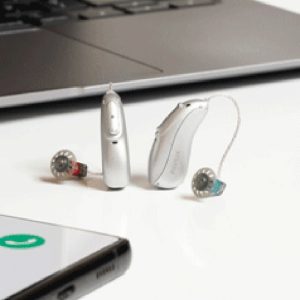
Best hearing aid for severe hearing loss
Phonak audéo lumity.
The Phonak Audéo Lumity hearing aids provide powerful amplification and exceptional clarity, particularly beneficial for individuals with severe hearing loss. They feature advanced speech enhancement technologies and customizable settings through a user-friendly app for improved communication in noisy environments.
- Our product testers found the multi-function button works great to transition between on/off, phone calls, flight mode, and Bluetooth connectivity.
- These hearing aids come with a range of customizable features, allowing you to fine-tune your devices to your unique preferences and specific hearing needs.
- The Phonak Audéo Lumity hearing aids are designed to provide powerful amplification and exceptional clarity, making them highly effective for those with significant hearing losses.
- The Audéo Lumity hearing aids feature adaptive programs and speech enhancement technologies, helping you better understand speech in noisy environments despite severe hearing loss.
Why we like Phonak Audéo Lumity as best for severe hearing loss
The Phonak Audéo Lumity hearing aids are designed to provide powerful amplification and exceptional clarity, making them highly effective in addressing the needs of those with significant hearing losses ( 5 ).
With their advanced technology and robust sound processing capabilities, the Phonak Audéo Lumity hearing aids can accommodate the greater amplification requirements that severe hearing loss often demands. They are a significant step up from Phonak’s Paradise line with added features to help improve your listening experience.
For example, the Audéo Lumity hearing aids feature adaptive programs and speech enhancement technologies, helping you better understand speech in noisy environments despite severe hearing loss. This can greatly improve communication and overall quality of life if you have struggled in challenging listening situations in the past.
These hearing aids come with a range of customizable features, allowing you to fine-tune your devices to your unique preferences and specific hearing needs. They are also compatible with the MyPhonak mobile app. This app allows you to track additional health data, such as total daily steps and heart rate.
Our product testers found the multi-function button works great to transition between on/off, phone calls, flight mode, and Bluetooth connectivity. But it is pretty small, so if you have difficulty using it, we suggest switching to the app to make these adjustments instead.
Best CROS hearing aid: Signia Pure Charge
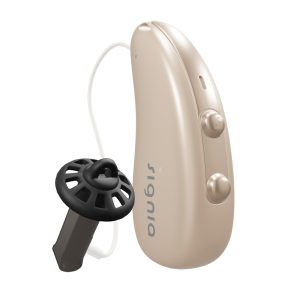
Best CROS hearing aid
Signia pure charge&go.
The Signia Pure Charge CROS hearing aids stand out for individuals with single-sided deafness. They offer innovative sound rerouting for improved sound awareness and speech understanding, coupled with the convenience of rechargeable batteries and Bluetooth connectivity for a more connected, effortless hearing experience.
The Signia Pure Charge CROS hearing aids are also equipped with lithium-ion rechargeable batteries, reducing the need for constant battery replacements. This feature is particularly beneficial if you have dexterity or mobility challenges.
- The Signia Pure Charge CROS hearing aids require a prescription. You must get an evaluation at a hearing clinic before you can buy them.
- These hearing aids excel in offering a seamless way to improve sound awareness and speech understanding for individuals with single-sided deafness.
- The Signia Pure Charge devices capture sound from the non-hearing ear and transmit it to the ear with better hearing, effectively bridging the gap and allowing you to hear sounds from all directions.
Why we like Signia Pure Charge as best CROS
For individuals with single-sided deafness or significant hearing loss in one ear, traditional hearing aids may not be as effective. Contralateral routing of signals (CROS) technology enables hearing aids to reroute sound between the deaf and hearing ears and can provide an innovative solution for unilaterally deaf individuals ( 6 ).
Our pick among CROS hearing aids is the Signia Pure Charge CROS. These hearing aids excel in offering a seamless way to improve sound awareness and speech understanding for individuals with single-sided deafness. It is a small, behind-the-ear device with Bluetooth connectivity. It’s designed to understand your personal hearing environment in greater detail to deliver sound catered precisely to your needs due to its auto-motion sensor technology.
The Signia Pure Charge devices capture sound from the non-hearing ear and transmit it to the ear with better hearing, effectively bridging the gap and allowing you to hear sounds from all directions. This innovative technology enhances overall sound awareness, making it easier for you to engage in conversations and navigate your surroundings more effectively.
Also, note that the Signia Pure Charge CROS hearing aids require a prescription. You must get an evaluation at a hearing clinic before you can buy them.
Best hearing aid for tinnitus: ReSound Omnia
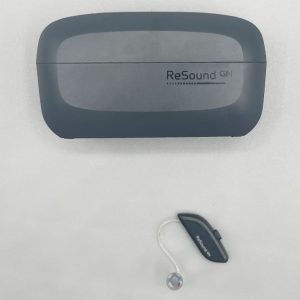
Best hearing aids for tinnitus
Resound omnia.

The ReSound Omnia hearing aids are specifically tailored for those suffering from tinnitus. They feature a built-in Tinnitus Sound Generator and a range of soothing sounds for effective symptom management, although their advanced features may present a learning curve for some users.
- Some users may find the ReSound Omnia more complex and difficult to use compared to other models.
- These hearing aids incorporate specialized features and technology to help manage and alleviate the symptoms of tinnitus, making them a valuable solution if you have both hearing loss and tinnitus.
- ReSound Omnia hearing aids are an outstanding choice if you’re dealing with tinnitus, a condition characterized by the perception of ringing, buzzing, or other noises in the ears.
- One key feature of ReSound Omnia hearing aids is their built-in Tinnitus Sound Generator (TSG). This feature allows you to choose from a variety of soothing, customizable sounds, such as white noise, ocean waves, or gentle melodies.
Why we like ReSound Omnia as best for tinnitus
ReSound Omnia hearing aids are an outstanding choice if you’re dealing with tinnitus, a condition characterized by the perception of ringing, buzzing, or other noises in the ears ( 7 ). These hearing aids incorporate specialized features and technology to help manage and alleviate the symptoms of tinnitus, making them a valuable solution if you have both hearing loss and tinnitus.
“Tinnitus is a condition that causes continuous ringing or buzzing in the ears. This can often lead to sleep deprivation in those who experience it,” states Dr. Raj Dasgupta MD, FACP, FCCP, FAASM. “The persistent ringing caused by tinnitus can make it difficult to fall asleep due to distraction and anxiety, resulting in both sleep deprivation and daytime drowsiness.”
One key feature of ReSound Omnia hearing aids is their built-in Tinnitus Sound Generator (TSG). This feature allows you to choose from a variety of soothing, customizable sounds, such as white noise, ocean waves, or gentle melodies. These sounds can be adjusted to your preference and mixed with their amplified environmental sounds or streamed audio, effectively masking the tinnitus noise and providing relief.
“Sleep deprivation can also worsen tinnitus symptoms. People with tinnitus can improve their sleep by establishing a regular sleep schedule, creating a relaxing bedtime routine, and avoiding caffeine and alcohol before bed.”
Dr. Raj Dasgupta, MD, FACP, FCCP, FAASM, Expert reviewer
Furthermore, ReSound’s comprehensive app ecosystem provides tools to aid in tinnitus management. You can access these apps to further customize your tinnitus relief experience, allowing for real-time adjustments and personalization. However, some users may find the ReSound Omnia more complex and difficult to use compared to other models.
Best rechargeable hearing aid: Starkey Evolv AI
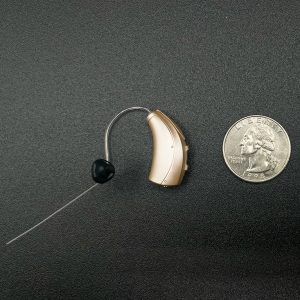
Best rechargeable hearing aid
Starkey evolv ai.
The Starkey Evolv AI hearing aids lead the pack with their eco-friendly rechargeable batteries and cutting-edge AI technology. They offer sound adaptation and health monitoring features, though they may require some patience to program.
- Evolv AI hearing aids also come equipped with artificial intelligence (AI) technology, which continuously adapts to your listening environments and preferences.
- Rechargeable hearing aids eliminate the need for regular battery replacements, making them eco-friendly and cost-effective in the long run.
- These hearing aids offer long-lasting battery life—up to 24 hours on a single charge—ensuring that users can enjoy uninterrupted hearing throughout the day.
- The Evolv AI also has fall detection and health-monitoring technology to help you keep track of your activity.
Why we Like Starkey Evolv AI as best rechargeable
The Starkey Evolv AI hearing aids are our top choice among hearing aids with rechargeable batteries due to their combination of advanced technology and convenience. Rechargeable hearing aids eliminate the need for regular battery replacements, making them eco-friendly and cost-effective in the long run. With the Starkey Evolv AI, users can enjoy a sustainable and hassle-free hearing solution.
One standout feature of the Starkey Evolv AI hearing aids is their powerful rechargeable battery system. These hearing aids offer long-lasting battery life—up to 24 hours on a single charge—ensuring that users can enjoy uninterrupted hearing throughout the day. The Evolv AI also has fall detection and health-monitoring technology to help you keep track of your activity.
Evolv AI hearing aids also come equipped with artificial intelligence (AI) technology, which continuously adapts to your listening environments and preferences. This smart technology enhances the overall listening experience, providing clear and natural sound quality. However, AI technology may make these hearing aids more difficult to program or adjust.
Our hearing aids testing methodology
Our methodology for testing hearing aids is designed to provide comprehensive insights into their performance, durability, and overall value. Our goal is to empower you with information that guides you toward making an informed decision when choosing the hearing aid that best fits your lifestyle and needs.
Performance (auditory effectiveness)—40%
This category is foundational in evaluating hearing aids as it directly relates to the device’s primary function: enhancing the user’s hearing ability. This category delves into the core functionality of hearing aids, scrutinizing how effectively these devices can amplify sound, improve speech intelligibility, and provide a natural listening experience across various settings and scenarios to meet the diverse needs of the users.
Here’s what we’re looking for:
- Sound quality
- Noise reduction
- Feedback control
- Programmability and connectivity
Features—30%
The features of a hearing aid encompass a detailed examination of the functionalities and technological innovations that distinguish each device. By evaluating the features of hearing aids, we aim to highlight the capabilities that contribute most significantly to improving the quality of life for individuals with hearing loss. The features of a hearing aid can directly impact user comfort, satisfaction, and, ultimately, the willingness to use the device consistently. We evaluate:
- Battery options
- Hearing loss range
- Wireless connectivity
- Water resistance
- Safety features
Evaluating hearing aids involves a comprehensive analysis of the device’s overall cost-effectiveness, affordability, and long-term benefits to the user. It directly impacts the user’s decision to purchase the hearing aid, balancing the financial investment against the expected improvements in hearing quality, lifestyle enhancements, and the array of features provided.
Value does not simply reflect the initial purchase price but incorporates a broader perspective, including the device’s durability, performance, maintenance costs, and the extent to which it meets the user’s specific hearing needs.
Our factors in this rating include:
- Insurance coverage
- Financing options
Customer experience—10%
Customer experience determines all aspects of the user’s interaction with the hearing aid brand, from the initial inquiry and purchase process to ongoing support and service. A positive customer experience ensures that users feel valued and supported and facilitates optimal use of the hearing aid, enhancing the likelihood of successful hearing outcomes.
- Customer support
How do hearing aids work?
Hearing aids are sophisticated electronic devices that operate through a series of key components and processes ( 8 ). First, microphones within the hearing aid capture surrounding sounds, converting them into electrical signals. These signals are then amplified by an internal amplifier, making them louder and more audible.
Modern digital hearing aids employ advanced signal processing algorithms to fine-tune the captured sounds. This involves tasks such as noise reduction to minimize background noise interference, directional processing to focus on specific sound sources, and frequency shaping to adjust amplification levels across different frequency ranges, aligning them with the user’s unique hearing profile.
After processing, the amplified and optimized sound is delivered to the user’s ear canal through a small speaker or customized earpiece. This allows wearers to hear improved sound quality, making communication and overall engagement with their surroundings more accessible. Hearing aids are customized to each individual’s hearing needs, with audiologists or hearing specialists conducting assessments to tailor the settings precisely.
Types of hearing aids
There are several types of hearing aids available, each designed to cater to specific hearing loss needs and preferences of individuals ( 9 ). Here’s an overview of the different types:
- Behind-the-ear (BTE) : BTE hearing aids are among the most common and versatile types. They consist of a small plastic case that rests behind the ear, connected to an earmold or a thin tube that directs sound into the ear canal. BTE hearing aids are suitable for a wide range of hearing losses and are often preferred for their durability and ease of handling.
- In-the-ear (ITE) : ITE hearing aids are custom-made to fit inside the ear canal or fill the outer ear’s bowl-shaped area. They are less visible than BTE devices but may be more noticeable than smaller styles. ITE hearing aids are suitable for mild to moderate hearing loss and offer convenient controls and features.
- In-the-canal (ITC) and completely-in-the-canal (CIC) : ITC and CIC hearing aids are even smaller and more discreet than ITE models. They fit partially or completely inside the ear canal, making them less visible. However, due to their size, they may have fewer features and controls. They are suitable for mild to moderate hearing loss and are preferred for their cosmetic appeal.
- Receiver-in-canal (RIC) or receiver-in-the-ear (RITE) : RIC hearing aids are similar in design to BTE devices but with a thinner wire or tube connecting the case to the receiver (speaker) inside the ear canal. This design allows for a more open and comfortable fit while providing excellent sound quality. RIC hearing aids are versatile and suitable for various hearing loss levels.
- Invisible-in-the-canal (IIC) and completely-in-the-canal (CIC) : These are the smallest and most discreet hearing aids, as they fit deep inside the ear canal and are virtually invisible when worn. IIC and CIC hearing aids are custom-made to fit each individual’s ear canal shape. They are ideal for individuals with mild to moderate hearing loss and those who prioritize discretion.
- Bone conduction hearing aids : Unlike traditional hearing aids, bone conduction devices work by transmitting sound vibrations through the bones of the skull to the inner ear, bypassing the ear canal and middle ear. These are suitable for individuals with conductive or mixed hearing loss, where sound cannot effectively reach the inner ear through the normal route.
- Disposable hearing aids : These are budget-friendly, pre-programmed hearing aids designed for temporary or occasional use. They are typically available over the counter and are not custom-fitted. Disposable hearing aids are a cost-effective solution for individuals who need short-term hearing assistance.
What to consider before buying a hearing aid
Choosing the right hearing aid is a significant decision that can greatly impact your overall quality of life. Here are several important factors to consider before buying a hearing aid:
Hearing loss type
Before purchasing a hearing aid, it’s crucial to undergo a comprehensive hearing evaluation by an audiologist or hearing specialist ( 10 ). They will assess your hearing loss type, degree, and specific needs. This evaluation will guide the selection and customization of the right hearing aid for you.
Hearing aid style
Different hearing aid styles are available, from behind-the-ear (BTE) to completely-in-the-canal (CIC) models (see types of hearing aids, above). The choice depends on your cosmetic preferences, dexterity, and the severity of your hearing loss. Discuss these options with your audiologist to find the most suitable style.
Technology level
Hearing aids come in various technology levels, from basic to advanced. Consider your lifestyle and daily listening environments. If you’re frequently in noisy or challenging settings, you may benefit from more advanced features like noise reduction, directional microphones, and Bluetooth connectivity.
Customization
Hearing aids should be customized to your individual hearing profile and needs. Ensure that your audiologist or hearing specialist fine-tunes the settings to address your unique requirements for amplification, frequency response, and sound processing.

Cost and insurance
Hearing aids can vary widely in price from as little as $99 to $7,500 or more a pair, so establish a budget beforehand. Additionally, check if your insurance or any financial assistance programs can help cover the cost of hearing aids.
Trial period
Many hearing aid providers offer a trial period—usually 30 to 60 days—during which you can test the device in different real-life situations. This allows you to assess its effectiveness and comfort before making a final decision.
Maintenance and repairs
Consider the maintenance requirements and potential repair costs associated with your chosen hearing aid. Some models may require more frequent servicing or battery replacement.
Inquire about the warranty coverage for your hearing aid, including the length of the warranty and what it covers. Most companies offer at least a 12-month warranty. This can be crucial in case your device needs repairs or replacement parts.
Battery life
Depending on the style and technology, hearing aids may use disposable or rechargeable batteries. Consider which option suits your lifestyle and preferences. For example, if you are more active, you may prefer disposable batteries, so you only have to change them every three to 22 days. Or, if you are more concerned about the environment, you may prefer a rechargeable option. Also, be aware of the expected battery life.
Accessories and connectivity
If you have specific connectivity needs, such as streaming audio from your phone or TV directly to your hearing aids, ensure that the chosen device is compatible with the necessary accessories and technology.
Comfort and fit
Hearing aids should fit comfortably and securely in your ears, especially if you are more active and want to ensure they don’t slip loose. Discuss any concerns about comfort and fit with your audiologist to ensure that adjustments can be made if needed.
Follow-up care
Be aware of any ongoing care and follow-up appointments that may be required for your hearing aids. Regular check-ups, adjustments, or cleaning may be necessary to maintain optimal performance.
Expectations
Finally, realistic expectations are essential. Hearing aids can significantly improve your hearing, but they may not fully restore your hearing to its natural state. Understand what your hearing aids can and cannot do.
How much do hearing aids cost?
The cost of hearing aids can vary widely based on several factors, including the type of hearing aid, its features and technology level, the brand, and where you purchase them. On average, you can expect to pay anywhere from a few hundred dollars to several thousand dollars per hearing aid.
In addition to the cost of the hearing aids themselves, you may need to factor in expenses for hearing assessments, fitting and programming appointments, accessories (such as batteries or cleaning kits), and ongoing maintenance and servicing.
It’s also important to consider that most individuals with hearing loss require two hearing aids (one for each ear) to achieve balanced and effective hearing. Therefore, the total cost is often double the price of a single hearing aid.
Keep in mind that some insurance plans may cover part or all of the cost of hearing aids, so it’s worth checking with your insurance provider. Additionally, some hearing aid manufacturers and hearing care professionals offer financing options to help make hearing aids more affordable.
How to buy hearing aids
There are several ways to buy hearing aids. Many over-the-counter and direct-to-consumer hearing aids are available that do not require an audiologist’s involvement. You can purchase them directly from the company’s website or through online retail shops. These hearing aids are designed for individuals with mild hearing loss and are often pre-programmed for general use. They can be more affordable and accessible than prescription hearing aids, but they may not offer the customization and professional care that you would receive with prescription hearing aids.
Individuals with specific needs or more complex or severe hearing loss may benefit more by scheduling an appointment with an audiologist or hearing care specialist. During this assessment, they will evaluate the type and extent of your hearing loss and gain valuable insights into your unique hearing requirements.
Once your hearing assessment is complete, discuss with your audiologist your lifestyle and personal preferences. Factors like your work environment, social activities, and technology preferences will help shape the selection of hearing aids that best align with your needs. Your audiologist will present you with a range of hearing aid options, explaining various styles, technology levels, and features available in the market.
When you’re ready to make a decision, discuss the cost of the hearing aids, including insurance coverage and financing options. Clarify the total expenses, encompassing assessments, fittings, and any subsequent appointments for adjustments and maintenance.
Upon selecting your hearing aids, your audiologist will take impressions of your ears (if custom-fit models are chosen) and meticulously adjust the settings to match your hearing profile. They will provide comprehensive instructions on inserting, removing, and maintaining your hearing aids, as well as guidance on using any accompanying accessories or features. Regular follow-up appointments are essential to fine-tune the devices and address any concerns you may have.
Keep in mind that many providers of OTC and prescription hearing aids offer free trial periods which allow you to experience the comfort and performance of the devices in your everyday life, ensuring they meet your expectations. If you’re not satisfied with the hearing aids you’ve chosen, you can send them back within the trial period, provided the company offers a free trial and you return them within the specified time frame.
Hearing aids come in various types to accommodate different hearing needs and preferences. These include behind-the-ear (BTE), in-the-ear (ITE), in-the-canal (ITC), completely-in-canal (CIC), invisible-in-canal (IIC), receiver-in-canal (RIC), and specialized options like the contralateral routing of signals (CROS) for single-sided deafness and bone conduction hearing aids. Each type has its unique design, visibility, and suitability for different degrees of hearing loss, allowing individuals to choose the one that best suits their lifestyle and comfort.
The lifespan of hearing aids can vary depending on factors like the quality of the device, usage, maintenance, and technological advancements. On average, hearing aids typically last between three to seven years. However, some users may replace them sooner to take advantage of newer features and improved technology. Others may extend their lifespan with proper care and maintenance. Regular cleaning, servicing, and keeping up with advances in hearing aid technology can help maximize their longevity.
If you suspect you may need a hearing aid, there are common signs to watch for, including:
- Difficulty hearing conversations, especially in noisy environments
- Frequently asking people to repeat themselves or misunderstanding words
- Turning up the volume on the TV or radio to levels others find too loud
- Avoiding social situations or becoming withdrawn due to communication difficulties
- Tinnitus (ringing or buzzing in the ears) or ear pain
If you experience any of these signs, it’s essential to schedule a hearing evaluation with an audiologist or hearing healthcare professional. They can assess your hearing and recommend appropriate solutions, which may include hearing aids if hearing loss is detected.
The timeline for obtaining a hearing aid typically takes about one to two weeks from the initial hearing evaluation to receiving and fitting the hearing aid. This time frame includes the evaluation itself, selecting the appropriate hearing aid model, ordering it, and customizing it to your specific hearing needs. In some cases, more complex hearing loss or special requests may extend the process. Most individuals can expect to have their hearing aid within a few weeks of their initial appointment.
Determining the “best” hearing aid brand is subjective and depends on individual needs, preferences, and the type and degree of hearing loss. Several reputable hearing aid manufacturers, including Phonak, ReSound, Signia (formerly Siemens), Starkey, and others, consistently produce high-quality devices. The best brand for you will depend on factors like your specific hearing requirements, budget, lifestyle, and, if possible, the expertise of your audiologist or hearing care professional.
Our experts
Jennifer walker-journey.
Jennifer writes on a variety of topics from law, healthcare, eldercare, and pharmaceutical products to food, travel, and consumer products. Her clients include law firms, healthcare systems, financial corporations, public health entities, and digital marketing firms. Her work has been featured online at USA Today, WebMD, HowStuffWorks, Psychedelic Spotlight, Health, AARP, Everyday Health, Women, Aging in Place, and in magazines such as Sea Island Life, Salamander and Omni.
Dr. Raj Dasgupta, MD, FACP, FCCP, FAASM
Quadruple-board certified in pulmonary, sleep, internal, and critical care medicine. An active clinical researcher, Dr. Raj currently practices at the University of Southern California, where he’s been awarded the Excellence in Teaching award six years in a row. He’s also an associate professor of clinical medicine, assistant program director of the internal medicine residency program, and the associate program director of the sleep medicine fellowship at USC.
Krista Manning
Krista Manning is an accomplished medical copy editor and fact-checker who stands out in the pharmaceutical, health, and wellness domains. With a meticulous eye for detail and a command of medical language, Krista ensures the accuracy and clarity of content. Beyond her professional expertise, Krista is an advocate for mental health awareness. Recognizing the crucial intersection of psychological and physical well-being, she actively contributes to projects that promote mental health awareness within the healthcare narrative. Krista’s commitment extends beyond the pages she edits, emphasizing the holistic nature of health communication.
Fortune Recommends Writer
About Author
Jennifer writes on a variety of topics from law, healthcare, eldercare, and pharmaceutical products to food, travel, and consumer products. Her clients include law firms, healthcare systems, financial corporations, public health entities, and digital marketing firms.
1.Mayo Clinic. Hearing aids: How to choose the right one. Accessed Feb. 29, 2024.
2.Harvard Medical School. Good hearing essential to physical and emotional well-being. Published Oct. 20, 2026.
3.Cleveland Clinic. Types of Hearing Aids. Accessed Feb. 29, 2024.
4.Mayo Clinic Health System. Are OTC hearing devices a good fit for you? Published Sept. 12, 2022.
5.World Health Organization. Deafness and Hearing Loss. Published Feb. 2, 2024.
6.Cleveland Clinic. Unilateral Hearing Loss (Single-Sided Deafness). Published Jul. 9, 2021.
7.Harvard Medical School. Tinnitus: Ringing in the ears and what to do about it. Published Aug. 15, 2022.
8.Cleveland Clinic. Hearing Aids. Published Feb. 21, 2023.
9.Cleveland Clinic. Hearing Aids: How to Pick the Right Type for You. Published Jul 14, 2020.
10.Harvard Health. Testing for hearing loss. Published May 23, 2023.
- Work + Money
Relationships
- Slow Living
What To Consider When Buying Your First Pair Of Hearing Aids (2024)
I got my first pair of hearing aids in 2020. I’d known about my hereditary hearing loss for years but wasn’t ready to take the plunge. Sometimes I missed jokes and couldn’t hear family members from the other room, but I was getting by just fine.
“Every day, I was pulling away from conversation and interaction — not great for a self-proclaimed extrovert.”
Then, in 2020, everyone started wearing masks, and my ability to read lips was gone. I began avoiding neighbors on my street. At the hotel check-in, I stepped back to let my wife do all the talking. Every day, I was pulling away from conversation and interaction — not great for a self-proclaimed extrovert. It was time to do something.
On a Saturday morning in late April, I sat down with my laptop and started to research. The first thing I noticed was that hearing aid technology has come a long way in the last 10 years. Modern devices come with Bluetooth streaming, 30+ hour rechargeable batteries, and built-in AI-powered noise management.
“I also realized that ‘getting started’ wasn’t as simple as I had hoped.”
I also realized that “getting started” wasn’t as simple as I had hoped. There were many decisions to make and no clear place to organize them. The research phase took me days of sifting through YouTube videos, product manuals, and Yelp reviews.
So, if you (or a loved one) are turning up the TV, missing dinner conversation, or simply looking for an upgrade, think of the notes below as a guide to getting started. I hope working through the checklist below helps!
First, a few facts about hearing loss
- According to the National Institute of Health , around 15% of adults have hearing loss. Research from the Lancet indicates that the likelihood of hearing loss doubles every decade, and about half of 65-year-olds have hearing loss.
- Treatment of hearing loss has implications beyond simply communication. According to research from Johns Hopkins University, untreated hearing loss leads to 3x more falls and a higher risk of memory loss.
- The average price of hearing aids in 2024 is around $4,500, but prices range from $300–$10,000 for a pair, depending on technology and care.
- In 2022, the FDA created a new class of over-the-counter hearing aids to bring down prices and increase access. (More on that below!)
Feeling less alone in all of this? Good. Now, keep those facts in mind as you read on for your checklist — and let’s find the right pair of hearing aids for you.
1. Know your hearing loss.
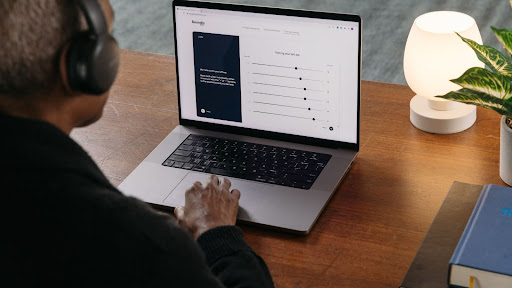
Self-assessment is the first step in the process. Hearing loss often creeps in over time, and our brains greatly compensate. Therefore, it’s hard to pin down exactly how much hearing loss you are dealing with without a test.
Hearing tests are often free or covered by insurance at a local audiologist or ENT, but for folks who aren’t ready to head to a clinic, free online hearing tests like this one offer reasonably accurate results within 5-10 minutes. You’ll need a decent pair of headphones and a quiet room to ensure accurate results. Regardless of your test method, the next step is understanding your results. Here’s a breakdown with typical examples .
Your hearing test maps the severity and shape of your hearing loss (from low to high frequencies). Take note of your hearing loss level: Mild, moderate, severe, or profound. This information will be vital as you choose a care method in the next step.
2. Choose your care method.
With your test results in hand, it’s time to choose a care method. This step is perhaps the most critical in making sense of your hearing health decisions because it directly impacts the price you will pay and the brands you can access. Let me explain.
There are generally three models of care in the hearing aid world: In clinic, telehealth, and over-the-counter.

The first and most common way to buy hearing aids in 2024 is at a local audiology office. A local office will schedule an appointment, test your hearing, and program a set of prescription devices specifically for your loss. Typically, you will physically come back for follow-ups, but in some cases, your doctor can make remote adjustments after an initial in-person fitting. Around 40%-50% of patients can expect their insurance to offer a discount or cash benefit for this model of care.
In clinic pros:
- Hands-on care
- Top-end devices customized to your loss
- Rule out ear disease and earwax
In clinic cons:
- Prices range from $3,500–$7,500/pair
- Requires travel time, access, and visits to your local clinic
- Sometimes includes longer wait times for appointments
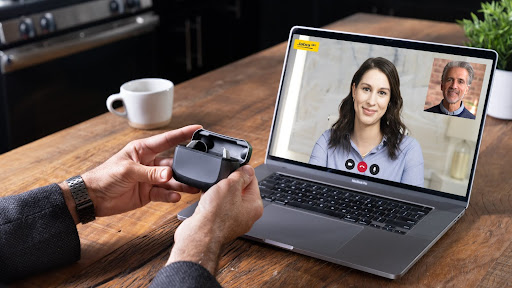
The second way to buy hearing aids is through telehealth, which is sometimes called direct-to-consumer. Customers order their hearing aids over the phone or online, take an online hearing test, or submit results from a local test, and the brand ships programmed hearing aids to their door.
Follow-ups are often conducted by a doctor, with tuning completed via video, text, and phone calls. Most insurance networks do not cover this model of care, but the end price tends to be lower than local clinic care even after benefits.
Telehealth pros:
- Prices range from $1,195–$2,995/pair
- Less driving and waiting room time
- Easier access to follow-up appointments
Telehealth cons:
- Requires some tech-savviness
- Not a good fit for those with severe or profound hearing loss
- Sometimes there are more limited brand options
Over-the-counter
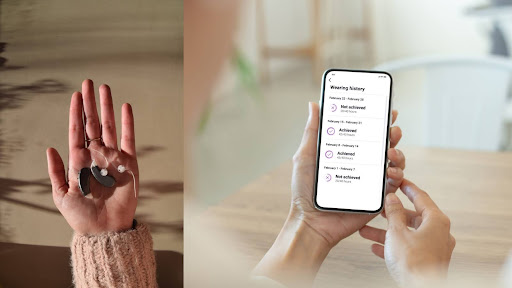
The third way to buy hearing aids is over-the-counter (OTC). OTC hearing aids come without any customization to your specific hearing loss and give you the controls via an app. Brands like Bose, Sony, and Sennheiser have entered the market with their own versions of this technology. Most brands include customer service (similar to other consumer technology) but no professional care.
- Prices range from $300–$2,500/pair
- Typically easy to purchase and set up
- No waiting for professional involvement (app controls are on-demand)
OTC cons:
- Less precise programming
- Very little hands-on support
- Some products are less advanced
3. Choose a hearing aid style.
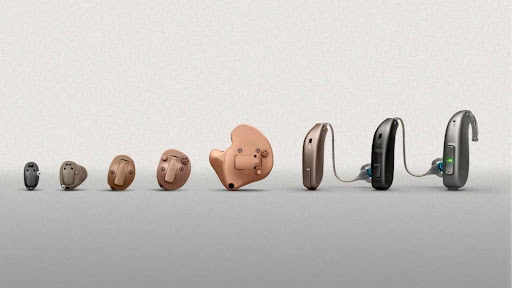
Hearing aid styles are grouped into two big categories: Behind-the-ear (by far the most common) and in-the-ear. I’ve tried both styles but ultimately wear behind-the-ear devices for their all-day comfort and higher-level technology. Note that many in-the-ear devices do not come with Bluetooth streaming or rechargeable batteries, something to consider as you browse. Take a look at the image to the right to get a sense of the scale of different hearing aid models.
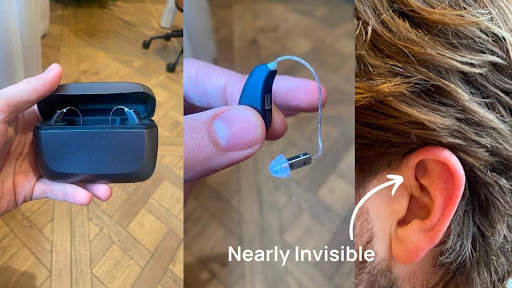
Behind-the-ear options are nearly invisible for anyone with longer hair, with a tiny wire reaching the ear. I’ve included an image here of my own behind-the-ear hearing aids so you can see just how inconspicuous they are. Most in-the-ear options come with protective, ready-to-wear sleeves, and some will even be custom-molded to your ear canal. Ultimately, it’s down to your preference and what works for your lifestyle. If you still have questions, here’s a full guide to choosing a hearing aid style .
4. Make a shortlist.
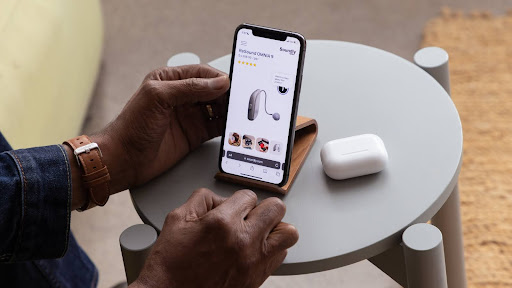
It’s finally time to make a hearing aid shortlist of products you’re most interested in. If you are anything like me, you may be tempted to start comparing brands and products immediately without taking steps #1–#3. Resist the urge! There are 100+ brands on the market, but those options get much more manageable with a hearing test, care model selection, and style choice in hand.
Everyone’s shopping process is different, but I suggest picking 2–3 products that fit your criteria and hearing loss. From there, read or watch a few reviews and make your final selection.
You can use sites like soundly.com to sort through brands, care methods, and styles. I also publish a monthly guide to the best hearing aids on the market .
“Most people need weeks or months to adjust to levels of sound that they may not have heard in years.”
Once you’ve done your research, take the plunge. Remember that nearly all hearing aids across the care spectrum come with a 45-day return policy. Use that to your advantage and put your new devices to the test.
Unlike glasses, hearing aids aren’t an instant fix and take some getting used to. Most people need weeks or months to adjust to levels of sound that they may not have heard in years.
Still, if your devices aren’t helping after a few weeks, there’s no harm in sending them back and trying something else. Be patient with yourself through this process, and if you’ve opted to work with a professional, communicate often about your experience. You can read my complete account of getting used to hearing aids here .
“Be patient with yourself through this process, and if you’ve opted to work with a professional, communicate often about your experience.”
Getting your first pair of hearing aids is a big step. There’s the research and cost but also a mindset shift. As I adjusted to amplified sounds, I noticed that I wasn’t straining to pick up words, and I re-engaged in sonically challenging situations with more confidence (masks included).
Like any skill, learning to use — and trust — my hearing aids took time, but the impacts have been well worth it. I now view my hearing aids much like my phone or laptop: They are tools that help me successfully navigate the world around me more easily and confidently. Now you’re on the path to finding hearing aids that work for you too.
Blake Cadwell is the CEO of Soundly, an online marketplace that streamlines the process of searching for and comparing hearing aids through shopping tools, access to professionals , and online hearing tests .
RELATED READING

How To Host a Dinner Party For New Friends (Who Don't Know Each Other)
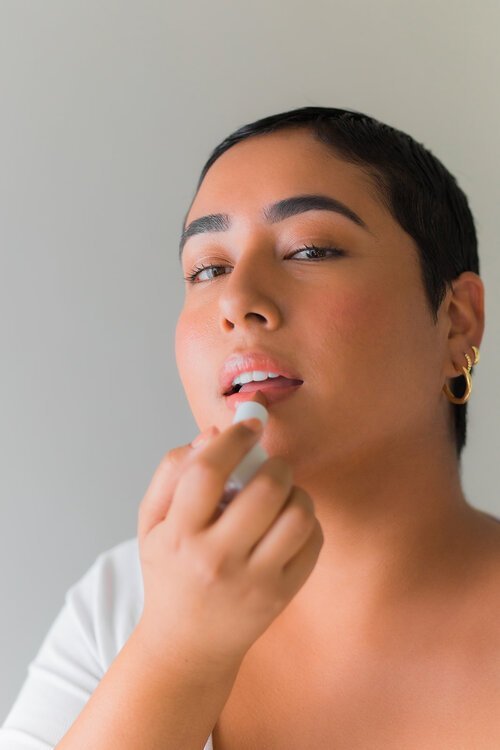
Skinimalism: How To Streamline Your Skincare Routine

Are Women Who Choose To Live Alone Happier And Less Burdened?

How To Avoid Awkwardness When Meeting Someone New

Call us and get support from one of our advisors.
Ready for your next appointment? Request it online now in a few easy steps.

Introducing Audiologist Home Visits
Home visit service from our hearing care professionals.
We know it might not always be possible to visit one of our clinics, especially now. That’s why we have extended our hearing care services to support you from the comfort of your own home.
Our dedicated team of audiologists are committed to their customers and are available to visit you at home and provide you with personalised care.
Call 13 MY EARS (13 69 3277) to find out if home visits are available in your area
Our audiologist home visit services
You’ll be able to benefit from the high standard of care and sanitisation offered by our friendly hearing care professionals who will take the time to listen to your hearing challenges. The home visit service can include:
- Advanced Hearing Tests
- Hearing Aid Fittings
Our home visit appointments will be conducted by a qualified and experienced audiologist who will thoroughly check your hearing with the same level of care and detail as they would in one of our clinics.
In the comfort of your own home
We understand how important it is to stay connected, especially now. Good hearing is essential to help you stay in touch with your family, friends and community.
We know it might not be currently possible to visit one of our Amplifon clinics and so we are able to provide a home visit service for advanced hearing tests, fittings and hearing aid aftercare appointments to your door. Our home visit appointments will be conducted by a qualified and experienced audiologist who will thoroughly check your hearing with the same level of care and detail as they would in one of our clinics.
To cover the cost of the advanced hearing test and home visit, there will be a small fee of $75 which will be redeemable off any purchases at Amplifon at the time of the visit or in the future.
If you are eligible for the Hearing Services Program or Department of Veterans’ Affairs the advanced hearing test will be at no cost to you, only a small travel fee of $25.
Hearing Services Program & Department of Veterans’ Affairs clients who have a letter from their Doctor OR live in a nursing home will receive this appointment at no cost and no travel fee.
WorkCover clients will also receive this appointment at no cost and no travel free.
What happens during a home visit?
- One of our fully qualified hearing care professionals will introduce themselves upon arrival with their Amplifon name badge so you can feel confident that they are an official Amplifon representative.
- We always recommend that you have a family member, friend or carer present who is aware of your hearing history so we can gain as much insight into your hearing as possible.
- Your audiologist will take a look into your ears using an otoscope to check for a buildup of earwax that may be affecting your hearing. If they feel that your ears are clear of wax, they will begin the hearing test by placing a set of headphones over your ears. They will check each ear individually and ask you to respond to every sound you hear.
- Once we have established your results , they will share them immediately with you so you can understand how we can help to improve your hearing. You can have a look at our range of hearing aids and find out what your options are and even purchase them during the one visit. Even if you have no hearing loss or a mild loss, we will be able to advise you on the best ways to keep your hearing health in tip-top condition.

How to recognise hearing loss?

What Happens during a Free hearing evaluation

Protect your hearing with our hearing loss prevention advice
Get support and advice.
Request an appointment
Take an online hearing test
Find a clinic near you


Best Over-The-Counter Hearing Aids
Our top picks.
Jabra Enhance
Hearing aids are an investment in your hearing health, but the hefty price tag might not be in your budget. Traditional in-office hearing aids may come at a considerable cost, with some brands charging up to $4,000 per device. To expand consumer access to hearing aids and improve affordability, the FDA has established a new category of over-the-counter (OTC) hearing aids.
Effective October 17, 2022, OTC hearing aids are now available directly to consumers, 3 generating potential cost savings for individuals with perceived mild to moderate hearing loss. OTC hearing aids do not require professional advice, fitting, adjustment, or maintenance. SeniorLiving.org’s team of experts will continue to update our OTC analysis and hands-on reviews as additional FDA-registered OTC hearing aids continue to hit the market.
Let’s dive into which OTC hearing aids surpassed the competition.
How We Chose the Best OTC Hearing Aids
Our top FDA-registered OTC hearing aid contenders for mild to moderate hearing loss were chosen with great consideration. We evaluated a variety of criteria, including cost, functionality, remote care, battery life, features, and warranty.
OTC hearing aids will be more affordable than traditional hearing aids, and some of them even come with support from audiologists. All of the devices on this list will be suitable for mild to moderate hearing loss only.
What Are OTC Hearing Aids?
Hearing aids can make a world of difference in the quality of life for people with hearing loss. Untreated hearing loss can lead to isolation, and it has been associated with serious conditions such as depression, anxiety, low self-esteem, dementia , reduced mobility, and falls. 3
Unfortunately, conventional hearing aids can be very costly, and not everyone can afford the doctor’s visit, let alone the devices. This is where the FDA’s OTC hearing aids may come into play. OTC hearing aids are for individuals aged 18 and over who suffer from mild to moderate hearing loss. These self-fitting hearing aids don’t require a hearing exam, an audiologist’s review, or approval from a medical practitioner, resulting in a more affordable price point. However, some OTC brands do offer online hearing tests and follow-up care, even though it is not required.
The FDA’s OTC hearing aid category aims to make hearing aids more accessible and affordable. However, there are a few important considerations to be aware of, as you may be responsible for:
- Determining the level of your hearing loss and your hearing needs
- Selecting and purchasing your hearing aid
- Setting up and programming your hearing aid
- Troubleshooting your hearing aid should it malfunction
In the video below, Jeff Hoyt, editor-in-chief of SeniorLiving.org, speaks with Dr. Ruth Reisman, a licensed audiologist and hearing aid dispenser, about the Over-the-Counter Hearing Aid Act and how it could help millions of Americans.
Pros and Cons of OTC Hearing Aids
Still unsure whether OTC hearing aids for mild to moderate hearing loss are right for you? Let’s take a moment to weigh the potential pros and cons.
Pros About Over-the-Counter Hearing Aids
- Affordability: The FDA’s newly established OTC hearing aid category aims to reduce hearing aid technology costs. President Joe Biden’s statement on hearing aid affordability noted that the final FDA ruling would deliver nearly $3,000 in savings to American families for a pair of hearing aids. 4 This could be a game changer for low-income seniors or those on a fixed income, as hearing aid pricing is a major consideration .
- Ready availability: OTC hearing aids are available direct-to-consumer. You don’t need to wait for a doctor’s approval or a fitting appointment.
- Simplicity: OTC hearing aids will likely come with limited features, making them a viable choice for individuals who aren’t interested in complex features.
- Smart choice for new hearing aid users: OTC hearing aids may offer a quick and easy solution to help you become more familiar with your hearing needs.
Cons About Over-the-Counter Hearing Aids
- They’re not for all levels of hearing loss : According to the FDA ruling, OTC hearing aids are for those who have mild to moderate hearing loss. If your hearing loss is more profound, you will need a prescription hearing aid that offers more functions, features, and controls.
- They’re not custom-fit : Unlike brands like ReSound and Starkey , which offer custom hearing aids based on ear size, shape, and structure, over-the-counter hearing aids are typically not professionally molded to your ears. This “one-size-fits-most” method may result in an uncomfortable or incorrect fit.
- The quality may not meet your expectations : A lower-quality OTC hearing aid may not deliver a seamless hearing experience. OTC hearing aids most likely won’t come with assistance from an audiologist, making it challenging to troubleshoot if your hearing aid malfunctions.
Things to Keep in Mind When Purchasing an OTC Hearing Aid
Since the FDA’s new hearing aid category has been approved, purchasing an OTC hearing aid may be as simple as stopping by your local drugstore. However, shopping can be a bit tricky if you don’t already know what to look for. To help you out, we’ve put together an explanation of a few important criteria to consider as you evaluate over-the-counter and prescription hearing aid options.
Battery Life
Whether you prefer a traditional battery-powered hearing aid or a rechargeable model, your hearing aid is only as good as its battery life. It’s essential to find out how long your hearing aid will last. No one wants their hearing aid to lose power in the middle of a conversation!
The outer packaging for all OTC hearing aids will note if the battery is rechargeable or replaceable. If the battery is replaceable, the packaging will include how many batteries are needed (and if they are included).
Return Policy
It’s important to give yourself adequate time to adjust to wearing your new hearing aids. This is why a generous return policy is crucial. Before making your purchase, check the OTC hearing aid return policy. This policy is set by the retailers and manufacturers, not the FDA, so time frames will vary.
Small but mighty, hearing aids are built with tiny electrical parts. So, what happens if your hearing aids stop working? A solid warranty ensures that the manufacturer can repair or replace your hearing aid at no additional cost within a specific time frame.
Size and Weight
You’ll likely spend many hours wearing your hearing aids, so choose a lightweight device for optimal comfort. It’s also critical to consider how your hearing aids will fit, feel, and look. Are you in the market for a discreet, practically invisible hearing aid, or would you rather have one that is larger but easier to operate? Consider these questions as you explore your options.
Volume Control
All OTC hearing aids must be self-adjusting with a user-adjustable volume control. This key feature allows you to tune the volume to fit your situation (e.g., louder in noisy environments, softer in quiet environments). However, advanced individual customizations for OTC hearing aids are not required by the FDA.
Smart Device
Are you tech-savvy, or do you prefer a more hands-on hearing aid approach? Some OTC hearing aids depend on wireless technology via a smartphone or a personal computer to program and adjust the hearing aid. Think about what type of OTC hearing aid will work best for you, and look for those product specifications on the packaging.
Take Our Free Online Hearing Test
Wondering if you have hearing loss?
Grab your headphones and get an evaluation in minutes.
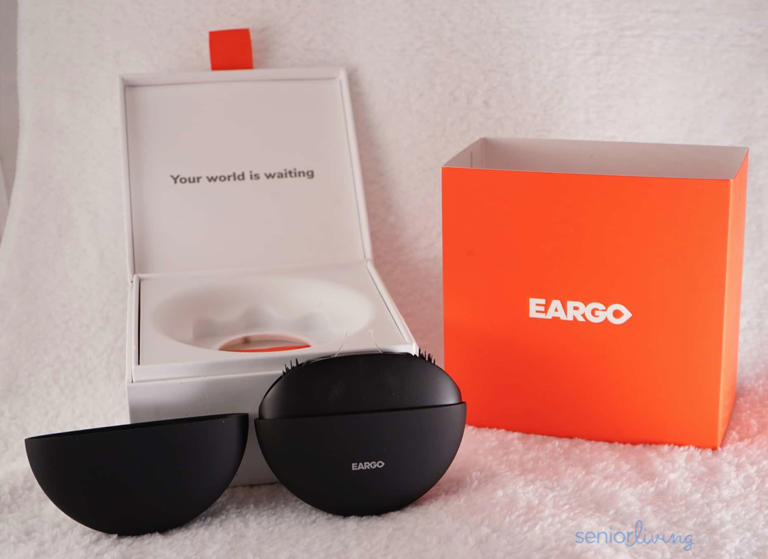
- Book an appointment
Book a free appointment with one of our experts at a store near you.
- Hearing tests
- Book a free hearing test
- Online hearing test
- Hearing loss simulator
- Ongoing support
- Ear wax removal
- Hearing aid insurance
Hearing aid aftercare
- Hearing aid repairs
- What happens in a hearing test?
Understand what happens at your free hearing test with Boots Hearingcare
- Try hearing aids risk free
Our 90-day money back guarantee means you can try your new hearing aids, risk free.
- Hearing aids
- How do hearing aids help
- How do hearing aids work
- Hearing aid prices
- Hearing aid brands
- Find the best hearing aid
- Hearing aid batteries
- Hearing aid accessories
- Hearing aid maintenance & cleaning
- NHS vs private hearing aids
- Types of hearing aids
- Invisible hearing aids
- Rechargeable hearing aids
- Bluetooth hearing aids
- Which one should I choose?
- Hearing protection
- The ear explained
- Hearing explained
- Ear cleaning advice
- Ear candling: Does it really work?
- How to improve hearing
- What to do about itchy ears
- Recognising hearing loss
- Signs and causes of hearing loss
- Age-related hearing loss
- Temporary or permanent hearing loss
- Ear conditions & treatments
- Pain Behind the Ears
- Otitis externa
- Labyrinthitis
- Meniere's disease
- Ear infection
- Eustachian tube dysfunction
- Echo in the Ear: Causes & Treatment
- Why Choose Boots Hearingcare
Find out more why Boots Hearingcare is the UK’s most trusted Hearingcare brand.
- Contact us today
Need to talk to one of our customer care team?
- Why choose Boots?
- Find an Audiologist near you
- Customer stories
- Become a Hearing Wellness Advisor
- Customer support office roles
- Graduate scheme
- Audiologists roles
- Hearing lifestyle & blog
- What Causes Fluid in the Ear?
- Hearing loss and dementia
- Is sleeping with earplugs bad for you?
- Can diabetes affect your hearing?
- How to protect your hearing
- The loudest jobs in the world
- 6 home remedies for an ear infection
- 10 tinnitus remedies to try at home
- What causes spots in the ear
- Noise levels of everyday sounds
- Relaxing vs. Stressful: the Impact Different Sounds Have on Our Mood
Get all your hearing care essentials from our shop for a seamless hearing experience.
- Hearing aid maintenance
- Battery tools
- Dryers and drying accessories
- Household auditory aids
- Alarm clocks
- Amplified home phones
- Amplified mobile phones
- TV amplifiers
- Wireless accessories
- Ear care protection
- ACS in-ear monitors
- Ear hygiene
- Reusable hearing aids
- Custom earplugs
- Face mask extenders

Hear more of what you love
Book your free hearing check with one of our expert audiologists today
Why choose Boots Hearingcare?
Free hearing test
Expert Audiologists
Money back guarantee
Test and instant fit
Lifetime of free aftercare
Interest free credit
Your step by step guide to better hearing.
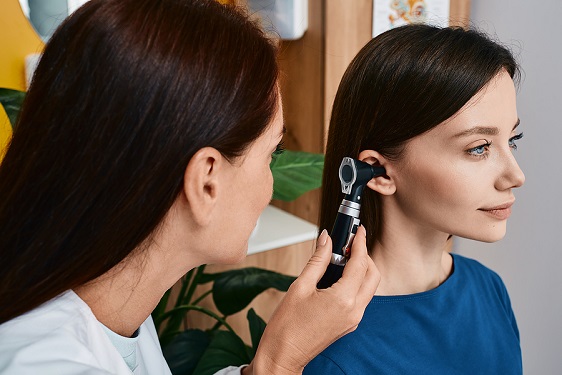
1. Book your free hearing test at a location that suits you
Book your hearing test

2. Select your hearing aid and try risk-free 90 days
View hearing aids
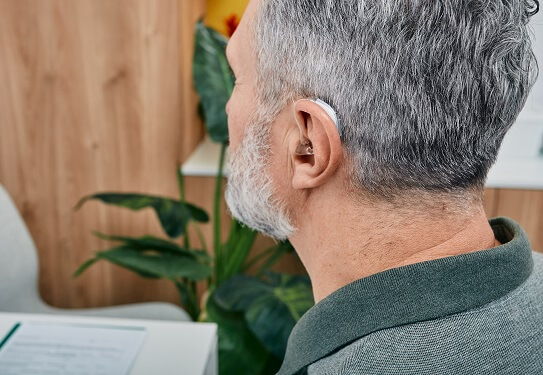
3 . Rest easy knowing your hearing aid comes with a lifetime of aftercare
"i found this service second to none, my appointment was on time, the advice i was given was very informative. my hearing test was carried out professionally and i am very satisfied with the service" - james, basingstoke, hearing information & advice.

Hearing advice centre

What happens at a hearing test?

How do hearing aids work?
Hearingcare with boots.
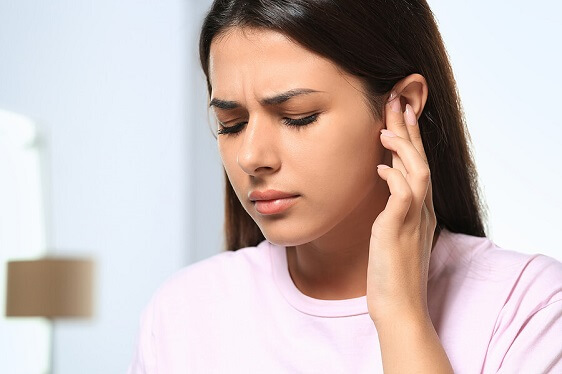
What is tinnitus & what causes it?
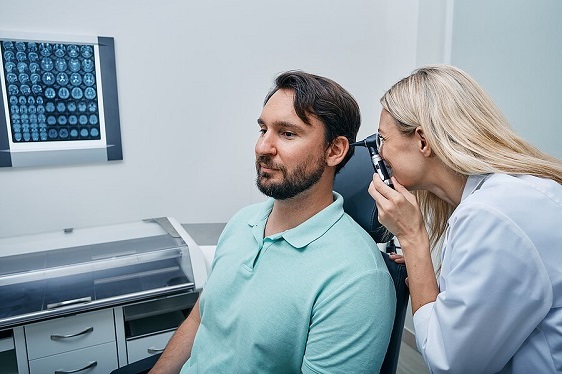
Ear infections & their symptoms
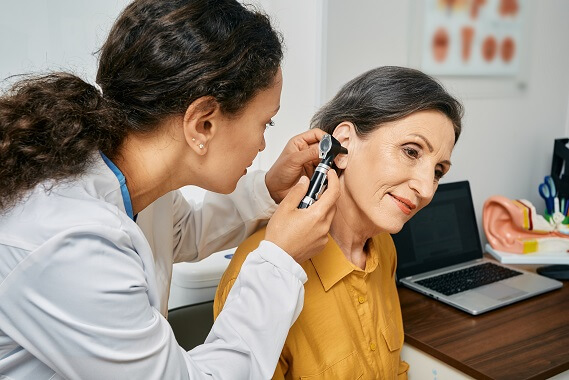
Types of hearing loss
Useful tools for hearing health.
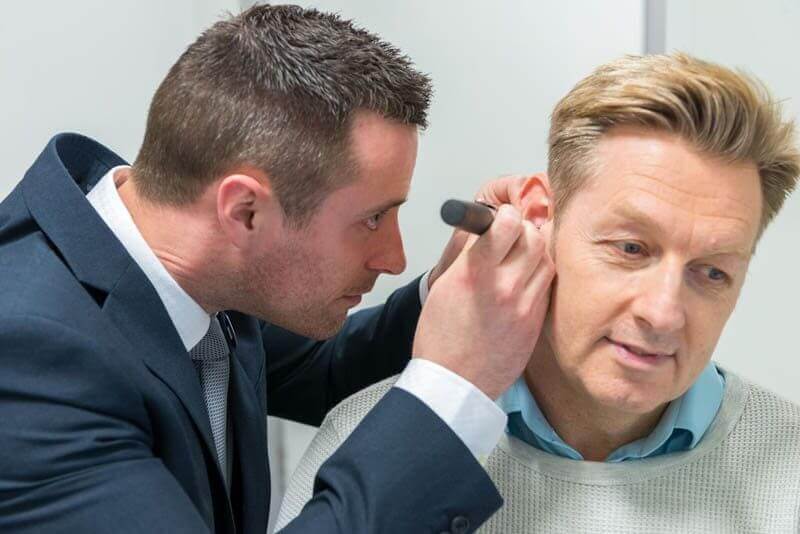
Hearing simulator
This useful tool will help you understand the impact that hearing aids could have on your hearing and quality of life. It can also be used by loved ones to experience what hearing loss can feel like.
FIND OUT MORE
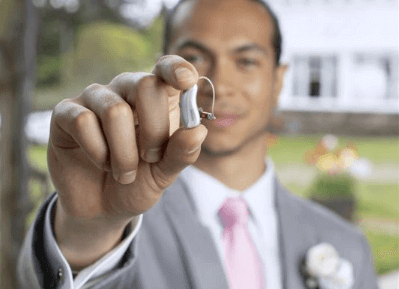
Hearing aid finder
If you suffer from hearing loss and would like to determine the hearing aid that would best meet your unique needs, our hearing aid finder can be helpful. Click below to try our new online tool.

Create or log in to your account to book or amend appointments.
Hearing aid features
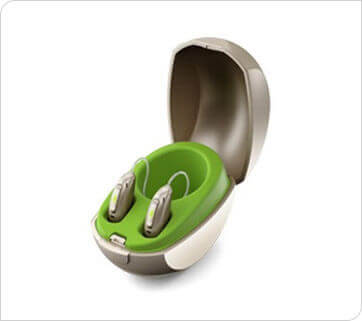
Rechargeable
The latest rechargeable models offer an environmentally friendly solution as well as powerful battery technology.
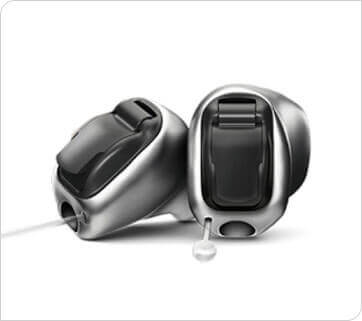
These custom-made hearing aids fit directly into your ear canal, making them very discrete.
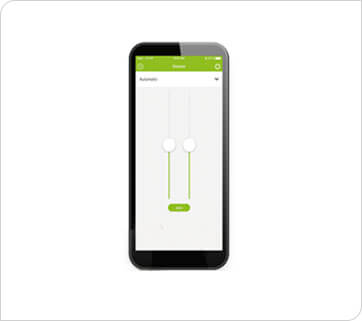
Connect your hearing aid directly to your smartphone for hands-free calling and streaming TV and music.

A long heritage of caring for your health
With years of experience caring for the nation's hearing health, you can trust us to look after your and your family's hearing. At Boots Hearingcare we'll look after you with the highest level of personal care; with us, you're never just a number; we'll tailor your experience to suit you and your hearing.
We understand that one size does not fit all
We pride ourselves on offering one of the widest ranges of hearing aids on the market and we keep up to date with the latest and greatest advances in hearing technology. So, whatever your hearing loss, budget, or style we're confident we can find the perfect solution for you.
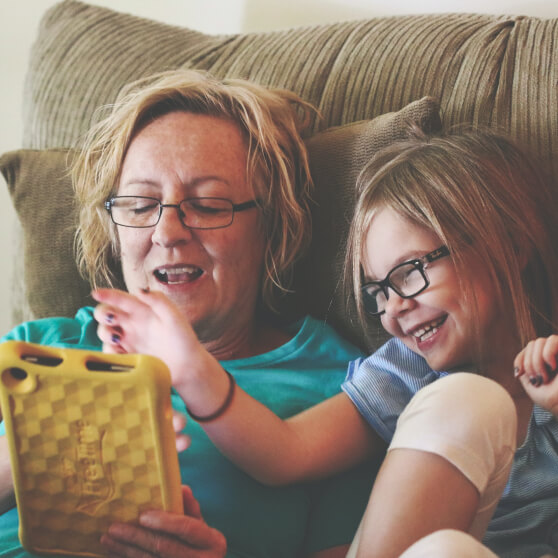
More from Boots Hearingcare
Book a free hearing check.
Book your hearing test appointment online.
Book online
Online Hearing Test
Test your hearing at home for a quick and convenient way to find out how well you're hearing.
Find your nearest store
Use our store locator to find a store near you.
Find out more
Watch CBS News
The five best hearing aids in 2024
By Tom Horton
Updated on: March 28, 2024 / 12:46 PM EDT / Essentials
CBS Essentials is created independently of the CBS News editorial staff. We may receive commissions from some links to products on this page. Promotions are subject to availability and retailer terms.
Hearing aids can be vital for your wellbeing if you suffer from hearing loss of any severity.
You should always consult with your audiologist before making a purchase , whether you're picking out your first pair of hearing aids or investing in something newer and better than your current pair. But if you want some help sorting through hearing-aid brands to find the best of the best in 2024, we have you covered.
If you're suffering from mild to profound hearing loss, you deserve a hearing aid that works for you, not against you. That means no medical devices with subpar sound amplification or poor usability. We put in the work to weed out the hearing aids that aren't worth it and shine a spotlight on the ones that are.
Learn more about the best hearing aids of 2024, plus the types available and what makes each of them different.
What are the best hearing aids in 2024?
Looking at both prescription and over-the-counter (OTC) hearing aids, we considered factors like fit and design, sound technology , and affordability to find the absolute best hearing aids for you.
- Best overall OTC hearing aids: Jabra
- Best for moderate to severe hearing loss: Phonak
- Best Fit: Eargo
- Best sound quality: Sony
- Most budget-friendly: MDHearing
Browse the best hearing aids from trusted brands like Phonak, Eargo, and Sony.
Prices listed for prescription hearing aids are calculated based on data from trusted healthcare providers and customer accounts. What you see here and what your audiologist or primary care provider quotes may be different, thanks to charges like professional fitting and programming services.
Best OTC hearing aids overall : Jabra Enhance Plus
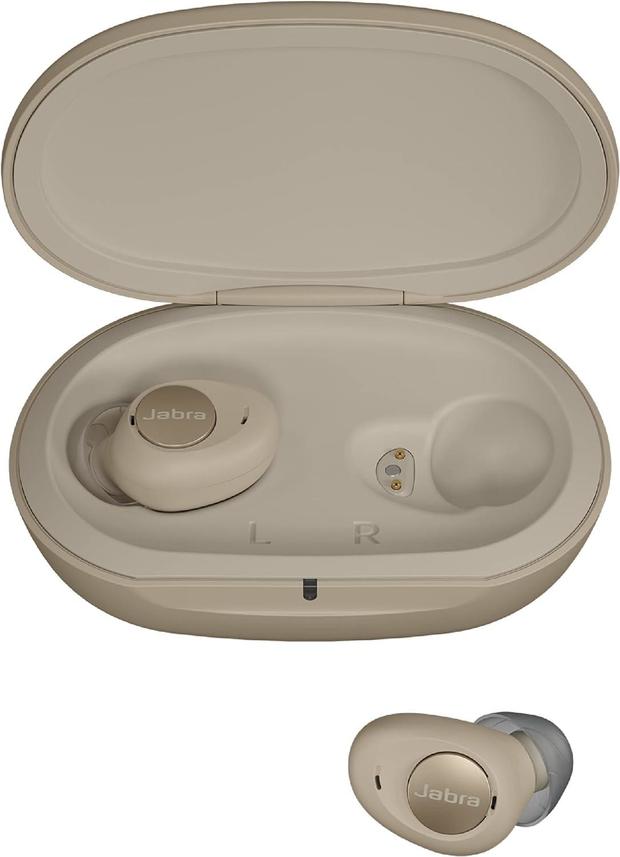
Until recently, hearing aids required a prescription from an audiologist or hearing specialist. This meant working with your healthcare providers to schedule a hearing test and, in most states, buying from a licensed seller. Since OTC hearing aids were approved by the FDA in 2022 , brands like Jabra have stepped up to the plate with direct-to-consumer devices like the Jabra Enhance Plus.
The first OTC hearing aid from Jabra, the Enhance Plus is a tiny device that could pass for a pair of wireless earbuds at first glance. This design offers a sleek, almost invisible look that won't stand out. The best features for this hearing aid include a long battery life (10-plus hours per charge), great speech amplification, and a lower price point than most prescription hearing aids.
Prices start at $799 for the Jabra Enhance Plus hearing aids.
Pros:
- Easy set-up and maintenance using the Jabra Enhance app
- Great battery life
- Nice balance of affordability and accessibility, making these our pick for best OTC hearing aids
- Jabra mobile app is currently only available for iOS
- Sound quality and background noise cancellation features could be better
Best for moderate to severe hearing loss : Phonak Audéo Lumity
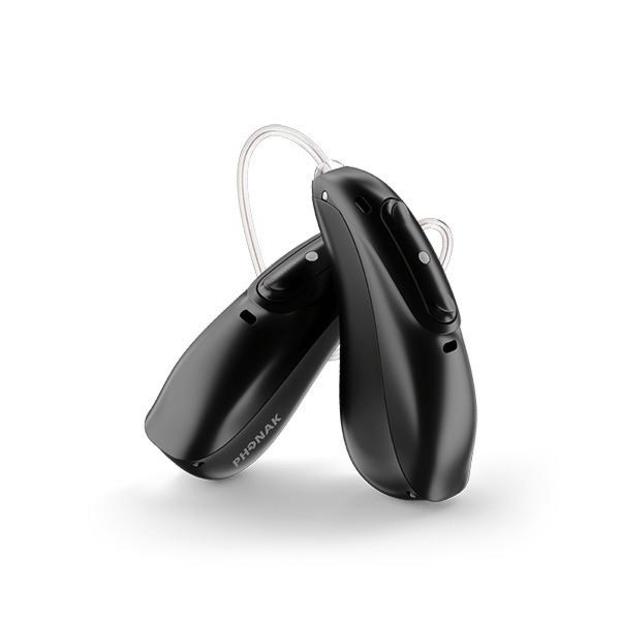
If you're interested in the latest hearing aid designs, we recommend the newest flagship hearing aid from Phonak, the Audéo Lumity. This hearing aid has several new and impressive features over the previous Phonak release (the Audéo Paradise) such as improved speech-focused tech -- StereoZoom for front-facing conversations and SpeechSensor for improved hearing from the sides and back.
This hearing aid also offers Bluetooth connectivity for both iOS and Android devices and fitness-tracking features like step counts (via the MyPhonak mobile app). As a prescription hearing aid, the Phonak Lumity is available in four technology tiers, with more functionalities (and a higher price) tied to higher ones. These include L30 (essential), L50 (standard), L70 (advanced), and L90 (premium).
Prices start at around $1,800 for the lowest tier, the Lumity L30 hearing aid.
- High-quality sound amplification from a trusted hearing aid brand
- Multiple tech tiers can make it easy to find the right device for your needs (and your budget)
- Mobile app compatibility with iOS and Android devices
Cons:
- MyPhonak app has conflicting reviews about user friendliness
- Choosing the right tech tier can be overwhelming -- consult with your audiologist to find the right fit for you
Best fit : Eargo 7

The latest OTC hearing aid from Eargo, the Eargo 7 fits snugly in the ear canal. This model builds upon previous Eargo devices with a sleek, nondescript design and tech improvements regarding audio processing, filtering, and noise reduction features.
The sound design of the Eargo 7 is high quality and beats out previous designs by the hearing aid brand. But the standout feature here is the device's comfortable fit: These hearing aids stay in place thanks to small, interlocking "petals" that keep everything in place.
With prices starting at $2,650, these are some of the most expensive hearing aids on our list, but the fit is more than worth it.
- Snug and discreet design makes for an easy in-ear fit
- Exceptional battery life (15+ hours per charge)
- Great sound quality for OTC hearing aids
- Expensive for OTC hearing aids
- Unique design can make routine cleaning a hassle
Best sound quality : Sony CRE-E10

Another OTC hearing-aid favorite, the Sony CRE-E10 device excels at crisp sound quality, whether you're listening to music, nearby conversations or nothing more than the ambient sounds of everyday life. This hearing aid offers speech enhancement and feedback reduction at a quality to rival many prescription hearing aids.
If you want a premium hearing aid that you can fit yourself, with perks like Bluetooth connectivity and an exceptional battery life, this is the hearing aid for you. One caveat: You will have to deal with a price tag closer to prescription hearing aids versus your average OTC device, as the CRE-E10 is normally available for $1,299.
The good news is that this hearing aid is currently on sale for around $1,100 -- this applies whether you shop from Sony or Amazon below.
- Exceptional sound quality for OTC hearing aids
- With a battery life clocking in at more than 25 hours per charge according to Sony, these hearing aids are the longest-lasting devices on this list
Cons:
- Higher price than most OTC hearing aids
- Although there are automatic adjustments that kick in based on your environment, there are no touch controls or physical buttons -- all adjustments can be made via a mobile app, which can take some getting used to
Most budget-friendly : MDHearing AIR
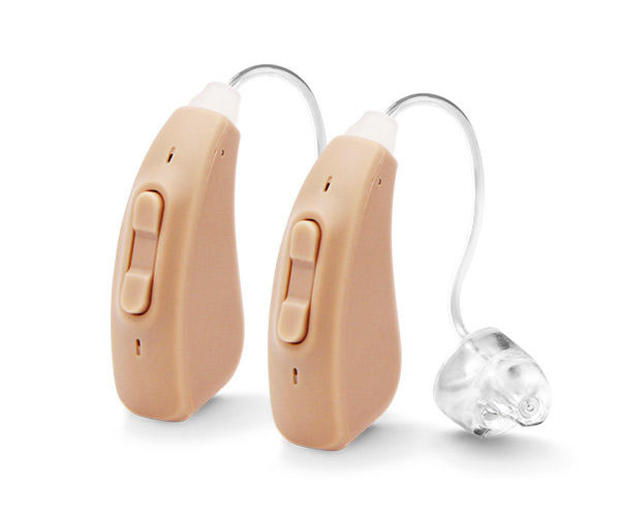
The most affordable device on our list is the latest behind-the-ear hearing aid design by MDHearing . The MDHearing AIR offers solid noise reduction and quality comfort. The inviting price point and limited tech make this OTC hearing aid great for anyone looking to try out their first pair of hearing aids.
Get a feel for this comfortable behind-the-ear hearing aid for just $297 a pair today, available from MDHearing.
- Super affordable and easy to use
- Excellent customer support according to customer reviews
- Free shipping, free lifetime support, a one-year warranty, and a 45-day risk-free trial make this one of the best and safest purchases you can make when shopping for new hearing aids
- Limited tech capabilities compared with other, more expensive devices
Different hearing aid styles to choose from
There are smaller devices that fit entirely in the ear canal for a less noticeable look, while bulkier hearing aids have parts that sit comfortably behind and around the ear. The most common styles you'll come across include:
- Behind-the-ear (BTE): BTE hearing aids loop over the top of the ear, with most of the electronics in a plastic case behind it. With the largest design, these provide optimal sound amplification over other models.
- Receiver-in-the-canal (RIC): RIC hearing aids (as well as the smaller receiver-in-the-ear, or RITE, devices) are similar to a BTE in design, but with a connecting wire in place of the BTE's earmold. This gives the ear canal more room and results in a more comfortable fit.
- In-the-ear (ITE): ITE hearing aids are custom-made to sit entirely in the outer ear. These devices have a longer battery life and usually come with more features, such as volume control, than smaller models.
- Completely-in-the-canal (CIC): CIC hearing aids have the smallest design, with a custom-built shell that fits in the ear canal. These are the least noticeable, but don't offer many features or the most powerful sound amplification.
- Open fit: A variation of a BTE, an open-fit hearing aid has an over-the-ear design with an open dome in the canal instead of a tube or mold. This keeps the ear canal open for natural sound to enter the ear as well – ideal for mild to moderate hearing loss.
How we chose the best hearing aids of 2024
For a closer look at how we rate products, here is what we prioritized while putting together our list of the best hearing aids you can buy today:
- Sound technology: We looked for important features like background noise cancellation and speech amplification.
- Affordability: We looked at both prescription hearing aids and the more budget-friendly OTC devices to make sure we highlight high quality hearing aids of all price points.
- Customer reviews: All of our hearing devices hold a four-star review or higher from happy customers just like you.
- Comfortability: We paid attention to the design, shape, and fit of each hearing aid to ensure only the most comfortable hearing aids made the list.
Tom Horton is a resident health expert for CBS Essentials, with deep experience in topics ranging from chronic conditions to health-care devices to diet options. He lives in upstate New York, and draws his power from local bookstores, long hikes on a sunny day, and his cat Sammy.
More Essentials

How to watch today's NC State vs. Duke Elite 8 men's March Madness game: Livestream options, game time, more
Find out how and when to watch Jared McCain and the Duke Blue Devils take on the NC State Wolfpack in today's men's March Madness Elite 8.

How to watch today's Toyota Owners 400 NASCAR race: Livestream options, starting time, more
Gear up for the Toyota Owners 400 NASCAR race with all the information you need to watch or stream today's race.

How to watch today's Tennessee vs. Purdue Elite 8 men's March Madness game: Livestream options, game time, more
Tennessee faces Purdue in the Elite 8. Find out when and how to watch today's NCAA March Madness game.

How to get access to a live tax professional today through TurboTax
Intuit's TurboTax makes filing taxes easy, but the company's Live Full Service option makes it even easier.

Watch Paige Bueckers play: How to watch today's Duke vs. UConn women's NCAA March Madness Sweet 16 game
Paige Bueckers is determined to lead UConn to the Final Four. She'll have to get past the Duke Blue Devils first.

Watch JuJu Watkins play: How to watch today's Baylor vs. USC women's NCAA March Madness Sweet 16 game
Find out how and when to watch JuJu Watkins and the USC Trojans face the Baylor Bears in the March Madness Sweet 16 today.

How to watch today's Clemson vs. Alabama men's NCAA March Madness Elite 8 game: Livestream options, more
Find out how and when to watch the Clemson Tigers vs. Alabama Crimson Tide men's NCAA March Madness Elite 8 game.

See Caitlin Clark play: How to watch today's Iowa vs. Colorado women's NCAA March Madness Sweet 16 game
Caitlin Clark is headed to the Sweet 16. Find out when and how to watch the Iowa Hawkeyes' March Madness game today.

How to watch today's Illinois vs. UConn men's NCAA March Madness Elite 8 game: Livestream options, more
Track UConn and Illinois' Elite 8 NCAA March Madness game with everything you need to know to watch today's game.

Final Four teams are now locked in. Here's who will compete.
Here are the 2024 Final Four teams still left in March Madness.

Full transcript of "Face the Nation," March 31, 2024
On this "Face the Nation" broadcast, Transportation Secretary Pete Buttigieg and Baltimore Mayor Brandon Scott join Ed O'Keefe.

7 minors injured in mass shooting outside Indianapolis mall, police say
Seven minors between the ages of 12 and 17 were hospitalized with gunshot wounds Saturday night. A suspect has not been found.

Turner says there is a "chaos caucus" who want to block any Congressional action
Rep. Mike Turner tells "Face the Nation" that there is a "chaos caucus that wants to stop everything that a person in Congress does" as Speaker Mike Johnson faces a possible motion to vacate.

Pete Buttigieg says "we don't fully know" conditions for Baltimore bridge repair
Transportation Secretary Pete Buttigieg said that as officials eye rebuilding efforts, it's not fully known the condition of what remains of the Francis Scott Key Bridge in Baltimore.

What retailers, restaurants and other businesses are open on Easter?
Here's what stores, restaurants and fast-food places are open — and closed — on Easter Sunday 2024.
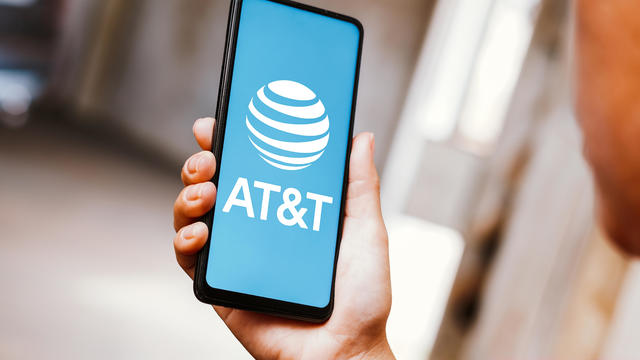
AT&T informs users of data breach and resets millions of passcodes
It is not known if the data "originated from AT&T or one of its vendors," the company said in a statement.

She bought a $100 tail and used it for a "magical" mermaid career
Professional mermaids can teach classes, participate in competitions, perform at parties or events or swim in aquariums.

American Airlines changes its policy for bringing pets on flights
Under the carrier's old policy, pets were counted as carry-ons despite a steep charge passengers pay to bring animals into the cabin.

What consumers should know about health supplement linked to 5 deaths
Products containing red yeast rice and meant to lower cholesterol are also sold in the U.S., but what they contain can be murky.
Transcript: House Intelligence Committee chairman Rep. Mike Turner on "Face the Nation," March 31, 2024
The following is a transcript of an interview with House Intelligence Committee chair Rep. Mike Turner that aired on March 31, 2024.

Transcript: Baltimore Mayor Brandon Scott on "Face the Nation," March 31, 2024
The following is a transcript of an interview with Baltimore Mayor Brandon Scott that aired on March 31, 2024.
HealthWatch

For-Profit Companies Open Psychiatric Hospitals in Areas Clamoring for Care
State institutions and community hospitals have closed inpatient mental health units, often citing staffing and financial challenges. Now, for-profit companies are opening psychiatric hospitals to fill the void.

What is meningococcal disease? Symptoms to know as CDC warns of spike
The CDC is warning about a rise in meningococcal disease, a rare bacterial illnesses than can lead to meningitis and possible death. Here's what to know about symptoms, transmission and treatment.

Was her baby's air-ambulance ride not medically necessary?
Cigna determined 3-month-old's air-ambulance ride arranged by hospital was not medically necessary, leaving his parents with nearly six-figure bill.

Reproductive rights experts weigh in on abortion, IVF battles across U.S.
From abortion restrictions to IVF bans, reproductive rights for women in the U.S. have never been more uncertain.

King Charles attends Easter service in 1st major outing since cancer diagnosis
King Charles III attended an Easter service at Windsor Castle with the queen and other royal family members, marking his most important public outing in months.

Pope Francis says "peace is never made with weapons" at Easter Sunday mass
Due to health concerns, Pope Francis had skipped the Palm Sunday homily last week and decided at the last minute to stay home from the Good Friday procession at the Colosseum.

Heavy rains in northwestern Pakistan kill 8 people, mostly children
Monsoon and winter rains cause damage in Pakistan every year.

Convoy carrying Gaza aid departs Cyprus amid hunger concerns
An international charity says a three-ship convoy carrying supplies from the World Central Kitchen left Cyprus Saturday.

Christians in Jerusalem cautiously celebrate Easter amid war
Many Christians who might normally participate in pilgrimages to Jerusalem stayed away, but those who came said they weren't afraid.
Entertainment

Pete Townshend on the return of "Tommy" to Broadway
The Who's rock opera won five Tony Awards when it was translated to Broadway three decades ago, and now it's back. Townshend and his collaborators discuss turning the story of a pinball wizard into Broadway magic.

The Who's "Tommy" returns to Broadway
The rock opera "Tommy" was one of The Who's biggest hits, and won five Tony Awards when it was translated to Broadway three decades ago. Now it's back, in a version that Pete Townshend and director Des McAnuff say is more relevant than ever. Correspondent Tracy Smith talks with Townshend, who describes the personal price he's paid for every iteration of "Tommy"; and with the star and creative team who discuss turning the story of a pinball wizard into Broadway magic.

Michael Douglas on "Franklin," and his own inspiring third act
The son of actors, including the legendary Kirk Douglas, has earned his own legendary status as an Oscar-winning producer and performer. He now stars as the revolutionary figure Benjamin Franklin in the Apple TV+ series "Franklin."

Michael Douglas on "Franklin," and playing a founding father
He was the son of actors, but Michael Douglas says he was reluctant to follow in the deep footsteps of his father, Kirk Douglas. But as an Oscar-winning producer and performer, Michael has earned his own legendary status. He now stars as the revolutionary figure Benjamin Franklin in the Apple TV+ series "Franklin." He tells correspondent Mo Rocca that the show's story, about the founding father's efforts to save a burgeoning democracy, is timely given today's dangerous political climate.

Hillary Clinton, Malala Yousafzai on producing Broadway musical "Suffs"
A new Broadway musical tells the story of suffragists and their fight for the right to vote. Two of the show's producers, Nobel laureate Malala Yousafzai and former Secretary of State Hillary Clinton, discuss the importance of art to spread a political message.

How AI powered robots are helping small farms
From labor shortages to environmental impacts, farmers are looking to AI to help revolutionize the agriculture industry. One California startup, Farm-ng, is tapping into the power of AI and robotics to perform a wide range of tasks, including seeding, weeding and harvesting.
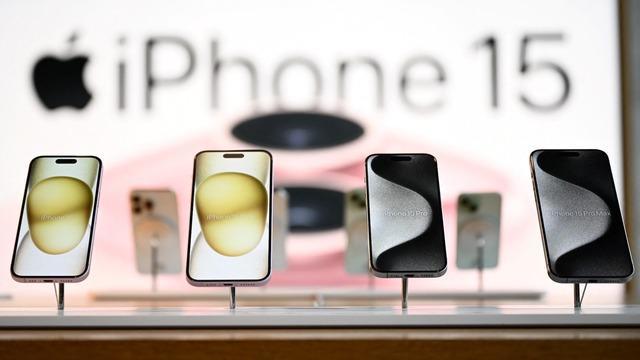
Phone companies shifting to eSIMs
Phone manufacturers, including Apple, are moving away from physical SIM cards toward eSIMs for newer phone models. The change could cause headaches for customers. Lisa Eadicicco, a senior editor for CNET, joined CBS News to discuss the shift.

Sam Bankman-Fried sentenced to 25 years
Sam Bankman-Fried was sentenced to 25 years in prison for his role in the sudden collapse of the FTX crypto exchange. Prosecutors say he defrauded customers out of more than $8 billion, one of the largest financial crimes in U.S. history. Errol Barnett reports.

Scientists working on AI tech to match dogs to jobs and owners
Researchers in London are developing an AI tool to sort dogs into 5 categories, in a bid to match pooches with their perfect owners.

AI tool could match dogs with perfect owners
CBS News' Ian Lee meets researchers in London who are developing an AI tool to sort dogs into 5 categories, in a bid to match pooches with their perfect owners.

Building healthier habitats to resist the impacts of climate change
Scientists have prescribed practical steps to heal our warming planet, including returning our towns back to a more natural state. CBS News correspondent Jonathan Vigliotti explains how taking steps to mitigate the effects of climate change can save us from the trauma of disasters brought about by extreme weather.

Report: 1 billion meals wasted daily in 2022
According to the United Nations Environment Programme, humans wasted 19% of all available food in 2022. That's equivalent to one billion meals per day. Brian Roe, agricultural and environmental economics professor at Ohio State University, joins CBS News to discuss the implications.

Australia races to save last few earless dragons in the wild
The critically endangered dragons will likely be extinct in the next 20 years without conservation efforts, experts say.

90% of some of the world's wine regions could disappear, study finds
Climate change means wine could soon have a higher alcohol content — but spoil faster and smell worse.

Woman's conviction for husband's murder overturned after 2 decades
Blaming an inadequate and incomplete investigation and unfair trial, Jane Dorotik pushed for a new examination of the evidence that helped convict her.

Did a dentist accused of murder poison his wife's protein shakes?
Angela Craig's autopsy revealed she had been poisoned. Police claim the evidence points to her husband James — alleging he purchased potassium cyanide and arsenic and laced her protein shakes with poison.

11-year-old boy shot in head in St. Paul, Minnesota; 2 in custody including 13-year-old girl
Police are investigating after they say an 11-year-old boy was shot in the head on Friday night.

California man convicted of killing his mother is captured in Mexico
Authorities say Ike Nicholas Souzer was captured a week after he walked away from a halfway house.

New image reveals "twisted" magnetic fields around our black hole
Supermassive black holes are believed to have emerged very early in the universe but their creation remains a mystery.

Soyuz crew docks at space station after 2-day rendezvous
NASA astronaut Tracy Dyson is replacing Loral O'Hara, who's wrapping up a six-month stay aboard the space station.

Earth was just slammed with a "severe" geomagnetic storm
NOAA said people as far south as Alabama may have seen the northern lights and that the sun could expel the strongest type of solar flares over the next few days.

How to see the penumbral lunar eclipse, March's full moon
As March's full Worm Moon rises late Sunday into early Monday, it will travel through the Earth's penumbra — the faint outer part of its shadow — creating a penumbral eclipse.

Russia launches one-man, two-woman crew to space station
NASA astronaut Tracy Dyson, making her third flight, will spend six months aboard the station, replacing astronaut Loral O'Hara.
Latest Galleries

Notable Deaths in 2024
A look back at the esteemed personalities who've left us this year, who'd touched us with their innovation, creativity and humanity.

PHOTOS: Baltimore bridge collapses after cargo ship rams into overpass
The Francis Scott Key Bridge in Baltimore collapsed early Tuesday, March 26 after a column was struck by a container ship that reportedly lost power, sending vehicles and people into the Patapsco River.

Could an Alabama woman have shot herself twice?
When Tiffiney Crawford was found dead inside her van, authorities believed she might have taken her own life. But could she shoot herself twice in the head with her non-dominant hand?

CBS newsman Charles Osgood (1933-2024)
We look back at the life and career of the longtime host of "Sunday Morning," and "one of the most enduring and most endearing" people in broadcasting.

Texas couple investigates teen daughter's unusual death
Cayley Mandadi's mother and stepfather go to extreme lengths to prove her death was no accident.
Latest CBS News Videos

Church near World Trade Center restored
The new St. Nicholas Greek Orthodox Church sits at the edge of the World Trade Center, resurrected and alive – after it was nearly destroyed under its rubble on September 11, 2001.

Inside the dangerous Indian Relay horse race
Indian Relay, dubbed “America's original extreme sport,” has roots dating back centuries to horse stealing raids. Native Americans are keeping the dangerous and compelling racing tradition alive.

New Havana Syndrome evidence revealed
Efforts continue to investigate brain injuries suffered by U.S. officials. This is the fourth 60 Minutes Havana Syndrome report and, for the first time, there’s evidence of who might be responsible.

3/31/2024: Targeting Americans; Indian Relay
First, new Havana Syndrome evidence is revealed. Then, a look inside the dangerous Indian Relay horse race.

Women mariachi band takes on male-dominated genre
Dinorah Klingler grew up with mariachi music but never saw herself in the male-dominated genre. When the pandemic hit, however, she started an all-female mariachi band, and they're still going strong. Danya Bacchus has the story.
For more audio journalism and storytelling, download New York Times Audio , a new iOS app available for news subscribers.

- March 29, 2024 • 48:42 Hamas Took Her, and Still Has Her Husband
- March 28, 2024 • 33:40 The Newest Tech Start-Up Billionaire? Donald Trump.
- March 27, 2024 • 28:06 Democrats’ Plan to Save the Republican House Speaker
- March 26, 2024 • 29:13 The United States vs. the iPhone
- March 25, 2024 • 25:59 A Terrorist Attack in Russia
- March 24, 2024 • 21:39 The Sunday Read: ‘My Goldendoodle Spent a Week at Some Luxury Dog ‘Hotels.’ I Tagged Along.’
- March 22, 2024 • 35:30 Chuck Schumer on His Campaign to Oust Israel’s Leader
- March 21, 2024 • 27:18 The Caitlin Clark Phenomenon
- March 20, 2024 • 25:58 The Bombshell Case That Will Transform the Housing Market
- March 19, 2024 • 27:29 Trump’s Plan to Take Away Biden’s Biggest Advantage
- March 18, 2024 • 23:18 Your Car May Be Spying on You
- March 17, 2024 The Sunday Read: ‘Sure, It Won an Oscar. But Is It Criterion?’
Hamas Took Her, and Still Has Her Husband
The story of one family at the center of the war in gaza..
- Share full article
Hosted by Sabrina Tavernise
Produced by Lynsea Garrison and Mooj Zadie
With Rikki Novetsky and Shannon Lin
Edited by Michael Benoist
Original music by Marion Lozano , Dan Powell , Diane Wong and Elisheba Ittoop
Engineered by Alyssa Moxley
Listen and follow The Daily Apple Podcasts | Spotify | Amazon Music
Warning: this episode contains descriptions of violence.
It’s been nearly six months since the Hamas-led attacks on Israel, when militants took more than 200 hostages into Gaza.
In a village called Nir Oz, near the border, one quarter of residents were either killed or taken hostage. Yocheved Lifshitz and her husband, Oded Lifshitz, were among those taken.
Today, Yocheved and her daughter Sharone tell their story.
On today’s episode
Yocheved Lifshitz, a former hostage.
Sharone Lifschitz, daughter of Yocheved and Oded Lifshitz.

Background reading
Yocheved Lifshitz was beaten and held in tunnels built by Hamas for 17 days.
There are a lot of ways to listen to The Daily. Here’s how.
We aim to make transcripts available the next workday after an episode’s publication. You can find them at the top of the page.
Fact-checking by Susan Lee .
Additional music by Oded Lifshitz.
Translations by Gabby Sobelman .
Special thanks to Menachem Rosenberg, Gershom Gorenberg , Gabby Sobelman , Yotam Shabtie, and Patrick Kingsley .
The Daily is made by Rachel Quester, Lynsea Garrison, Clare Toeniskoetter, Paige Cowett, Michael Simon Johnson, Brad Fisher, Chris Wood, Jessica Cheung, Stella Tan, Alexandra Leigh Young, Lisa Chow, Eric Krupke, Marc Georges, Luke Vander Ploeg, M.J. Davis Lin, Dan Powell, Sydney Harper, Mike Benoist, Liz O. Baylen, Asthaa Chaturvedi, Rachelle Bonja, Diana Nguyen, Marion Lozano, Corey Schreppel, Rob Szypko, Elisheba Ittoop, Mooj Zadie, Patricia Willens, Rowan Niemisto, Jody Becker, Rikki Novetsky, John Ketchum, Nina Feldman, Will Reid, Carlos Prieto, Ben Calhoun, Susan Lee, Lexie Diao, Mary Wilson, Alex Stern, Dan Farrell, Sophia Lanman, Shannon Lin, Diane Wong, Devon Taylor, Alyssa Moxley, Summer Thomad, Olivia Natt, Daniel Ramirez and Brendan Klinkenberg.
Our theme music is by Jim Brunberg and Ben Landsverk of Wonderly. Special thanks to Sam Dolnick, Paula Szuchman, Lisa Tobin, Larissa Anderson, Julia Simon, Sofia Milan, Mahima Chablani, Elizabeth Davis-Moorer, Jeffrey Miranda, Renan Borelli, Maddy Masiello, Isabella Anderson and Nina Lassam.
Advertisement

IMAGES
COMMENTS
The Audicus Online Hearing Test requires earbuds to ensure each ear is tested individually and takes 15 minutes on average. Listeners press the spacebar every time they hear a tone played, which results in an extensive outline of hearing loss. The convenience of Audicus' online test is that the results can immediately be used to program a low ...
Schedule your appointment with us today. To set up your in-home visit, simply fill out our online form, or call us at (914) 420-0064. Schedule Appointment. Schedule an appointment in your home or office, for a visit by a caring and professional audiologist. Hearing exams, hearing instruments, personalized care.
Hearing healthcare isn't always easy to access. For instance, Medicare pays for a hearing exam only if you have a referral from a doctor. But a growing number of tests—in apps and online—are ...
The Top 4 Benefits of In-Home Hearing Aid Services. Feb 01, 2023. Differences Between OTC and Professional Hearing Aids. Apr 01, 2020. Important information for first time hearing aid wearers. ... The Benefits of Home Visits. Oct 22, 2019. Product Spotlight: Oticon OPN S The Complete Guide. Oct 08, 2019. How To Tell A Loved One They Need A ...
Enter an address, ZIP code, city or state name above to search for a hearing care provider. Allow Phonak to use your location. Are you looking for help with hearing loss or to check your hearing? Do you need audiological care? Or, are you interested in where to get a hearing aid? We can help you find a hearing care specialist in your area.
Get top-rated hearing aids at a hearing aid store or try a hearing test online. ... Visit a hearing professional at Beltone Hearing Care Center for a free consultation. ... Book an Appointment. Start a Chat. Better Hearing Starts Right Here . Take our at-home hearing test experience and we'll send your results straight to your local Beltone ...
Call Acuity Hearing Solutions at 203-640-2198 for details. Please be safe, stay healthy! COVID 19 PROTOCOLS. Patients and/or their caregivers will be asked relevant screening questions by phone, text or email prior to a home/facility visit. Number of individuals in work area will be limited to patient and one caregiver.
Hearing test, ear wax removal, and hearing aid home visits for individuals and care homes. If you are unable to come to us, we will send one of our hearing specialists to you and ensure you get an equivalent experience to our in-clinic hearing care service.
This is a great environment to demonstrate the advanced features of hearing aids, such as noise reduction. A home visit hearing test saves the customer from travel and waiting rooms. If the audiologist is running behind schedule, though inconvenient, you do not need to worry about social distancing in waiting rooms or that your parking meter ...
An open-fit hearing aid is a variation of the behind-the-ear hearing aid with a thin tube or the receiver-in-the-canal or receiver-in-the-ear hearing aid with an open dome in the ear. This style keeps the ear canal very open, allowing for low-frequency sounds to enter the ear naturally and for high-frequency sounds to be amplified through the ...
A quick look at the best hearing aids. Jabra Enhance: Most Popular; Audien: Most Affordable; Phonak: Best for Severe Hearing Loss; MDHearing: Most Feature Options; Eargo: Best Invisible Fit; Lexie: Most User-Friendly; hear.com: Best In-Home Care; Whether you're having dinner with friends or watching television at home, hearing loss can get in the way of your quality time, disrupt your ...
Best of all, the Eargo 7 are waterproof and can stand up to humidity, thanks to their IPX7 rating, meaning they've been tested to be submerged in up to 1 meter of water for 30 minutes. While these ...
Best if you're new to hearing aids: Jabra Enhance Select 100 / Jabra Enhance Select 300. Best for those who dislike behind-the-ear hearing aids: Eargo 6. Best PSAP for occasional hearing ...
Consumer Reports' latest ratings of hearing aid retailers, based on our exclusive survey of 13,163 members, can help you figure out where you'll get the best shopping experience. Included in ...
Hearing Aid UK, our at-home hearing healthcare services have always offered free home visiting services and home visits for hearing aids - Including hearing tests, fittings, maintenance, check-ups, and much more in the comfort of your own home and at your convenience. Unlike some hearing aid providers, our hearing tests can be done at home and ...
The 3-in-1 service includes: Ear wax removal at home + Hearing test at home + Hearing aid test at home (all in one visit) When completing our form, please let us know if you would like our 3-in-1 assessment so we can come prepared. Request a home visit. To speak to an audiologist before the visit, please call 0203 011 1280.
A hearing aid fitting appointment is the same whether you are in the clinic or at home. Using your hearing test results, your audiologist will know exactly how much gain your hearing aids need to give you that right amplification. For instance, amplifying soft sounds to make them audible and compressing loud sounds so they are more comfortable.
In some areas, we offer an NHS-funded home hearing service. This includes an NHS-funded hearing test, new hearing aids, and aftercare for up to three years. These visits are subject to meeting the local eligibility criteria. If you live in an area where NHS-funded home visits are available, you'll need to contact your GP for a referral.
Home visits for our patients for hearing aid adjustments. Keeping your hearing aid performing at optimum levels is an ongoing process. That's why we offer home visits to our patients. Whether you're located in Kentucky, Ohio, Tennessee, West Virginia, or Virginia, the hearing care professionals at Beltone Tristate can: ...
Explore the best hearing aids of 2024, tailored for various needs and lifestyles and designed to enhance auditory experiences for all.
Hearing aids. Explore award-winning technology and other innovative solutions. Explore hearing aids. CES Innovation Award Honoree, Genesis AI. 2024 Winner. TWICE VIP Winner for Aging-in-Place Technology, Genesis AI. 2023 Winner. 2023 Red Dot Design Award Winner, Genesis AI. 2023 Winner.
First, a few facts about hearing loss. According to the National Institute of Health, around 15% of adults have hearing loss. Research from the Lancet indicates that the likelihood of hearing loss doubles every decade, and about half of 65-year-olds have hearing loss.; Treatment of hearing loss has implications beyond simply communication.
Contact us to find out more on home visits Call 13 MY EARS (13 69 3277) Discover the benefits of a home visit service from our hearing care professionals and the possibility to run hearing tests and hearing aid trials directly at home.
Boots Hearingcare : Only provides in-store appointments and does not offer home visits or hearing tests at home. Specsavers Hearing: We don't know whether they can provide maintenance or adjustments when needed, but we do know that a home visit will cost you around £100. Bloom Hearing : Do a home visiting service at no extra charge, but ensure ...
Unfortunately, conventional hearing aids can be very costly, and not everyone can afford the doctor's visit, let alone the devices. This is where the FDA's OTC hearing aids may come into play ...
Visit our shop now. ... Online Hearing Test. Test your hearing at home for a quick and convenient way to find out how well you're hearing. ... **Interest Free Credit available for current Phonak hearing aids only. 0% over up to 24 months requires minimum 10% deposit. Boots Hearingcare Ltd (FRN 697636) trading as Boots Hearingcare is a credit ...
The best features for this hearing aid include a long battery life (10-plus hours per charge), great speech amplification, and a lower price point than most prescription hearing aids.
Fact-checking by Susan Lee.. Additional music by Oded Lifshitz. Translations by Gabby Sobelman.. Special thanks to Menachem Rosenberg, Gershom Gorenberg, Gabby Sobelman, Yotam Shabtie, and Patrick ...